Paul van Yperen's Blog, page 250
December 14, 2018
Photo by First National Pictures
First National Pictures was an American film production and distribution company. It was founded in 1917 as First National Exhibitors' Circuit, Inc., an association of independent theatre owners in the United States, and became the country's largest theatre chain. Expanding from exhibiting films to distributing them, the company reincorporated in 1919 as Associated First National Theatres, Inc., and Associated First National Pictures, Inc. Approaching stars' and directors' production companies as a direct buyer, First National eventually signed Charlie Chaplin, Jackie Coogan, Mary Pickford, Norma and Constance Talmadge. In 1924 it expanded to become a film production company as First National Pictures, Inc., and became an important studio in the film industry. Among the major players the studio had under contract by then were Richard Barthelmess, Barbara La Marr, Harry Langdon, Colleen Moore, and Alla Nazimova. In September 1928, control of First National passed to Warner Bros., into which it was completely absorbed in November 1929.
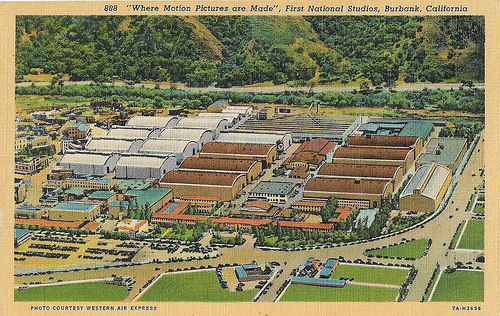
American postcard by Western Air Express, no. 888. Caption: 'Where Motion Pictures Are Made' An overview of the First National Pictures studio complex in the mid-/late 1920s.
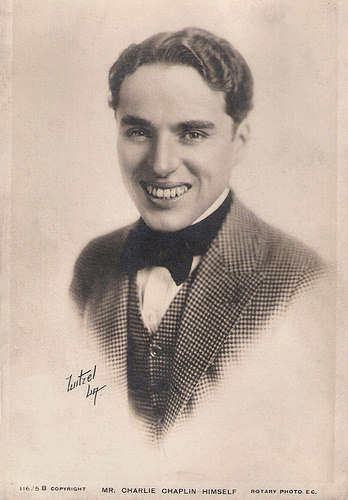
Charlie Chaplin . British postcard by Rotary Photo, no. 11575B. Photo: Albert Witzel.
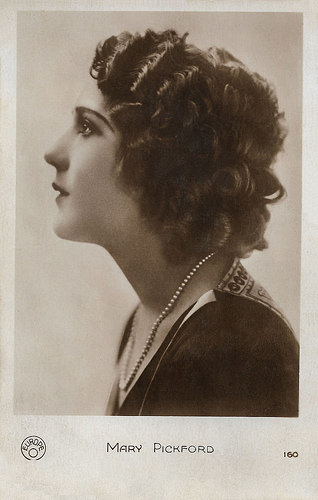
Mary Pickford. French postcard by Europe, no. 160.
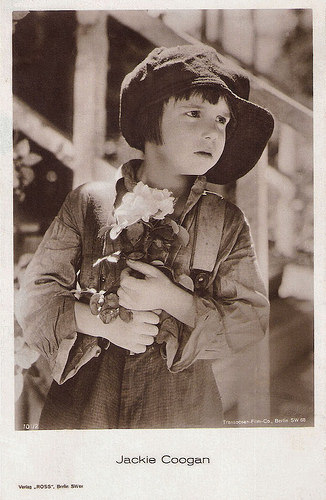
Jackie Coogan. German postcard by Ross Verlag, no. 701/2, 1925-1926. Photo: Transocean-Film-Company, Berlin.
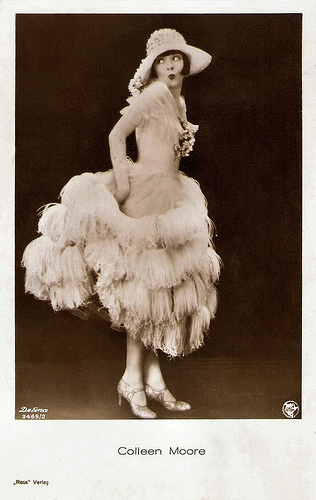
Colleen Moore. German postcard by Ross Verlag, no. 3469/2, 1928-1929. Photo: DeFina / First National Pictures.
Against high cost rentals, block-booking, and inferior prints
The First National Exhibitors' Circuit was founded in 1917 by the merger of 26 of the biggest first-run cinema chains in the United States. It eventually controlled over 600 cinemas, more than 200 of them first-run houses as opposed to the less lucrative second-run or neighbourhood theatres to which films moved when their initial box office receipts dwindled.
First National was the brainchild of Thomas L. Tally, who was reacting to the many problems exhibitors had experienced with established distributors, such as the high cost of rentals, block-booking, and the inferior quality of some prints. The exhibitors also wanted to bypass distributors such as Adolph Zukor's Paramount, which had begun to try to control all aspects of the film industry.
In 1912, Tally thought that a conglomerate of theatres throughout the nation could buy or produce and distribute its own films. In 1917 Tally and J. D. Williams formed First National Exhibitors' Circuit. The first film released through First National was the British film, The Mother of Dartmoor (George Loane Tucker, 1916).
A success was Tarzan of the Apes (Scott Sidney, 1918) starring Elmo Lincoln as the first screen Tarzan and based on Edgar Rice Burroughs' original novel Tarzan of the Apes. The film adapts only the first part of the novel, the remainder becoming the basis for the sequel, The Romance of Tarzan (Wilfred Lucas, 1918) starring Elmo Lincoln and Enid Markey.
Between 1917 and 1918, the company made contracts with Mary Pickford and Charlie Chaplin , the first million-dollar deals in the history of film. Daddy-Long-Legs (Marshall Neilan, 1919) was produced by Mary Pickford, and based on Jean Webster's novel Daddy-Long-Legs. A Dog's Life (Charles Chaplin, 1918) was Chaplin's first film for First National Films. Chaplin's contract allowed him to produce his films without a set release schedule.
However, the production of the feature film The Kid (Charles Chaplin, 1921) ran so long that the company started to complain. To address their concerns Chaplin invited the exhibitors to the studio, and they were so impressed by the project and charmed by the players, especially co-star Jackie Coogan, that they agreed to be patient. That patience was ultimately rewarded when The Kid became a major critical and box office success.
First National's distribution of films by independent producers is credited with launching careers including that of Louis B. Mayer. Mayer produced the Western In Old Kentucky (Marshall Neilan, 1919) starring Anita Stewart. Neilan and Mayer worked often together, but after Mayer became head of MGM in 1924, the two had a falling out.
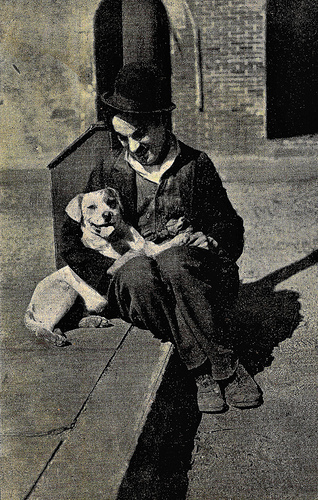
Charlie Chaplin . Spanish postcard by Chocolate Amatller, serie 9, no. 11. Photo: publicity still for A Dog's Life (Charles Chaplin, 1918).
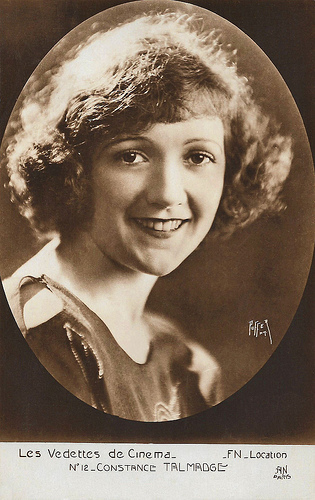
Constance Talmadge. French postcard by A.N., Paris in the Les Vedettes de Cinéma series, no. 12. Photo: B. Frank Puffer / First National Location.
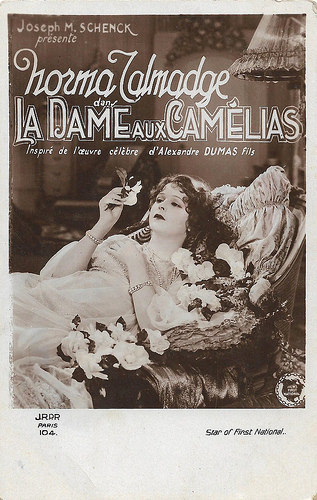
Norma Talmadge. French postcard by J.R.D.R., Paris, no. 104. Photo: First National. Publicity still for Camille (Fred Niblo, 1926), produced by Joseph Schenck, the later producer of United Artists, and based on the famous novel by Alexandre Dumas fils.
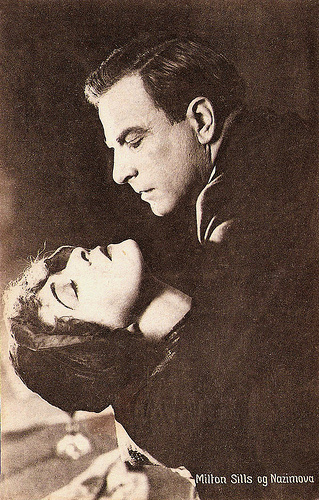
Nazimova and Milton Sills. Danish postcard by Stenders Kunstforlag, no. 39. Photo: First National Pictures. Publicity still for Madonna of the Streets (Edwin Carewe, 1924).
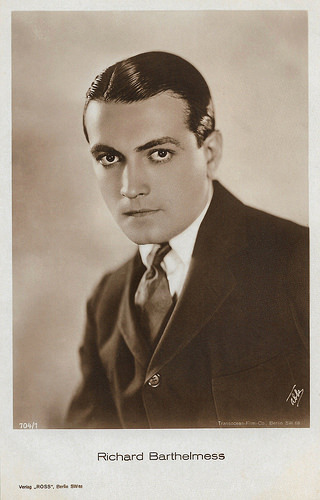
Richard Barthelmess. German postcard by Ross Verlag, no. 704/1, 1925-1926. Photo: James Abbe / Transocean-Film-Co., Berlin.
A rustic tale of violence set in the mountains of West Virginia
Adolph Zukor of Paramount Pictures was threatened by First National's financial power and its control over the lucrative first-run theatres, and decided to enter the cinema business as well. With a $10 million investment, Paramount built its own chain of first-run movie theatres after a secret plan to merge with First National failed.
First National Exhibitors' Circuit was reincorporated in 1919 as Associated First National Pictures, Inc., and its subsidiary, Associated First National Theatres, Inc., with 5,000 independent theatre owners as members. First National had new successes with Constance Talmadge in the comedy A Virtuous Vamp (David Kirkland, Sidney Franklin, 1919). It was produced by Talmadge and written by Anita Loos and John Emerson based on the 1909 play The Bachelor by Clyde Fitch. Anita Loos also wrote Two Weeks (Sidney Franklin, 1920), starring Constance Talmadge and Conway Tearle.
Sister Norma Talmadge starred in such dramas as A Daughter of Two Worlds (James Young, 1920), The Branded Woman (Albert Parker, 1920). The latter was also produced by Talmadge with her husband Joseph Schenck through their production company, Norma Talmadge Productions. Later followed such hits as Camille (Fred Niblo, 1926).
Director King Vidor also worked for First National, such as on the drama The Family Honor (King Vidor, 1920) with Florence Vidor. A major box office success was Tol'able David (Henry King, 1921) starring Richard Barthelmess. It was a rustic tale of violence set in the Allegheny Mountains of eastern West Virginia. The acclaimed film was voted the 1921 Photoplay Magazine Medal of Honor and is seen by now as one of the classics of silent film.
Associated First National Pictures expanded from only distributing films to producing them in 1924 and changed its corporate name to First National Pictures, Inc. It built its 62-acre (25 ha) studio lot in Burbank in 1926. The Motion Picture Theatre Owners of America and the Independent Producers' Association declared war in 1925 on what they termed a common enemy — the ‘film trust’ of Metro-Goldwyn-Mayer, Paramount, and First National, which they claimed dominated the industry not only by producing and distributing films but also by entering into exhibition as well.
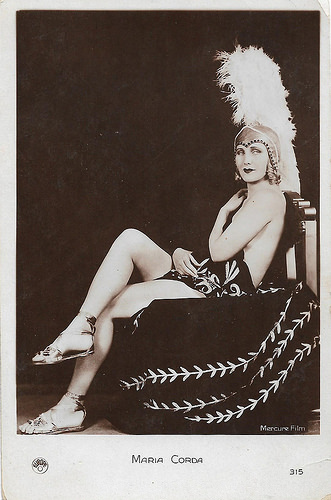
French postcard by Europe, no. 315. Photo: Mercure Film. Maria Corda as Helen of Troy in The Private Life of Helen of Troy (Alexander Korda, 1927).
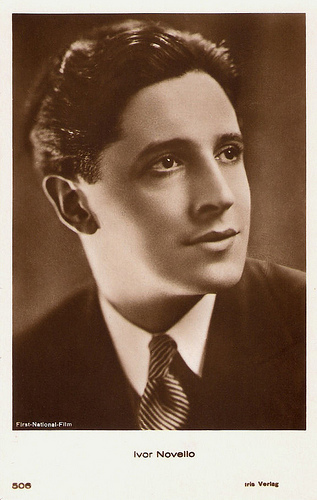
Ivor Novello . Austrian postcard by Iris Verlag, nr. 506. Photo: First National Film.
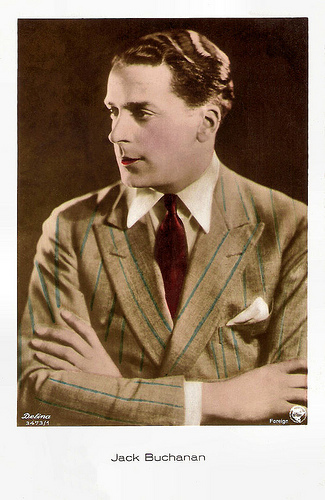
Jack Buchanan . British postcard in the real hand-coloured photograph series, no. 136. Photo: Defina / First National.
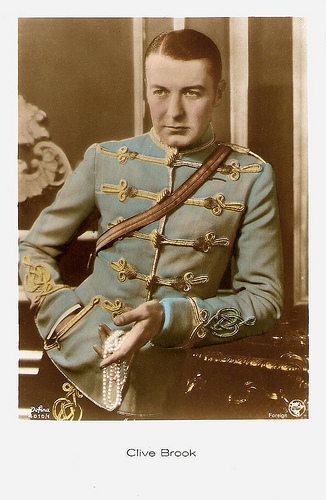
Clive Brook . British postcard, no. 4010/1. Photo: Defina / First National Pictures. Publicity still for Yellow Lily (Alexander Korda, 1928).
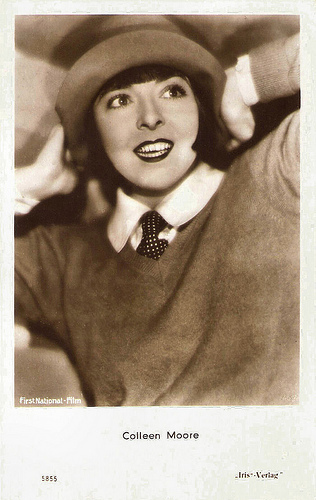
Colleen Moore. Austrian postcard by Iris-Verlag, no. 5855. Photo: First National-Film.
The Flapper - a new kind of female behaviour
Madge Bellamy became a star with Lorna Doone (Maurice Tourneur, 1922) a film version of Richard Doddridge Blackmore's often filmed novel. Another success was Oliver Twist (Frank Lloyd, 1922), a silent film adaptation of Charles Dickens' classic novel, featuring Lon Chaney as Fagin and Jackie Coogan at the height of his success as Oliver.
One of the major directors at First National was John M. Stahl who made such dramas The Dangerous Age (John M. Stahl, 1923) starring Lewis Stone. Another interesting director was Frank Borzage who directed the drama The Age of Desire (Frank Borzage, 1923) starring Josef Swickard, William Collier Jr., and Mary Philbin.
A popular success was Potash and Perlmutter (Clarence G. Badger, 1923), based on an ethnic Jewish comedy with characters created by Montague Glass and Charles Klein. This film was the first production of Samuel Goldwyn's independent production company. Stage stars Alexander Carr and Barney Bernard reprise their famous roles in this film. The film's success would inspire two Goldwyn sequels, In Hollywood with Potash and Perlmutter (Alfred E. Green, 1924) and Partners Again (Henry King, 1926), but the latter was distributed by United Artists.
Associated First National both distributed and produced the drama Flaming Youth (John Francis Dillon, 1923) starring vivid Colleen Moore and Milton Sills. The reaction to the film was enthusiastic, and it firmly fixed in the public's imagination a new kind of female behaviour. There had been several films prior to Flaming Youth which used the flapper as subject matter, such as The Flapper (Alan Crosland, 1920) with Olive Thomas, but the financial success of Flaming Youth made it the film credited with launching a cycle of pictures about flappers and helping Colleen Moore be seen as the original film flapper.
Blanche Sweet was the star of the silent film version of Anna Christie (John Griffith Wray, 1923) based on the 1921 play by Eugene O'Neill. Producer Thomas H. Ince paid a then-astronomical $35,000 for the screen rights to the play. Another success was the fantasy monster adventure film The Lost World (Harry O. Hoyt, 1925) adapted from Arthur Conan Doyle's 1912 novel of the same name. The film stars Wallace Beery as Professor Challenger and featured pioneering stop motion special effects by Willis O'Brien, a forerunner of his work on the original King Kong (1933).
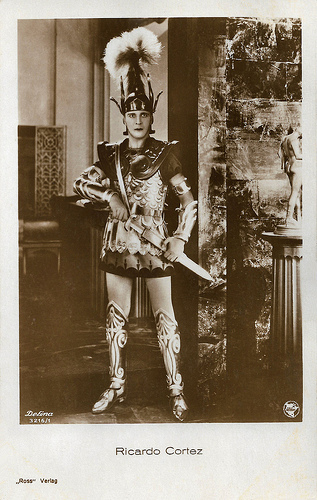
German postcard by Ross Verlag, no. 3216/1, 1928-1929. Photo: Defina / First national. Publicity still for The Private Life of Helen of Troy (Alexander Korda, 1927), in which Ricardo Cortez co-starred as Paris opposite Maria Corda as Helen of Troy.
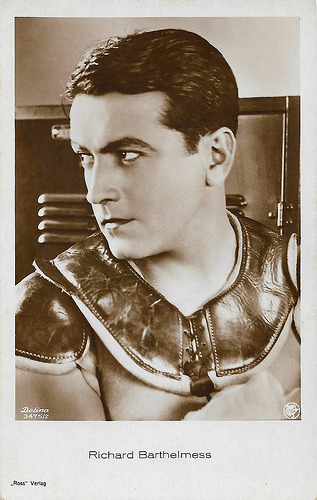
Richard Barthelmess. German postcard by Ross Verlag, no. 3475/2, 1928-1929. Photo: Defina / First National. Publicity still for The Drop-Kick (Millard Webb, 1927).
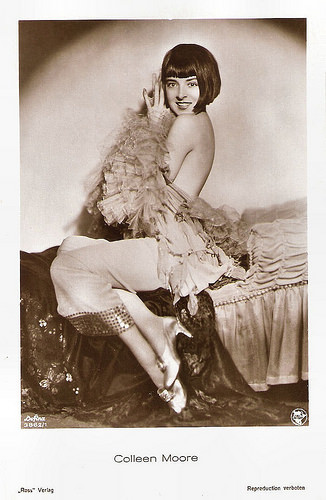
Colleen Moore. German postcard by Ross Verlag, no. 3862/1, 1928-1929. Photo: Defina / First-National-Film.
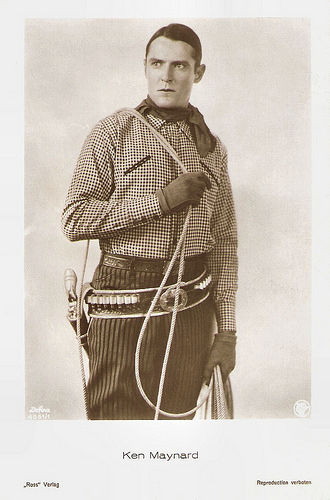
Ken Maynard. German postcard by Ross Verlag, no. 4561/1, 1929-1930. Photo: Defina / First National Pictures.
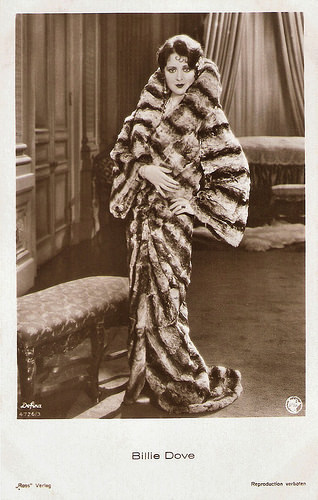
Billie Dove . German postcard by Ross Verlag, no. 4726/3, 1929-1930. Photo: Defina / First National.
The First National studio as the official home of Warner Bros
The financial success of The Jazz Singer (Alan Crosland, 1927) and The Singing Fool (Lloyd Bacon, 1928), both with Al Jolson, enabled Warner Bros. to purchase a majority interest in First National in September 1928. Warner Bros. held 42,000 shares of common stock out of 72,000 outstanding shares while Fox Pictures held 21,000 shares; 12,000 shares were publicly held.
Warner Bros. acquired access to First National's affiliated chain of theatres, while First National acquired access to Vitaphone sound equipment. Warner Bros. and First National continued to operate as separate entities. On November 4, 1929, Fox sold its interest in First National to Warner Bros. for $10 million.
The First National studio in Burbank became the official home of Warner Bros.–First National Pictures. Thereafter, First National Pictures became a trade name for the distribution of a designated segment of Warner Bros. product. Forty-five of the 86 Warner Bros. feature films released in 1929 were branded as First National Pictures. Half of the 60 feature films Warner Bros. announced for release in 1933–1934 were to be First National Pictures.
Although both studios produced A and B budget pictures, generally the prestige productions, costume dramas, and musicals were made by Warner Bros., while First National specialised in modern comedies, dramas, and crime stories. Short subjects were made by yet another affiliated company, The Vitaphone Corporation, which took its name from the sound process.
In July 1936, stockholders of First National Pictures, Inc. (primarily Warner Bros.) voted to dissolve the corporation and distribute its assets among the stockholders in line with a new tax law which provided for tax-free consolidations between corporations. From 1929 to 1958, most Warner Bros. films and promotional posters bore the combined trademark and copyright credits in the opening and closing sequences ‘A Warner Bros.–First National Picture’.
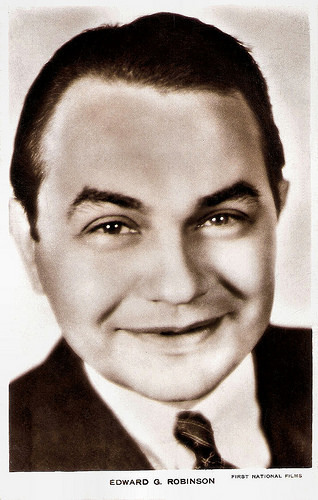
Edward G. Robinson . British postcard. Photo: First National Films.
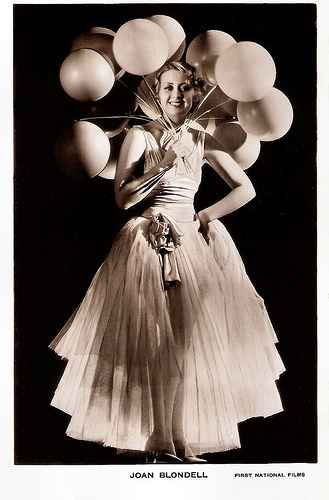
Joan Blondell. British postcard. Photo: First National Films.
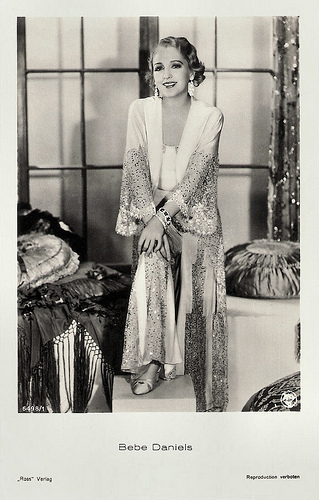
Bebe Daniels . German postcard by Ross Verlag, no. 6498/1, 1931-1932. Photo: First National Pictures. Publicity still for Honor of the Family (Lloyd Bacon, 1931).
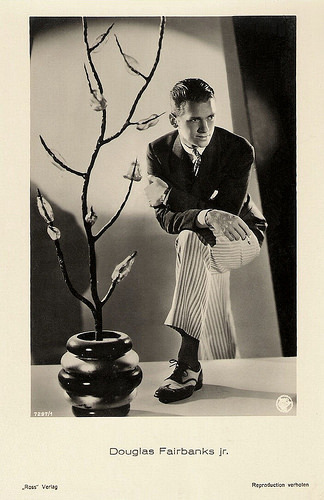
Douglas Fairbanks Jr . German postcard by Ross Verlag, no. 7297/1, 1932-1933. Photo: First National Pictures.
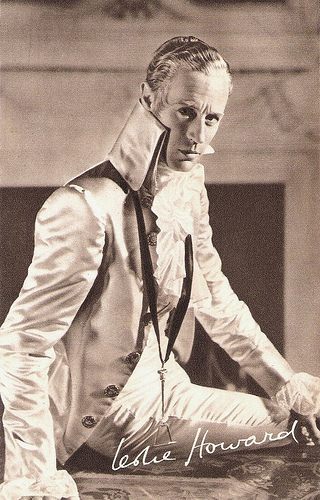
Leslie Howard . British postcard by Real Photogravure, London, no. 64. Photo: Warner Brothers / First National. Publicity still for The Scarlet Pimpernel (Harold Young, 1934).
Sources: Encyclopaedia Britannica, Oscars.org, and Wikipedia.

American postcard by Western Air Express, no. 888. Caption: 'Where Motion Pictures Are Made' An overview of the First National Pictures studio complex in the mid-/late 1920s.

Charlie Chaplin . British postcard by Rotary Photo, no. 11575B. Photo: Albert Witzel.

Mary Pickford. French postcard by Europe, no. 160.

Jackie Coogan. German postcard by Ross Verlag, no. 701/2, 1925-1926. Photo: Transocean-Film-Company, Berlin.

Colleen Moore. German postcard by Ross Verlag, no. 3469/2, 1928-1929. Photo: DeFina / First National Pictures.
Against high cost rentals, block-booking, and inferior prints
The First National Exhibitors' Circuit was founded in 1917 by the merger of 26 of the biggest first-run cinema chains in the United States. It eventually controlled over 600 cinemas, more than 200 of them first-run houses as opposed to the less lucrative second-run or neighbourhood theatres to which films moved when their initial box office receipts dwindled.
First National was the brainchild of Thomas L. Tally, who was reacting to the many problems exhibitors had experienced with established distributors, such as the high cost of rentals, block-booking, and the inferior quality of some prints. The exhibitors also wanted to bypass distributors such as Adolph Zukor's Paramount, which had begun to try to control all aspects of the film industry.
In 1912, Tally thought that a conglomerate of theatres throughout the nation could buy or produce and distribute its own films. In 1917 Tally and J. D. Williams formed First National Exhibitors' Circuit. The first film released through First National was the British film, The Mother of Dartmoor (George Loane Tucker, 1916).
A success was Tarzan of the Apes (Scott Sidney, 1918) starring Elmo Lincoln as the first screen Tarzan and based on Edgar Rice Burroughs' original novel Tarzan of the Apes. The film adapts only the first part of the novel, the remainder becoming the basis for the sequel, The Romance of Tarzan (Wilfred Lucas, 1918) starring Elmo Lincoln and Enid Markey.
Between 1917 and 1918, the company made contracts with Mary Pickford and Charlie Chaplin , the first million-dollar deals in the history of film. Daddy-Long-Legs (Marshall Neilan, 1919) was produced by Mary Pickford, and based on Jean Webster's novel Daddy-Long-Legs. A Dog's Life (Charles Chaplin, 1918) was Chaplin's first film for First National Films. Chaplin's contract allowed him to produce his films without a set release schedule.
However, the production of the feature film The Kid (Charles Chaplin, 1921) ran so long that the company started to complain. To address their concerns Chaplin invited the exhibitors to the studio, and they were so impressed by the project and charmed by the players, especially co-star Jackie Coogan, that they agreed to be patient. That patience was ultimately rewarded when The Kid became a major critical and box office success.
First National's distribution of films by independent producers is credited with launching careers including that of Louis B. Mayer. Mayer produced the Western In Old Kentucky (Marshall Neilan, 1919) starring Anita Stewart. Neilan and Mayer worked often together, but after Mayer became head of MGM in 1924, the two had a falling out.

Charlie Chaplin . Spanish postcard by Chocolate Amatller, serie 9, no. 11. Photo: publicity still for A Dog's Life (Charles Chaplin, 1918).

Constance Talmadge. French postcard by A.N., Paris in the Les Vedettes de Cinéma series, no. 12. Photo: B. Frank Puffer / First National Location.

Norma Talmadge. French postcard by J.R.D.R., Paris, no. 104. Photo: First National. Publicity still for Camille (Fred Niblo, 1926), produced by Joseph Schenck, the later producer of United Artists, and based on the famous novel by Alexandre Dumas fils.

Nazimova and Milton Sills. Danish postcard by Stenders Kunstforlag, no. 39. Photo: First National Pictures. Publicity still for Madonna of the Streets (Edwin Carewe, 1924).

Richard Barthelmess. German postcard by Ross Verlag, no. 704/1, 1925-1926. Photo: James Abbe / Transocean-Film-Co., Berlin.
A rustic tale of violence set in the mountains of West Virginia
Adolph Zukor of Paramount Pictures was threatened by First National's financial power and its control over the lucrative first-run theatres, and decided to enter the cinema business as well. With a $10 million investment, Paramount built its own chain of first-run movie theatres after a secret plan to merge with First National failed.
First National Exhibitors' Circuit was reincorporated in 1919 as Associated First National Pictures, Inc., and its subsidiary, Associated First National Theatres, Inc., with 5,000 independent theatre owners as members. First National had new successes with Constance Talmadge in the comedy A Virtuous Vamp (David Kirkland, Sidney Franklin, 1919). It was produced by Talmadge and written by Anita Loos and John Emerson based on the 1909 play The Bachelor by Clyde Fitch. Anita Loos also wrote Two Weeks (Sidney Franklin, 1920), starring Constance Talmadge and Conway Tearle.
Sister Norma Talmadge starred in such dramas as A Daughter of Two Worlds (James Young, 1920), The Branded Woman (Albert Parker, 1920). The latter was also produced by Talmadge with her husband Joseph Schenck through their production company, Norma Talmadge Productions. Later followed such hits as Camille (Fred Niblo, 1926).
Director King Vidor also worked for First National, such as on the drama The Family Honor (King Vidor, 1920) with Florence Vidor. A major box office success was Tol'able David (Henry King, 1921) starring Richard Barthelmess. It was a rustic tale of violence set in the Allegheny Mountains of eastern West Virginia. The acclaimed film was voted the 1921 Photoplay Magazine Medal of Honor and is seen by now as one of the classics of silent film.
Associated First National Pictures expanded from only distributing films to producing them in 1924 and changed its corporate name to First National Pictures, Inc. It built its 62-acre (25 ha) studio lot in Burbank in 1926. The Motion Picture Theatre Owners of America and the Independent Producers' Association declared war in 1925 on what they termed a common enemy — the ‘film trust’ of Metro-Goldwyn-Mayer, Paramount, and First National, which they claimed dominated the industry not only by producing and distributing films but also by entering into exhibition as well.

French postcard by Europe, no. 315. Photo: Mercure Film. Maria Corda as Helen of Troy in The Private Life of Helen of Troy (Alexander Korda, 1927).

Ivor Novello . Austrian postcard by Iris Verlag, nr. 506. Photo: First National Film.

Jack Buchanan . British postcard in the real hand-coloured photograph series, no. 136. Photo: Defina / First National.

Clive Brook . British postcard, no. 4010/1. Photo: Defina / First National Pictures. Publicity still for Yellow Lily (Alexander Korda, 1928).

Colleen Moore. Austrian postcard by Iris-Verlag, no. 5855. Photo: First National-Film.
The Flapper - a new kind of female behaviour
Madge Bellamy became a star with Lorna Doone (Maurice Tourneur, 1922) a film version of Richard Doddridge Blackmore's often filmed novel. Another success was Oliver Twist (Frank Lloyd, 1922), a silent film adaptation of Charles Dickens' classic novel, featuring Lon Chaney as Fagin and Jackie Coogan at the height of his success as Oliver.
One of the major directors at First National was John M. Stahl who made such dramas The Dangerous Age (John M. Stahl, 1923) starring Lewis Stone. Another interesting director was Frank Borzage who directed the drama The Age of Desire (Frank Borzage, 1923) starring Josef Swickard, William Collier Jr., and Mary Philbin.
A popular success was Potash and Perlmutter (Clarence G. Badger, 1923), based on an ethnic Jewish comedy with characters created by Montague Glass and Charles Klein. This film was the first production of Samuel Goldwyn's independent production company. Stage stars Alexander Carr and Barney Bernard reprise their famous roles in this film. The film's success would inspire two Goldwyn sequels, In Hollywood with Potash and Perlmutter (Alfred E. Green, 1924) and Partners Again (Henry King, 1926), but the latter was distributed by United Artists.
Associated First National both distributed and produced the drama Flaming Youth (John Francis Dillon, 1923) starring vivid Colleen Moore and Milton Sills. The reaction to the film was enthusiastic, and it firmly fixed in the public's imagination a new kind of female behaviour. There had been several films prior to Flaming Youth which used the flapper as subject matter, such as The Flapper (Alan Crosland, 1920) with Olive Thomas, but the financial success of Flaming Youth made it the film credited with launching a cycle of pictures about flappers and helping Colleen Moore be seen as the original film flapper.
Blanche Sweet was the star of the silent film version of Anna Christie (John Griffith Wray, 1923) based on the 1921 play by Eugene O'Neill. Producer Thomas H. Ince paid a then-astronomical $35,000 for the screen rights to the play. Another success was the fantasy monster adventure film The Lost World (Harry O. Hoyt, 1925) adapted from Arthur Conan Doyle's 1912 novel of the same name. The film stars Wallace Beery as Professor Challenger and featured pioneering stop motion special effects by Willis O'Brien, a forerunner of his work on the original King Kong (1933).

German postcard by Ross Verlag, no. 3216/1, 1928-1929. Photo: Defina / First national. Publicity still for The Private Life of Helen of Troy (Alexander Korda, 1927), in which Ricardo Cortez co-starred as Paris opposite Maria Corda as Helen of Troy.

Richard Barthelmess. German postcard by Ross Verlag, no. 3475/2, 1928-1929. Photo: Defina / First National. Publicity still for The Drop-Kick (Millard Webb, 1927).

Colleen Moore. German postcard by Ross Verlag, no. 3862/1, 1928-1929. Photo: Defina / First-National-Film.

Ken Maynard. German postcard by Ross Verlag, no. 4561/1, 1929-1930. Photo: Defina / First National Pictures.

Billie Dove . German postcard by Ross Verlag, no. 4726/3, 1929-1930. Photo: Defina / First National.
The First National studio as the official home of Warner Bros
The financial success of The Jazz Singer (Alan Crosland, 1927) and The Singing Fool (Lloyd Bacon, 1928), both with Al Jolson, enabled Warner Bros. to purchase a majority interest in First National in September 1928. Warner Bros. held 42,000 shares of common stock out of 72,000 outstanding shares while Fox Pictures held 21,000 shares; 12,000 shares were publicly held.
Warner Bros. acquired access to First National's affiliated chain of theatres, while First National acquired access to Vitaphone sound equipment. Warner Bros. and First National continued to operate as separate entities. On November 4, 1929, Fox sold its interest in First National to Warner Bros. for $10 million.
The First National studio in Burbank became the official home of Warner Bros.–First National Pictures. Thereafter, First National Pictures became a trade name for the distribution of a designated segment of Warner Bros. product. Forty-five of the 86 Warner Bros. feature films released in 1929 were branded as First National Pictures. Half of the 60 feature films Warner Bros. announced for release in 1933–1934 were to be First National Pictures.
Although both studios produced A and B budget pictures, generally the prestige productions, costume dramas, and musicals were made by Warner Bros., while First National specialised in modern comedies, dramas, and crime stories. Short subjects were made by yet another affiliated company, The Vitaphone Corporation, which took its name from the sound process.
In July 1936, stockholders of First National Pictures, Inc. (primarily Warner Bros.) voted to dissolve the corporation and distribute its assets among the stockholders in line with a new tax law which provided for tax-free consolidations between corporations. From 1929 to 1958, most Warner Bros. films and promotional posters bore the combined trademark and copyright credits in the opening and closing sequences ‘A Warner Bros.–First National Picture’.

Edward G. Robinson . British postcard. Photo: First National Films.

Joan Blondell. British postcard. Photo: First National Films.

Bebe Daniels . German postcard by Ross Verlag, no. 6498/1, 1931-1932. Photo: First National Pictures. Publicity still for Honor of the Family (Lloyd Bacon, 1931).

Douglas Fairbanks Jr . German postcard by Ross Verlag, no. 7297/1, 1932-1933. Photo: First National Pictures.

Leslie Howard . British postcard by Real Photogravure, London, no. 64. Photo: Warner Brothers / First National. Publicity still for The Scarlet Pimpernel (Harold Young, 1934).
Sources: Encyclopaedia Britannica, Oscars.org, and Wikipedia.
Published on December 14, 2018 22:00
December 13, 2018
Vera-Ellen
Blonde, slim Vera-Ellen (1921-1981) was one of the most vivacious and vibrant musical film talents to glide through Hollywood in the 1940s and 1950s. Whether performing solo or dueting with the best male partners of her generation, including Fred Astaire, Gene Kelly and Donald O'Connor, Vera-Ellen gave life to some of the most extraordinary dance routines ever caught on film. She was a dance sensation in a string of light-hearted but successful films. Vera-Ellen retired from acting in the late 1950s.
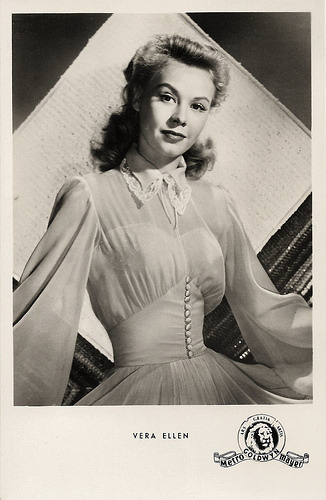
German postcard by Kunst und Bild, Berlin, no. A 320. Photo: Metro-Goldwyn-Mayer.
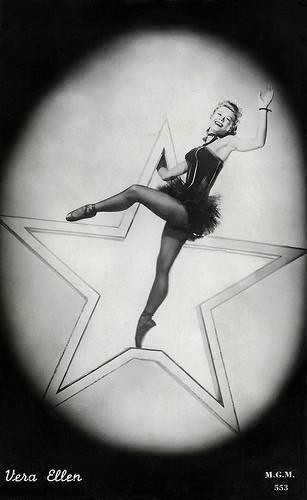
Dutch postcard, no. 553. Photo: M.G.M. (Metro-Goldwyn-Mayer). Publicity still for On the Town (Stanley Donen, Gene Kelly, 1949).
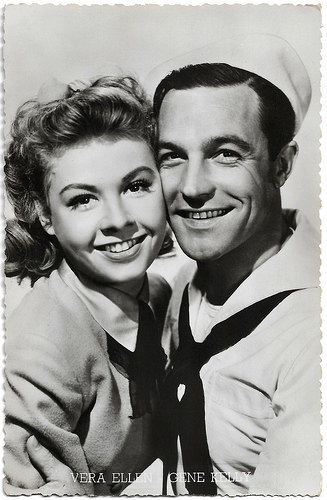
French postcard, no. 1. Photo: Metro-Goldwyn-Mayer. Publicity still for On the Town (Stanley Donen, Gene Kelly, 1949) with Gene Kelly.
Blessed with a sweet, apple blossom appeal and elfin charm
Vera-Ellen Westmeyer Rohe was born of German descent in Norwood, an enclave of the larger city of Cincinnati, Ohio in 1921. Vera-Ellen was the only child of Martin F. Rohe, a piano dealer, and Alma Catherine Westmeier. She was given a hyphen in her name because her mother had a dream when she was expecting that she would have a baby-girl named Vera-Ellen. Later, she told interviewer Gene Handsaker that she liked simple screen monikers like Margo and Annabella and refused to adopt a synthetic last name for the cinema.
Some sources incorrectly indicate that she was born in 1926. Gary Brumburgh explains at IMDb : "Blessed with a sweet, apple blossom appeal and elfin charm, Vera-Ellen's movie career started to take shape in 1945. Supposedly her mother thought that since her daughter looked much younger than she was, it might be wise to shave five years off of her age in order to promote the dancing teen sensation image."
Vera-Ellen began dancing at the age of 9 (some sources say 10). She was rather frail and studied dancing to build up her body. At age 13 she was a winner on the Major Bowes Amateur Hour and embarked upon a professional career.
At age 18, Vera-Ellen made her Broadway debut with the Jerome Kern/Oscar Hammerstein musical Very Warm for May in 1939. She toured with the Ted Lewis Band and became one of the youngest Rockettes at Radio City Music Hall. Vera-Ellen eventually broke into Broadway musicals, dancing with Ray Bolger in By Jupiter (1942) and in the revival of A Connecticut Yankee (1943).
She was only 24 years old when she was spotted by film producer Samuel Goldwyn who cast her in Wonder Man (H. Bruce Humberstone, 1945) opposite Danny Kaye in his film debut. Wonder Man (1945) and another Danny Kaye vehicle, The Kid from Brooklyn (Norman Z. McLeod, 1946), were both hits and people soon fell in love with the lovely lady's fresh-faced innocence.
A hard-working, uncomplicated talent, she paired famously with Gene Kelly in MGM's Words and Music (Norman Taurog, 1948) in which their 'Slaughter on Tenth Avenue' number was a critical highlight. The landmark musical On the Town (Stanley Donen, Gene Kelly, 1949), in which she played Miss Turnstiles and the apple of Kelly's eye, served as the pinnacle of her dancing work on film.
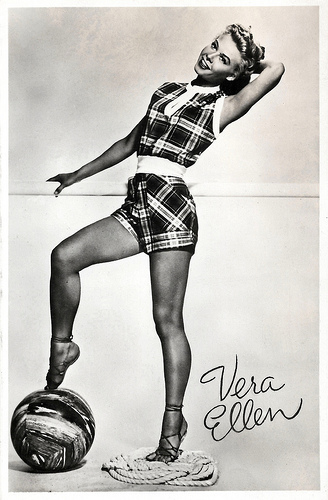
Dutch postcard by DRC, no. F 167 Photo: M.G.M. (Metro-Goldwyn-Mayer).
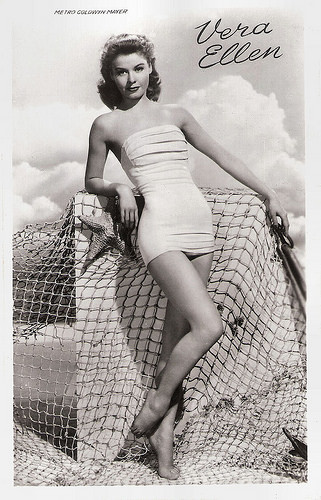
Dutch card. Photo: Metro-Goldwyn-Mayer.
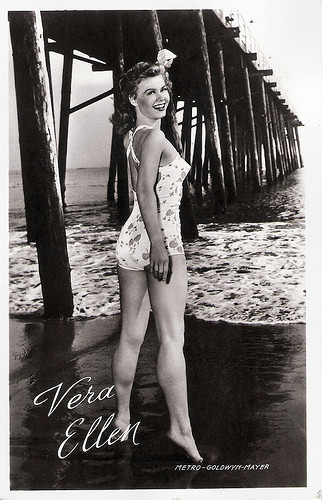
Dutch postcard, no. AX 232. Sent by mail in 1952. Photo: Metro-Goldwyn-Mayer.
The woman of a thousand dance moves
The versatile and acrobatic Vera-Ellen could be counted on to perform any kind of dancing requested - tap, toe, jazz, adagio - whether solo or with partners and/or props. She became the woman of a thousand dance moves. Her light singing voice, however, was usually dubbed.
According to Hal Erickson at AllMovie : "In a moment of weakness, Vera-Ellen agreed to co-star in the Marx Brothers' valedictory film Love Happy (David Miller, 1949), where she was 'rewarded' with some of her worst-ever costumes and camera angles."
Vera Ellen went on to appear twice with Fred Astaire, in Three Little Words (Richard Thorpe, 1950) and The Belle of New York (Charles Walters, 1952), both example of MGM's musical unit at the height of its powers. She also shared dance steps with the Donald O'Connor in Call Me Madam (Walter Lang, 1953). Craig Butler at AllMovie : "O'Connor is a delight throughout, as is Vera Ellen as his love interest. Their duets, 'It's a Lovely Day Today' and 'Something to Dance About', are highlights."
The blockbuster and evergreen White Christmas (Michael Curtiz, 1954) is usually considered her best-remembered film in which she co-starred with Bing Crosby, Danny Kaye and Rosemary Clooney. Craig Butler: "Considering the amount of talent involved, it's surprising - and rather a shame - that White Christmas is only an enjoyable little trifle rather than a truly classic movie musical. (...) But pay special attention to Clooney's creamy, entrancing rendition of the beautiful 'Love, You Didn't Do Right by Me'; this is a genuinely superior musical performance. Throw in such other treats as 'Blue Skies' and 'Count Your Blessings Instead of Sheep', as well as the amusing antics of Kaye, the laid-back playing of Crosby, and the effervescent dancing of Vera-Ellen, and most people will be more than willing to sit through the corny script."
Gary Brumbrugh at IMDb : "Musicals went out of vogue by the late 50s and, as Vera-Ellen was practically synonymous with musicals, her career went into a sharp decline. But that was only one reason. A light acting talent, she might have continued in films in dramatic roles, as she had in the movie Big Leaguer (Robert Aldrich, 1953) with Edward G. Robinson, but dark, outside influences steered her away altogether. Personal unhappiness and ill health would quickly take their toll on her."
Vera's film career ended with the British musical Let's Be Happy (Henry Levin, 1957) co-starring Tony Martin. It was an updated remake of Jeannie (Harold French, 1941), one of the most likable British comedies of the 1940s.
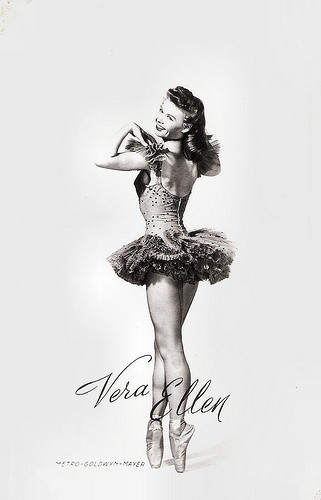
Dutch postcard, no. ax 240-157. Photo: Metro-Goldwyn-Mayer.
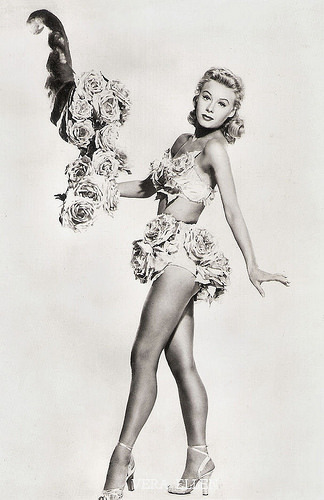
Belgian postcard, no. 752. Photo: Metro-Goldwyn-Mayer.
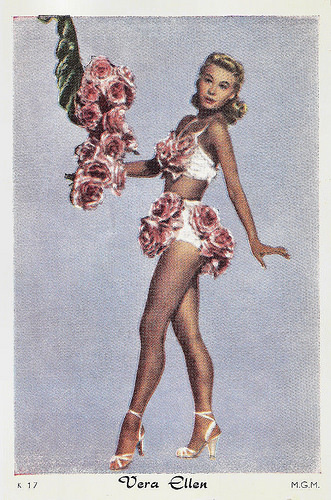
Vintage collectors card, no. K 17. Photo: Metro-Goldwyn-Mayer.
A lithe and lovely presence who deserved a better personal life
On TV Vera-Ellen appeared in variety shows such as The Colgate Comedy Hour, and The Dinah Shore Chevvy Show. She also starred in the successful 1955 Las Vegas dancing revue.
It was later discovered that, due to the dancer's compulsive dieting obsession, she had silently battled anorexia throughout much of the 1950s before anyone was even aware or doctors had even coined the term or devised treatments. Moreover, she had developed severe arthritis which forced an early retirement.
In order to combat it, she reverted back to taking dance lessons again. The worst blows suffered, however, was in her personal life. Her two marriages failed. Her first husband was a fellow dancer, Robert Hightower, to whom she was married from 1941 to 1946. Her second husband was millionaire oil-man Victor Rothschild of the Rothschild family. They were married from 1954 to their 1966 divorce.
While married to Rothschild, she gave birth to a daughter, Victoria Ellen, who died at three months of age from Sudden Infant Death Syndrome (SIDS) in 1963. Following the death of her only child, she withdrew from public life and became a virtual recluse in her house in the Hollywood Hills.
Little was heard for decades until she had died at the University of California at Los Angeles Medical Center in 1981, of cancer. She was 60 years old. Author David Soren wrote a book, Vera-Ellen: the Magic and the Mystery, about her life.
Gary Brumburgh: "Perhaps less remembered today compared to several of the big stars that shared the stage with her, Vera-Ellen was a lithe and lovely presence who deserved a better personal life than she got. Nevertheless, she has provided true film lovers with a lasting legacy and can easily be considered one of Hollywood's finest dancing legends."
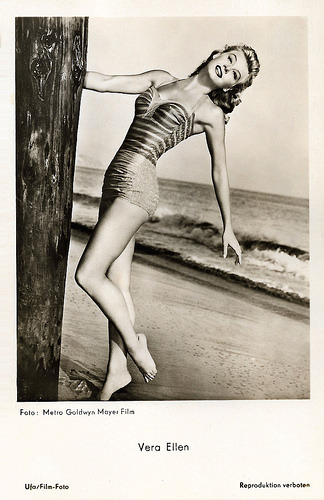
German postcard by Ufa/Film-Foto, Berlin-Tempelhof, no. FK 975. Photo: Metro-Goldwyn-Mayer.
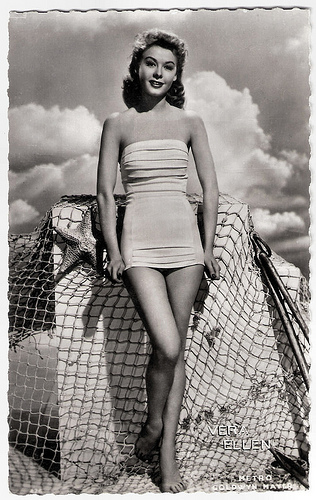
French postcard by Edition P.I., Paris, offered by Les Carbones Korès Carboplane, no. 26F, 1953. Photo: Metro-Goldwyn-Mayer.
Sources: (IMDb), (IMDb), Hal Erickson (AllMovie), Craig Butler (AllMovie), Gene Handsaker (Altoona Tribune), Kit and Morgan Benson (Find A Grave), New York Times, Wikipedia and .

German postcard by Kunst und Bild, Berlin, no. A 320. Photo: Metro-Goldwyn-Mayer.

Dutch postcard, no. 553. Photo: M.G.M. (Metro-Goldwyn-Mayer). Publicity still for On the Town (Stanley Donen, Gene Kelly, 1949).

French postcard, no. 1. Photo: Metro-Goldwyn-Mayer. Publicity still for On the Town (Stanley Donen, Gene Kelly, 1949) with Gene Kelly.
Blessed with a sweet, apple blossom appeal and elfin charm
Vera-Ellen Westmeyer Rohe was born of German descent in Norwood, an enclave of the larger city of Cincinnati, Ohio in 1921. Vera-Ellen was the only child of Martin F. Rohe, a piano dealer, and Alma Catherine Westmeier. She was given a hyphen in her name because her mother had a dream when she was expecting that she would have a baby-girl named Vera-Ellen. Later, she told interviewer Gene Handsaker that she liked simple screen monikers like Margo and Annabella and refused to adopt a synthetic last name for the cinema.
Some sources incorrectly indicate that she was born in 1926. Gary Brumburgh explains at IMDb : "Blessed with a sweet, apple blossom appeal and elfin charm, Vera-Ellen's movie career started to take shape in 1945. Supposedly her mother thought that since her daughter looked much younger than she was, it might be wise to shave five years off of her age in order to promote the dancing teen sensation image."
Vera-Ellen began dancing at the age of 9 (some sources say 10). She was rather frail and studied dancing to build up her body. At age 13 she was a winner on the Major Bowes Amateur Hour and embarked upon a professional career.
At age 18, Vera-Ellen made her Broadway debut with the Jerome Kern/Oscar Hammerstein musical Very Warm for May in 1939. She toured with the Ted Lewis Band and became one of the youngest Rockettes at Radio City Music Hall. Vera-Ellen eventually broke into Broadway musicals, dancing with Ray Bolger in By Jupiter (1942) and in the revival of A Connecticut Yankee (1943).
She was only 24 years old when she was spotted by film producer Samuel Goldwyn who cast her in Wonder Man (H. Bruce Humberstone, 1945) opposite Danny Kaye in his film debut. Wonder Man (1945) and another Danny Kaye vehicle, The Kid from Brooklyn (Norman Z. McLeod, 1946), were both hits and people soon fell in love with the lovely lady's fresh-faced innocence.
A hard-working, uncomplicated talent, she paired famously with Gene Kelly in MGM's Words and Music (Norman Taurog, 1948) in which their 'Slaughter on Tenth Avenue' number was a critical highlight. The landmark musical On the Town (Stanley Donen, Gene Kelly, 1949), in which she played Miss Turnstiles and the apple of Kelly's eye, served as the pinnacle of her dancing work on film.

Dutch postcard by DRC, no. F 167 Photo: M.G.M. (Metro-Goldwyn-Mayer).

Dutch card. Photo: Metro-Goldwyn-Mayer.

Dutch postcard, no. AX 232. Sent by mail in 1952. Photo: Metro-Goldwyn-Mayer.
The woman of a thousand dance moves
The versatile and acrobatic Vera-Ellen could be counted on to perform any kind of dancing requested - tap, toe, jazz, adagio - whether solo or with partners and/or props. She became the woman of a thousand dance moves. Her light singing voice, however, was usually dubbed.
According to Hal Erickson at AllMovie : "In a moment of weakness, Vera-Ellen agreed to co-star in the Marx Brothers' valedictory film Love Happy (David Miller, 1949), where she was 'rewarded' with some of her worst-ever costumes and camera angles."
Vera Ellen went on to appear twice with Fred Astaire, in Three Little Words (Richard Thorpe, 1950) and The Belle of New York (Charles Walters, 1952), both example of MGM's musical unit at the height of its powers. She also shared dance steps with the Donald O'Connor in Call Me Madam (Walter Lang, 1953). Craig Butler at AllMovie : "O'Connor is a delight throughout, as is Vera Ellen as his love interest. Their duets, 'It's a Lovely Day Today' and 'Something to Dance About', are highlights."
The blockbuster and evergreen White Christmas (Michael Curtiz, 1954) is usually considered her best-remembered film in which she co-starred with Bing Crosby, Danny Kaye and Rosemary Clooney. Craig Butler: "Considering the amount of talent involved, it's surprising - and rather a shame - that White Christmas is only an enjoyable little trifle rather than a truly classic movie musical. (...) But pay special attention to Clooney's creamy, entrancing rendition of the beautiful 'Love, You Didn't Do Right by Me'; this is a genuinely superior musical performance. Throw in such other treats as 'Blue Skies' and 'Count Your Blessings Instead of Sheep', as well as the amusing antics of Kaye, the laid-back playing of Crosby, and the effervescent dancing of Vera-Ellen, and most people will be more than willing to sit through the corny script."
Gary Brumbrugh at IMDb : "Musicals went out of vogue by the late 50s and, as Vera-Ellen was practically synonymous with musicals, her career went into a sharp decline. But that was only one reason. A light acting talent, she might have continued in films in dramatic roles, as she had in the movie Big Leaguer (Robert Aldrich, 1953) with Edward G. Robinson, but dark, outside influences steered her away altogether. Personal unhappiness and ill health would quickly take their toll on her."
Vera's film career ended with the British musical Let's Be Happy (Henry Levin, 1957) co-starring Tony Martin. It was an updated remake of Jeannie (Harold French, 1941), one of the most likable British comedies of the 1940s.

Dutch postcard, no. ax 240-157. Photo: Metro-Goldwyn-Mayer.

Belgian postcard, no. 752. Photo: Metro-Goldwyn-Mayer.

Vintage collectors card, no. K 17. Photo: Metro-Goldwyn-Mayer.
A lithe and lovely presence who deserved a better personal life
On TV Vera-Ellen appeared in variety shows such as The Colgate Comedy Hour, and The Dinah Shore Chevvy Show. She also starred in the successful 1955 Las Vegas dancing revue.
It was later discovered that, due to the dancer's compulsive dieting obsession, she had silently battled anorexia throughout much of the 1950s before anyone was even aware or doctors had even coined the term or devised treatments. Moreover, she had developed severe arthritis which forced an early retirement.
In order to combat it, she reverted back to taking dance lessons again. The worst blows suffered, however, was in her personal life. Her two marriages failed. Her first husband was a fellow dancer, Robert Hightower, to whom she was married from 1941 to 1946. Her second husband was millionaire oil-man Victor Rothschild of the Rothschild family. They were married from 1954 to their 1966 divorce.
While married to Rothschild, she gave birth to a daughter, Victoria Ellen, who died at three months of age from Sudden Infant Death Syndrome (SIDS) in 1963. Following the death of her only child, she withdrew from public life and became a virtual recluse in her house in the Hollywood Hills.
Little was heard for decades until she had died at the University of California at Los Angeles Medical Center in 1981, of cancer. She was 60 years old. Author David Soren wrote a book, Vera-Ellen: the Magic and the Mystery, about her life.
Gary Brumburgh: "Perhaps less remembered today compared to several of the big stars that shared the stage with her, Vera-Ellen was a lithe and lovely presence who deserved a better personal life than she got. Nevertheless, she has provided true film lovers with a lasting legacy and can easily be considered one of Hollywood's finest dancing legends."

German postcard by Ufa/Film-Foto, Berlin-Tempelhof, no. FK 975. Photo: Metro-Goldwyn-Mayer.

French postcard by Edition P.I., Paris, offered by Les Carbones Korès Carboplane, no. 26F, 1953. Photo: Metro-Goldwyn-Mayer.
Sources: (IMDb), (IMDb), Hal Erickson (AllMovie), Craig Butler (AllMovie), Gene Handsaker (Altoona Tribune), Kit and Morgan Benson (Find A Grave), New York Times, Wikipedia and .
Published on December 13, 2018 22:00
December 12, 2018
Cleopatra (1963)
The American historical drama Cleopatra (Joseph L. Mankiewicz, 1963) chronicles the struggles of Cleopatra, the young Queen of Egypt, to resist the imperial ambitions of Rome. It achieved notoriety for its massive cost overruns and production troubles, which included changes in director and cast, a change of filming locale, sets that had to be constructed twice, lack of a firm shooting script, and personal scandal around co-stars Elizabeth Taylor and Richard Burton.
Cleopatra
almost bankrupted 20th Century Fox, but was also the highest-grossing film of 1963, and it won four Academy Awards, and was nominated for five more, including Best Picture.
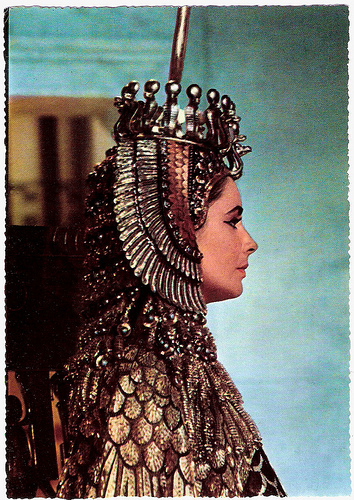
Elizabeth Taylor . Belgian postcard by SB (Uitgeverij Best), Antwerpen (Antwerp). Photo: still for Cleopatra (Joseph L. Mankiewicz, 1963).
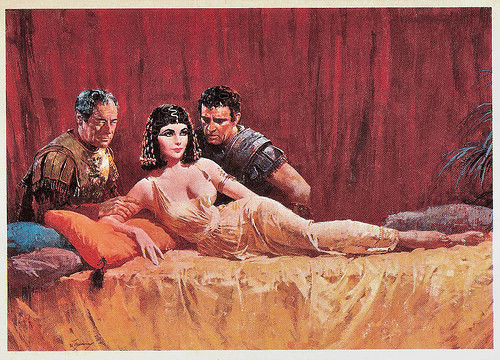
Rex Harrison , Elizabeth Taylor and Richard Burton . Vintage postcard. Image: poster art work for Cleopatra (Joseph l. Mankiewicz, 1963).
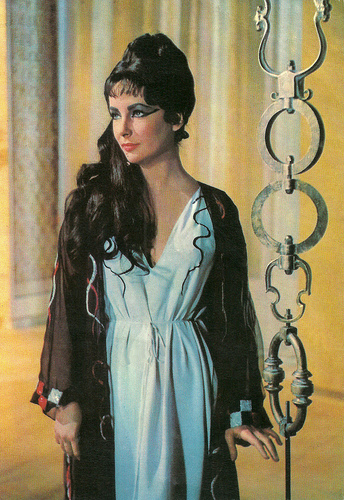
German postcard by ISV, no. A.104. Photo: 20th Century Fox. Elizabeth Taylor in the epic Cleopatra (Joseph Manckiewcz, 1963).
The triumph and tragedy of a legendary queen
Cleopatra (Joseph Mankiewcz, 1963) was based on a screenplay adapted by Mankiewicz, Ranald MacDougall and Sidney Buchman from a book by Carlo Maria Franzero. It tells the story of the legendary Queen Cleopatra VII of Egypt ( Elizabeth Taylor ), who experiences both triumph and tragedy as she attempts to resist the imperial ambitions of Rome.
In 48 B.C., Julius Caesar ( Rex Harrison ) has beaten Pompey the Great in a brutal civil war for control of the Roman Republic and pursues Pompey from Pharsalia to Egypt. Caesar learns that Pompey has fled to neutral Egypt, hoping to enlist the support of the young teenage Pharaoh Ptolemy XIII (Richard O'Sullivan).
Ptolemy, now supreme ruler of Egypt after deposing his older sister, Cleopatra, attempts to gain favour with Caesar by presenting the conqueror with the head of Pompey, borne by his governors, Pothinos (Grégoire Aslan) and Achillas (John Doucette). Caesar is not pleased. For him, it is a sorry end for a worthy foe.
To win Caesar's support from her brother, the young Cleopatra hides herself in a rug, which her servant Apollodorus (Cesare Danova), disguised as a rug peddler, presents to Caesar as a gift from Cleopatra. When a suspicious Caesar unrolls the rug, he finds Cleopatra herself concealed within. The Roman is immediately infatuated; banishing Ptolemy, he declares Cleopatra Egypt's sole ruler and takes her as his mistress.
The ambitious Cleopatra uses her charms to manipulate Caesar and to establish her authority. A year later, she bears him the son he never had, Caesarion, and strives that their son will take his rightful place in Rome. Cleopatra can almost taste Egypt's long-awaited union with Rome, and the formation of a mighty empire. Caesar, however, must return to Italy for his triumph.
Two years pass before the two see each other again. After he is made dictator for life, Caesar sends for Cleopatra. She arrives in Rome in a lavish procession and wins the adulation of the Roman people. On the Ides of March in 44 B.C., the Senate is preparing to vote on whether to award Caesar additional powers for the Republic. Despite warnings from his wife Calpurnia (Gwen Watford) and Cleopatra, he is confident of victory. However, he is stabbed to death by various senators. Octavian (Roddy McDowall), Caesar's nephew, is named as his heir, not Caesarion. Cleopatra returns home to Egypt leaving Rome in turmoil.
Two years later in 42 B.C., Caesar's assassins, among them Cassius (John Hoyt) and Brutus (Kenneth Haigh), are killed at the Battle of Philippi. The powerful Roman general Marc Antony ( Richard Burton ) establishes a Second Triumvirate government with Octavian and Lepidus. Antony will take control of the eastern provinces including Asia Minor and Syria. In 38 B.C., when Mark Antony, Caesar's protege, beholds the beautiful Cleopatra aboard her elaborate barge at Tarsus, he is smitten and becomes both her lover and military ally.
Octavian uses their affair in his smear campaign against Antony. When Antony returns to Rome to address the situation brewing there, Octavian traps him into a marriage of state to Octavian's sister, Octavia (Jean Marsh). The marriage satisfies no one. Cleopatra is infuriated. Antony, tiring of his Roman wife, soon returns to Egypt and divorces Octavia. IN Egypt, he marries Cleopatra in a public ceremony. It leads the two lovers to a personal and political demise.
Shocked and insulted, the Senators who had previously stood by Antony abandon their hero and vote for war. Octavian murders the Egyptian ambassador, Cleopatra's tutor Sosigenes (Hume Cronyn), on the Senate steps. Sensing Antony's weakness, Octavian attacks and defeats his forces at Actium in 31 B.C. Alarmed, Cleopatra withdraws her fleet and seeks refuge in her tomb. Realising Anthony and her son are death, she arranges to be bitten by a poisonous asp.
In the final shot, Octavian and Agrippa enter Cleopatra's temple afterwords to see her dead, dressed in a gold funeral robe with her two handmaidens, also bitten by the same venomous snake that Cleopatra allowed herself to get bitten, dying by her side. Octavian also finds a last letter from Cleopatra requesting to be buried with Marc Antony.
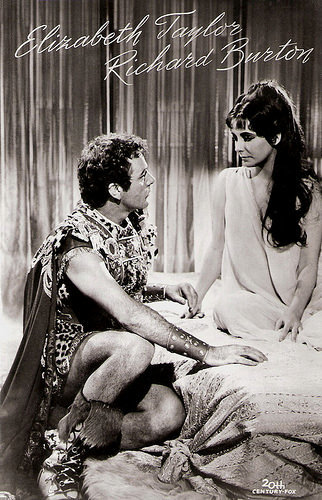
Richard Burton and Elizabeth Taylor . German postcard by Filmbilder-Vertrieb Ernst Freihoff, Essen, no. AX 5536. Photo: publicity still for Cleopatra (Joseph L. Mankiewicz, 1963).
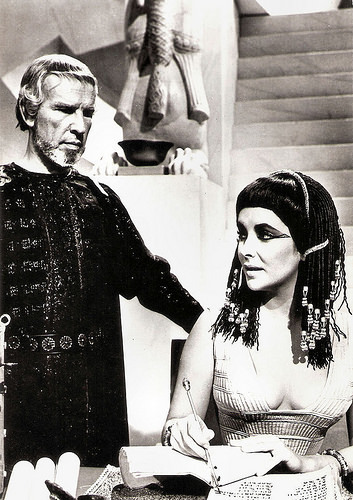
Elizabeth Taylor and Hume Cronyn. Czech postcard by UPF, Praha / Press Photo. Photo: publicity still for Cleopatra (Joseph L. Mankiewicz, 1963).
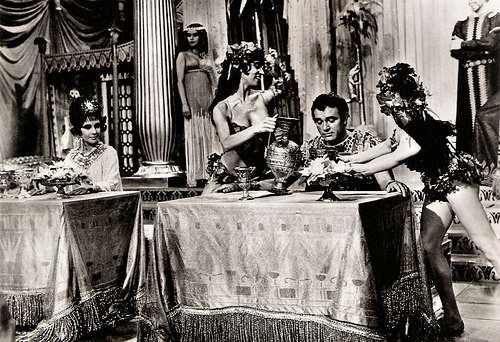
Richard Burton and Elizabeth Taylor . Czech postcard by UPTF Pressfoto, Praha (Prague), no. S 206/7. Photo: publicity still for Cleopatra (Joseph L. Mankiewicz, 1963).
The most expensive film ever made
As the story of Cleopatra had proved a hit for silent-screen legend Theda Bara with Cleopatra (J. Gordon Edwards, 1917), and for Claudette Colbert with Cleopatra (Cecil B. De Mille, 1934), 20th Century Fox executives hired veteran Hollywood producer Walter Wanger in 1958 to shepherd a new remake into production. Although the studio originally sought a relatively cheap production of $2 million, Wanger envisioned a much more opulent epic, and in mid-1959 successfully negotiated a higher budget of $5 million.
Rouben Mamoulian was assigned to direct and Elizabeth Taylor was awarded a record-setting contract of $1 million. Filming began in England but in January 1961 Taylor became so ill that production was shut down. Sixteen weeks of production and costs of $7 million had produced just ten minutes of film. Fox was reimbursed by the insurance company and Mamoulian was fired.
Joseph L. Mankiewicz was brought on to the production after Mamoulian's departure and the set moved to Cinecittà, outside of Rome. Peter Finch and Stephen Boyd left the production owing to other commitments and were replaced by Rex Harrison and Richard Burton .
During filming, Taylor met Richard Burton and the two began an adulterous affair. The scandal made headlines worldwide, since both were married to others, and brought bad publicity to the already troubled production. Mankiewicz was later fired during the editing phase, only to be rehired to reshoot the opening battle scenes in Spain.
The cut of the film which Mankiewicz screened for the studio was six hours long. This was cut to four hours for its initial premiere, but the studio demanded (over the objections of Mankiewicz) that the film be cut once more, this time to just barely over three hours to allow theatres to increase the number of showings per day. Mankiewicz unsuccessfully attempted to convince the studio to split the film in two in order to preserve the original cut. These were to be released separately as Caesar and Cleopatra followed by Antony and Cleopatra.
Cleopatra ended up costing $31 million, making it the most expensive film ever made at the time, and almost bankrupted 20th Century Fox. It was also the highest-grossing film of 1963, earning box-office of $57.7 million in the United States (equivalent to $461 million now), yet lost money due to its production and marketing costs of $44 million (equivalent to $352 million now), making it the only film ever to be the highest-grossing film of the year to run at a loss. Cleopatra later won four Academy Awards, and was nominated for five more, including Best Picture which it lost to the British adventure-comedy Tom Jones (Tony Richardson, 1963).
On 21 May 2013, the restored film was shown at a special screening at the 2013 Cannes Film Festival, to commemorate its 50th anniversary. It was later released as a 50th-anniversary version available on DVD and Blu-ray. Unfortunately Fox had long ago destroyed all of the trims and outs from negatives to save costs, preventing the release of traditional outtakes.
Derek Armstrong at All Movie : "Cleopatra is an interesting study in contradictions, as both a dud that won five Oscars and a lavish production that wastes most of its time on scenes of talking heads. Unfortunately, it's also not a 246-minute movie that breezes by; any modern viewer brave enough to sit through its four hours will feel the passage of every minute, with little ultimate reward for the time spent. The leads all acquit themselves admirably, especially Rex Harrison as Caesar, but viewers better acquainted with these characters through Shakespeare's lyrical language will lament the all-too-ordinary and sometimes anachronistic dialogue that comprises Joseph L. Mankiewicz's film. Elizabeth Taylor shines like the star she was, jumping in and out of dozens of ornate costumes, many of which hug her figure tightly, in a way that was provocative at the time. But she's a little too petulant and melodramatic to ultimately be taken seriously."
D.B DuMonteil at IMDb calls the film a 'visual poem, a feast for the eye and for the mind': "it was one of the most underrated Hollywood epics. First of all,it's only partially an epic: most of the scenes are intimate,generally two characters who are constantly tearing each other apart. Joseph L. Mankiewicz, one of the most intelligent director of his time, rewrote the dialogue during the shooting, night after night, and the results are stunning, considering the difficulties he encountered with his budget and his stars. Cleopatra's dream is perfectly recreated, much better than in De Mille's version."
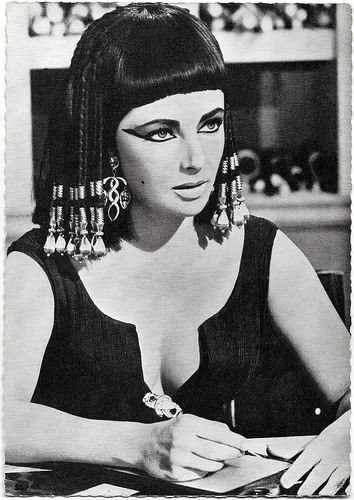
Elizabeth Taylor . German postcard by Filmbilder-Vertrieb Ernst Freihoff, Essen, no. 824. Photo: Cleopatra / Centfox. Publicity still for Cleopatra (Joseph L. Mankiewicz, 1963).
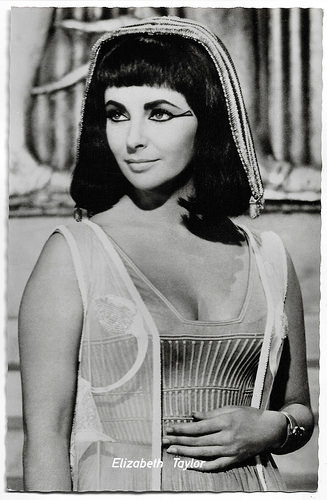
German postcard by Kolibri-Verlag, Minden/Westf., no. 1657. Photo: Centfox. Publicity still for Cleopatra (Joseph L. Mankiewicz, 1963).
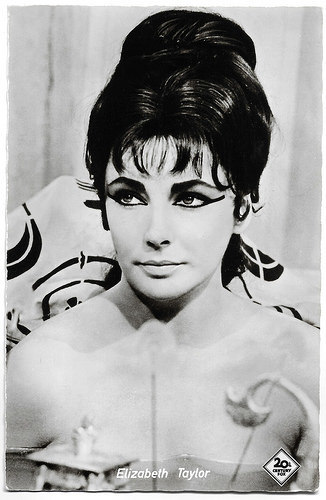
German postcard by Kolibri-Verlag, Minden/Westf., no. 1866. Photo: Centfox. Publicity still for Cleopatra (Joseph L. Mankiewicz, 1963).
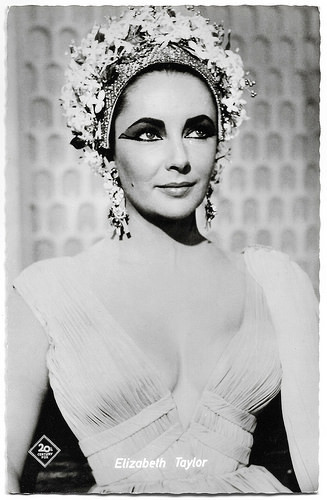
German postcard by Kolibri-Verlag, Minden/Westf., no. 2163. Photo: Centfox. Publicity still for Cleopatra (Joseph L. Mankiewicz, 1963).
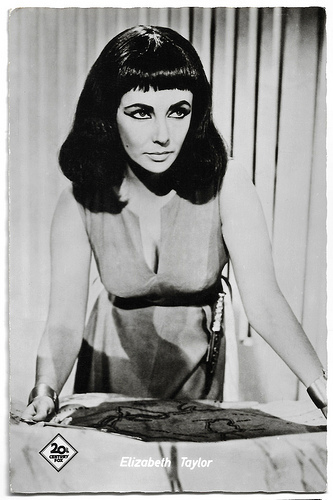
German postcard by Kolibri-Verlag, Minden/Westf., no. 2312. Photo: Centfox. Publicity still for Cleopatra (Joseph L. Mankiewicz, 1963).
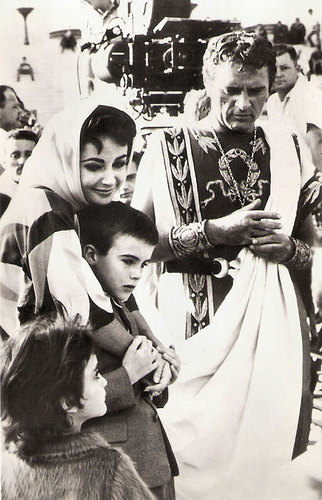
Richard Burton and Elizabeth Taylor . Czech collectors card by Pressfoto, Praha (Prague), no. S 229/2 769. Photo: a 1962 set photo of Cleopatra (Joseph L. Mankiewicz, 1963).
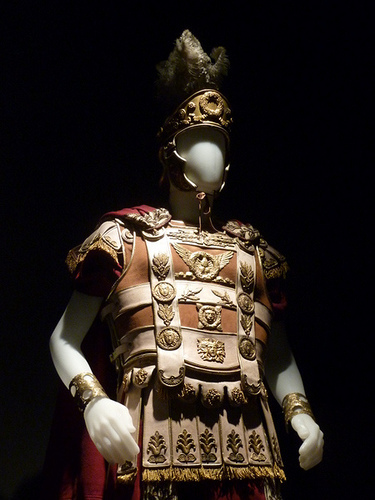
Costume of Richard Burton in Cleopatra (Joseph Mankiewicz, 1963), Cinecittà, Roma. Photo: Ivo Blom.
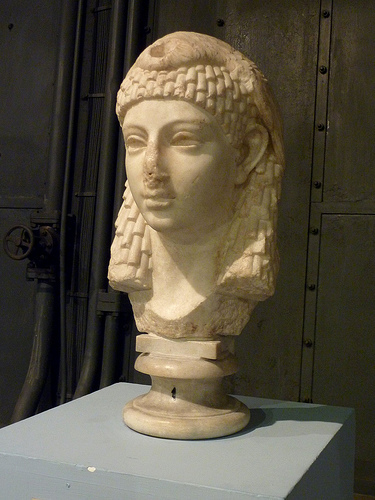
Portrait of Cleopatra. Hellenistic age. Found at the Via Labicana, Rome (1886). Centrale Montemartini Rome, Machine Hall. Photo: Ivo Blom.
Sources: Derek Armstrong (AllMovie), D.B DuMonteil (IMDb), Wikipedia and IMDb.

Elizabeth Taylor . Belgian postcard by SB (Uitgeverij Best), Antwerpen (Antwerp). Photo: still for Cleopatra (Joseph L. Mankiewicz, 1963).

Rex Harrison , Elizabeth Taylor and Richard Burton . Vintage postcard. Image: poster art work for Cleopatra (Joseph l. Mankiewicz, 1963).

German postcard by ISV, no. A.104. Photo: 20th Century Fox. Elizabeth Taylor in the epic Cleopatra (Joseph Manckiewcz, 1963).
The triumph and tragedy of a legendary queen
Cleopatra (Joseph Mankiewcz, 1963) was based on a screenplay adapted by Mankiewicz, Ranald MacDougall and Sidney Buchman from a book by Carlo Maria Franzero. It tells the story of the legendary Queen Cleopatra VII of Egypt ( Elizabeth Taylor ), who experiences both triumph and tragedy as she attempts to resist the imperial ambitions of Rome.
In 48 B.C., Julius Caesar ( Rex Harrison ) has beaten Pompey the Great in a brutal civil war for control of the Roman Republic and pursues Pompey from Pharsalia to Egypt. Caesar learns that Pompey has fled to neutral Egypt, hoping to enlist the support of the young teenage Pharaoh Ptolemy XIII (Richard O'Sullivan).
Ptolemy, now supreme ruler of Egypt after deposing his older sister, Cleopatra, attempts to gain favour with Caesar by presenting the conqueror with the head of Pompey, borne by his governors, Pothinos (Grégoire Aslan) and Achillas (John Doucette). Caesar is not pleased. For him, it is a sorry end for a worthy foe.
To win Caesar's support from her brother, the young Cleopatra hides herself in a rug, which her servant Apollodorus (Cesare Danova), disguised as a rug peddler, presents to Caesar as a gift from Cleopatra. When a suspicious Caesar unrolls the rug, he finds Cleopatra herself concealed within. The Roman is immediately infatuated; banishing Ptolemy, he declares Cleopatra Egypt's sole ruler and takes her as his mistress.
The ambitious Cleopatra uses her charms to manipulate Caesar and to establish her authority. A year later, she bears him the son he never had, Caesarion, and strives that their son will take his rightful place in Rome. Cleopatra can almost taste Egypt's long-awaited union with Rome, and the formation of a mighty empire. Caesar, however, must return to Italy for his triumph.
Two years pass before the two see each other again. After he is made dictator for life, Caesar sends for Cleopatra. She arrives in Rome in a lavish procession and wins the adulation of the Roman people. On the Ides of March in 44 B.C., the Senate is preparing to vote on whether to award Caesar additional powers for the Republic. Despite warnings from his wife Calpurnia (Gwen Watford) and Cleopatra, he is confident of victory. However, he is stabbed to death by various senators. Octavian (Roddy McDowall), Caesar's nephew, is named as his heir, not Caesarion. Cleopatra returns home to Egypt leaving Rome in turmoil.
Two years later in 42 B.C., Caesar's assassins, among them Cassius (John Hoyt) and Brutus (Kenneth Haigh), are killed at the Battle of Philippi. The powerful Roman general Marc Antony ( Richard Burton ) establishes a Second Triumvirate government with Octavian and Lepidus. Antony will take control of the eastern provinces including Asia Minor and Syria. In 38 B.C., when Mark Antony, Caesar's protege, beholds the beautiful Cleopatra aboard her elaborate barge at Tarsus, he is smitten and becomes both her lover and military ally.
Octavian uses their affair in his smear campaign against Antony. When Antony returns to Rome to address the situation brewing there, Octavian traps him into a marriage of state to Octavian's sister, Octavia (Jean Marsh). The marriage satisfies no one. Cleopatra is infuriated. Antony, tiring of his Roman wife, soon returns to Egypt and divorces Octavia. IN Egypt, he marries Cleopatra in a public ceremony. It leads the two lovers to a personal and political demise.
Shocked and insulted, the Senators who had previously stood by Antony abandon their hero and vote for war. Octavian murders the Egyptian ambassador, Cleopatra's tutor Sosigenes (Hume Cronyn), on the Senate steps. Sensing Antony's weakness, Octavian attacks and defeats his forces at Actium in 31 B.C. Alarmed, Cleopatra withdraws her fleet and seeks refuge in her tomb. Realising Anthony and her son are death, she arranges to be bitten by a poisonous asp.
In the final shot, Octavian and Agrippa enter Cleopatra's temple afterwords to see her dead, dressed in a gold funeral robe with her two handmaidens, also bitten by the same venomous snake that Cleopatra allowed herself to get bitten, dying by her side. Octavian also finds a last letter from Cleopatra requesting to be buried with Marc Antony.

Richard Burton and Elizabeth Taylor . German postcard by Filmbilder-Vertrieb Ernst Freihoff, Essen, no. AX 5536. Photo: publicity still for Cleopatra (Joseph L. Mankiewicz, 1963).

Elizabeth Taylor and Hume Cronyn. Czech postcard by UPF, Praha / Press Photo. Photo: publicity still for Cleopatra (Joseph L. Mankiewicz, 1963).

Richard Burton and Elizabeth Taylor . Czech postcard by UPTF Pressfoto, Praha (Prague), no. S 206/7. Photo: publicity still for Cleopatra (Joseph L. Mankiewicz, 1963).
The most expensive film ever made
As the story of Cleopatra had proved a hit for silent-screen legend Theda Bara with Cleopatra (J. Gordon Edwards, 1917), and for Claudette Colbert with Cleopatra (Cecil B. De Mille, 1934), 20th Century Fox executives hired veteran Hollywood producer Walter Wanger in 1958 to shepherd a new remake into production. Although the studio originally sought a relatively cheap production of $2 million, Wanger envisioned a much more opulent epic, and in mid-1959 successfully negotiated a higher budget of $5 million.
Rouben Mamoulian was assigned to direct and Elizabeth Taylor was awarded a record-setting contract of $1 million. Filming began in England but in January 1961 Taylor became so ill that production was shut down. Sixteen weeks of production and costs of $7 million had produced just ten minutes of film. Fox was reimbursed by the insurance company and Mamoulian was fired.
Joseph L. Mankiewicz was brought on to the production after Mamoulian's departure and the set moved to Cinecittà, outside of Rome. Peter Finch and Stephen Boyd left the production owing to other commitments and were replaced by Rex Harrison and Richard Burton .
During filming, Taylor met Richard Burton and the two began an adulterous affair. The scandal made headlines worldwide, since both were married to others, and brought bad publicity to the already troubled production. Mankiewicz was later fired during the editing phase, only to be rehired to reshoot the opening battle scenes in Spain.
The cut of the film which Mankiewicz screened for the studio was six hours long. This was cut to four hours for its initial premiere, but the studio demanded (over the objections of Mankiewicz) that the film be cut once more, this time to just barely over three hours to allow theatres to increase the number of showings per day. Mankiewicz unsuccessfully attempted to convince the studio to split the film in two in order to preserve the original cut. These were to be released separately as Caesar and Cleopatra followed by Antony and Cleopatra.
Cleopatra ended up costing $31 million, making it the most expensive film ever made at the time, and almost bankrupted 20th Century Fox. It was also the highest-grossing film of 1963, earning box-office of $57.7 million in the United States (equivalent to $461 million now), yet lost money due to its production and marketing costs of $44 million (equivalent to $352 million now), making it the only film ever to be the highest-grossing film of the year to run at a loss. Cleopatra later won four Academy Awards, and was nominated for five more, including Best Picture which it lost to the British adventure-comedy Tom Jones (Tony Richardson, 1963).
On 21 May 2013, the restored film was shown at a special screening at the 2013 Cannes Film Festival, to commemorate its 50th anniversary. It was later released as a 50th-anniversary version available on DVD and Blu-ray. Unfortunately Fox had long ago destroyed all of the trims and outs from negatives to save costs, preventing the release of traditional outtakes.
Derek Armstrong at All Movie : "Cleopatra is an interesting study in contradictions, as both a dud that won five Oscars and a lavish production that wastes most of its time on scenes of talking heads. Unfortunately, it's also not a 246-minute movie that breezes by; any modern viewer brave enough to sit through its four hours will feel the passage of every minute, with little ultimate reward for the time spent. The leads all acquit themselves admirably, especially Rex Harrison as Caesar, but viewers better acquainted with these characters through Shakespeare's lyrical language will lament the all-too-ordinary and sometimes anachronistic dialogue that comprises Joseph L. Mankiewicz's film. Elizabeth Taylor shines like the star she was, jumping in and out of dozens of ornate costumes, many of which hug her figure tightly, in a way that was provocative at the time. But she's a little too petulant and melodramatic to ultimately be taken seriously."
D.B DuMonteil at IMDb calls the film a 'visual poem, a feast for the eye and for the mind': "it was one of the most underrated Hollywood epics. First of all,it's only partially an epic: most of the scenes are intimate,generally two characters who are constantly tearing each other apart. Joseph L. Mankiewicz, one of the most intelligent director of his time, rewrote the dialogue during the shooting, night after night, and the results are stunning, considering the difficulties he encountered with his budget and his stars. Cleopatra's dream is perfectly recreated, much better than in De Mille's version."

Elizabeth Taylor . German postcard by Filmbilder-Vertrieb Ernst Freihoff, Essen, no. 824. Photo: Cleopatra / Centfox. Publicity still for Cleopatra (Joseph L. Mankiewicz, 1963).

German postcard by Kolibri-Verlag, Minden/Westf., no. 1657. Photo: Centfox. Publicity still for Cleopatra (Joseph L. Mankiewicz, 1963).

German postcard by Kolibri-Verlag, Minden/Westf., no. 1866. Photo: Centfox. Publicity still for Cleopatra (Joseph L. Mankiewicz, 1963).

German postcard by Kolibri-Verlag, Minden/Westf., no. 2163. Photo: Centfox. Publicity still for Cleopatra (Joseph L. Mankiewicz, 1963).

German postcard by Kolibri-Verlag, Minden/Westf., no. 2312. Photo: Centfox. Publicity still for Cleopatra (Joseph L. Mankiewicz, 1963).

Richard Burton and Elizabeth Taylor . Czech collectors card by Pressfoto, Praha (Prague), no. S 229/2 769. Photo: a 1962 set photo of Cleopatra (Joseph L. Mankiewicz, 1963).

Costume of Richard Burton in Cleopatra (Joseph Mankiewicz, 1963), Cinecittà, Roma. Photo: Ivo Blom.

Portrait of Cleopatra. Hellenistic age. Found at the Via Labicana, Rome (1886). Centrale Montemartini Rome, Machine Hall. Photo: Ivo Blom.
Sources: Derek Armstrong (AllMovie), D.B DuMonteil (IMDb), Wikipedia and IMDb.
Published on December 12, 2018 22:00
December 11, 2018
Barbara Lang
Beautiful, brassy Barbara Lang (1928–1982) was an American actress and singer. During the 1950s she was one of the many B-level blondes in Hollywood who were promoted as the new Marilyn Monroe. However, Lang appeared in only three films.

German postcard by ISV, Sort V 6.
Faith performing a miracle
Barbara Lang was born as Barbara Jean Bly in 1928 in Hollywood, California, U.S. She was the daughter of Los Angeles nose drop bottler Leonidis Stannage Bly and his wife Esther W., nee Kaufman, former silent movie dancer Maureen Knight.
Barbara worked a number of jobs before she broke into the entertainment industry. She sold jewellery in a Los Angeles department store and was a part-time fashion model at the age of seventeen. She was also a pianist and singer for a time in a cocktail lounge.
Lang suffered an attack of poliomyelitis in late 1953. She spent three weeks in the polio ward of Los Angeles General Hospital. Lang was told that she might never walk again. She turned to the Bible during this time and reportedly credited faith for performing a miracle. Shortly after being stricken, her legs and facial muscles were paralysed, and she had difficulty speaking. After many months of treatment she was able to walk again. The lingering effects of her illness robbed her of much of her stamina and she would tire easily for the rest of her life.
Recovered from polio, Lang went into television work. She first came to the attention of Hollywood producers with appearances in Death Valley Days (1955–1956), a TV series featuring true stories of the old American West, particularly the Death Valley area. Reportedly, half a dozen film studios vied to sign Lang after her TV performances.
She chose for Metro Goldwyn Mayer and was assigned to drama lessons. The starlet's first role was a bit part in Hot Summer Night (David Friedkin, 1957), starring Leslie Nielsen.
As a new star for MGM, Lang played the feminine lead in the Film Noir House of Numbers (Russell Rouse, 1957), co-starring with Jack Palance. In the film, Palance plays two similar-looking brothers: Bill and his younger brother Arnie Judlow. Bill is a good citizen, trying to help his ex-professional boxer brother, Arnie, convicted of murder, escape from San Quentin State Prison to return to Arnie's wife, Ruth, played by Lang. It was filmed inside San Quentin Prison and in Mill Valley, California.
Bethany Cox at IMDb : “While the story is less than perfect, there are some twists that keep it from being a standard thriller and there is some low-key suspense. The prison escape scheme is at times pretty ingenious. The characters maintain interest and the chemistry between the actors is continually good.”

German postcard by ISV, B 11. Photo: MGM. Still for House of Numbers (Russell Rouse, 1957).
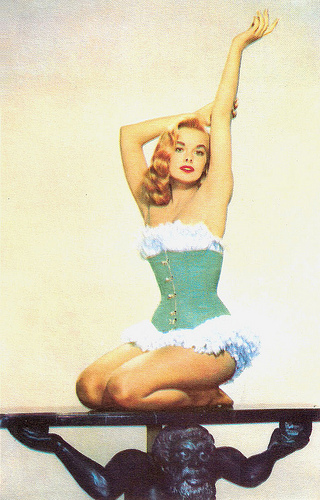
German / French postcard by ISV / Huit, no. B 6. Photo: MGM.
A Chicago showgirl called Ginger D'Amour
In the classy, exciting Film Noir Party Girl (Nicholas Ray, 1958), Barbara Lang played the supporting part of Ginger D'Amour, a Chicago showgirl of the 1930s.
Bruce Eder at AllMovie : “Party Girl is regarded by many Nicholas Ray fans as the most beautiful looking of all of his movies. Shot in CinemaScope and color, and starring Cyd Charisse (with Robert Taylor, it gave cinematographer Robert J. Bronner one of the best showcases he ever had for his work, and was a treat to the eye of the viewer, a veritable explosion of color and motion for many of its best sequences.”
A huge disappointment then for Barbara was when she lost out on the co-starring role opposite Elvis Presley in Jailhouse Rock (Richard Thorpe, 1957). After being initially named by the studio for the part, Judy Tyler was given the coveted role instead.
Lang would make only three films, but her TV credits are numerous. She appeared in episodes of The Thin Man (1957), Maverick (1958), The Bob Cummings Show (1958), 77 Sunset Strip (1959), Lawman (1959), Tightrope (1959), and The Outlaws (1960).
In November 1958, Lang won an annulment of her two-year marriage to actor Alan Wells, who had been her co-star in Death Valley Days. The decree was granted on grounds that Wells married Lang in Ensenada, Mexico, ten months before his divorce from actress Claudia Barrett was final.
Gary Brumburgh at IMDb : “With her annulment from Wells finalized in 1958 and a career going into an abrupt tailspin, Barbara attempted suicide in 1959 with an overdose of sleeping pills. She recovered but her career did not.”
Wells was her second husband. The first had been William McCorkle (1946-1952; divorced), and her final husband would be John George (1967-1972; divorced). She had two daughters, Pam and Cheryl. At age 54, Barbara Lang died in 1982 in Los Angeles, reportedly from pneumonia.
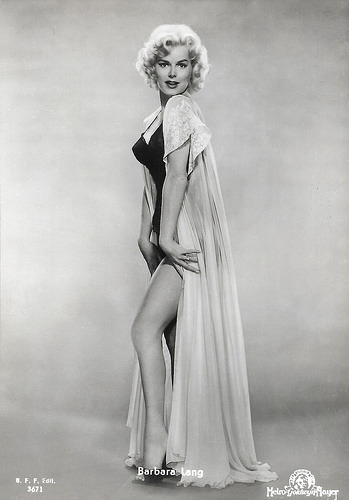
Italian postcard by Casa Editr. Ballerini & Fratini, Firenze, no. 3671. Photo: MGM. Publicity still for House of Numbers (Russell Rouse, 1957).
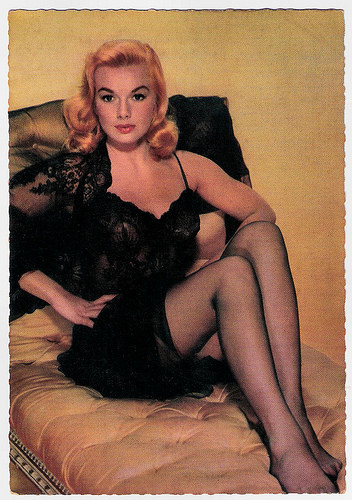
German postcard by ISV, no. B 10. Photo: MGM. Publicity still for House of Numbers (Russell Rouse, 1957).
Sources: Bruce Eder (AllMovie), (IMDb), Glamour Girls of the Silver Screen, AllMovie, Wikipedia, and .

German postcard by ISV, Sort V 6.
Faith performing a miracle
Barbara Lang was born as Barbara Jean Bly in 1928 in Hollywood, California, U.S. She was the daughter of Los Angeles nose drop bottler Leonidis Stannage Bly and his wife Esther W., nee Kaufman, former silent movie dancer Maureen Knight.
Barbara worked a number of jobs before she broke into the entertainment industry. She sold jewellery in a Los Angeles department store and was a part-time fashion model at the age of seventeen. She was also a pianist and singer for a time in a cocktail lounge.
Lang suffered an attack of poliomyelitis in late 1953. She spent three weeks in the polio ward of Los Angeles General Hospital. Lang was told that she might never walk again. She turned to the Bible during this time and reportedly credited faith for performing a miracle. Shortly after being stricken, her legs and facial muscles were paralysed, and she had difficulty speaking. After many months of treatment she was able to walk again. The lingering effects of her illness robbed her of much of her stamina and she would tire easily for the rest of her life.
Recovered from polio, Lang went into television work. She first came to the attention of Hollywood producers with appearances in Death Valley Days (1955–1956), a TV series featuring true stories of the old American West, particularly the Death Valley area. Reportedly, half a dozen film studios vied to sign Lang after her TV performances.
She chose for Metro Goldwyn Mayer and was assigned to drama lessons. The starlet's first role was a bit part in Hot Summer Night (David Friedkin, 1957), starring Leslie Nielsen.
As a new star for MGM, Lang played the feminine lead in the Film Noir House of Numbers (Russell Rouse, 1957), co-starring with Jack Palance. In the film, Palance plays two similar-looking brothers: Bill and his younger brother Arnie Judlow. Bill is a good citizen, trying to help his ex-professional boxer brother, Arnie, convicted of murder, escape from San Quentin State Prison to return to Arnie's wife, Ruth, played by Lang. It was filmed inside San Quentin Prison and in Mill Valley, California.
Bethany Cox at IMDb : “While the story is less than perfect, there are some twists that keep it from being a standard thriller and there is some low-key suspense. The prison escape scheme is at times pretty ingenious. The characters maintain interest and the chemistry between the actors is continually good.”

German postcard by ISV, B 11. Photo: MGM. Still for House of Numbers (Russell Rouse, 1957).

German / French postcard by ISV / Huit, no. B 6. Photo: MGM.
A Chicago showgirl called Ginger D'Amour
In the classy, exciting Film Noir Party Girl (Nicholas Ray, 1958), Barbara Lang played the supporting part of Ginger D'Amour, a Chicago showgirl of the 1930s.
Bruce Eder at AllMovie : “Party Girl is regarded by many Nicholas Ray fans as the most beautiful looking of all of his movies. Shot in CinemaScope and color, and starring Cyd Charisse (with Robert Taylor, it gave cinematographer Robert J. Bronner one of the best showcases he ever had for his work, and was a treat to the eye of the viewer, a veritable explosion of color and motion for many of its best sequences.”
A huge disappointment then for Barbara was when she lost out on the co-starring role opposite Elvis Presley in Jailhouse Rock (Richard Thorpe, 1957). After being initially named by the studio for the part, Judy Tyler was given the coveted role instead.
Lang would make only three films, but her TV credits are numerous. She appeared in episodes of The Thin Man (1957), Maverick (1958), The Bob Cummings Show (1958), 77 Sunset Strip (1959), Lawman (1959), Tightrope (1959), and The Outlaws (1960).
In November 1958, Lang won an annulment of her two-year marriage to actor Alan Wells, who had been her co-star in Death Valley Days. The decree was granted on grounds that Wells married Lang in Ensenada, Mexico, ten months before his divorce from actress Claudia Barrett was final.
Gary Brumburgh at IMDb : “With her annulment from Wells finalized in 1958 and a career going into an abrupt tailspin, Barbara attempted suicide in 1959 with an overdose of sleeping pills. She recovered but her career did not.”
Wells was her second husband. The first had been William McCorkle (1946-1952; divorced), and her final husband would be John George (1967-1972; divorced). She had two daughters, Pam and Cheryl. At age 54, Barbara Lang died in 1982 in Los Angeles, reportedly from pneumonia.

Italian postcard by Casa Editr. Ballerini & Fratini, Firenze, no. 3671. Photo: MGM. Publicity still for House of Numbers (Russell Rouse, 1957).

German postcard by ISV, no. B 10. Photo: MGM. Publicity still for House of Numbers (Russell Rouse, 1957).
Sources: Bruce Eder (AllMovie), (IMDb), Glamour Girls of the Silver Screen, AllMovie, Wikipedia, and .
Published on December 11, 2018 22:00
December 10, 2018
Bette Davis
American film star Bette Davis (1908-1989) was one of the greatest actors in world cinema history. She dared to play unsympathetic, sardonic characters and was reputed for her performances in a range of film genres, from contemporary crime melodramas to historical and period films and occasional comedies. Her greatest successes were her roles in romantic dramas.
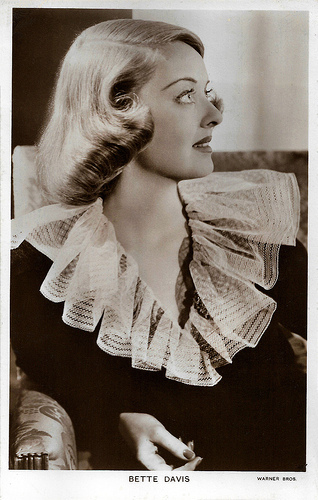
British postcard in the Picturegoer Series, London, no. W 3. Photo: Warner Bros.
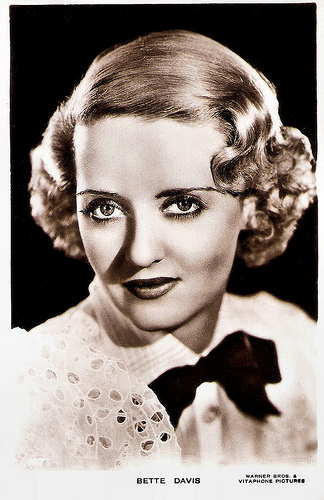
British Real Photograph postcard. Photo: Warner Bros. / Vitaphone Pictures.
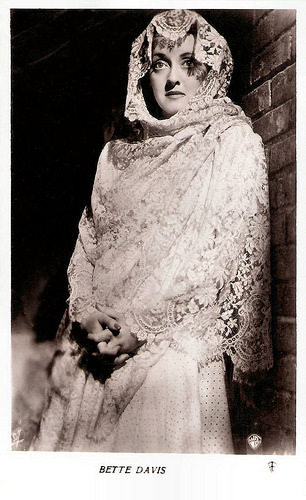
British postcard. Photo: Warner Bros. Publicity still for The Letter (William Wyler, 1940).
Emphasising her distinctive eyes
Ruth Elizabeth Davis was born in 1908, in Lowell, Massachusetts, to Ruth Augusta (Favor) and Harlow Morrell Davis, a patent attorney. Her parents divorced when she was 10. She and her younger sister Barbara were raised by their mother. Her early interest was dance. To Bette, dancers led a glamorous life, but then she discovered the stage, and gave up dancing for acting. To her, it presented much more of a challenge.
After graduation from Cushing Academy, a prep school in Ashburnham, Massachusetts, Davis was refused admittance to Eva Le Gallienne's Manhattan Civic Repertory. She enrolled in John Murray Anderson's Dramatic School where everyone (including classmate Lucille Ball) regarded her as the star pupil. After a 1928 summer season with director George Cukor's stock company in Rochester, N.Y. (where she worked with future co-star - and rival - Miriam Hopkins), Davis went on to New York. Her Broadway debut was in Broken Dishes (1929) and she also appeared in Solid South.
In 1930, Davis moved to Hollywood and signed a contract with Universal. Her first film was the drama Way Back Home (William A. Seiter, 1931). Her early films for Universal were unsuccessful or she only had a small role, such as in James Whale's Waterloo Bridge (1931). Davis later recalled Universal Pictures executive Carl Laemmle Jr. complaining: "She's got as much sex appeal as Slim Summerville".
Davis was preparing to return to New York when actor George Arliss chose her for the female lead in the Warner Brothers picture The Man Who Played God (John G. Adolfi, 1932), which would be her 'break' in Hollywood. Warner Bros. signed her a five-year ( Wikipedia ) either a seven-year contract ( IMDb ). Her first film with them had been Seed (John M. Stahl, 1931), starring John Boles.
The role of the vicious and slatternly Mildred Rogers in RKO's Of Human Bondage (John Cromwell, 1934) earned Davis her first major critical acclaim. She had a significant number of write-in votes for the Best Actress Oscar, but didn't win. For her role as a troubled actress in Dangerous (Alfred E. Green, 1935), she won her first Oscar. With this success under her belt, she began pushing at Warner for stronger and more meaningful roles.
In 1936, she was suspended without pay for turning down a role that she deemed unworthy of her talent. She went to England, where she had planned to make films, but was stopped by Warner Bros. because she was still under contract to them and they did not want her to work anywhere. Although she sued to get out of her contract, she lost a well-publicised legal case.
Still, Warner began to take her more seriously after that, and the lawsuit marked the beginning of the most successful period of her career. In Marked Woman (Lloyd Bacon, 1937), she played a prostitute in a contemporary gangster drama inspired by the case of Lucky Luciano. For her role she was awarded the Volpi Cup at the 1937 Venice Film Festival. Her next picture was Jezebel (William Wyler, 1938) with Henry Fonda, and during production Davis entered a relationship with director William Wyler. The film was a success, and Davis' performance as a spoiled Southern Belle earned her a second Academy Award.
In 1939 alone, Davis starred in Dark Victory (Edmund Goulding, 1939), Juarez (William Dieterle, 1939) with Paul Muni, The Private Lives of Elizabeth and Essex (Michael Curtiz, 1939) with Errol Flynn , and The Old Maid (Edmund Goulding, 1939) with Miriam Hopkins. Dark Victory (became one of the highest grossing films of the year, and the role of Judith Traherne brought her an Academy Award nomination. The Private Lives of Elizabeth and Essex was her first colour film. To play the elderly Elizabeth I of England, Davis shaved her hairline and eyebrows. Davis was now Warner Bros.' most profitable star, and she was given the most important of their female leading roles. Her image was considered with care; she was often filmed in close-ups that emphasised her distinctive eyes.
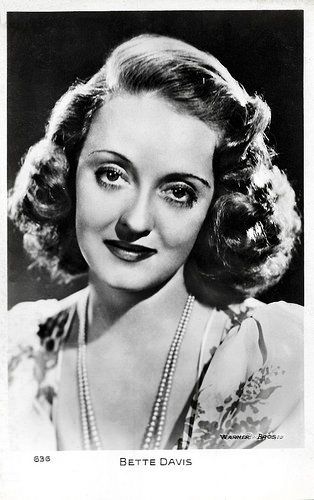
French postcard by Editions Chantal, Paris, no. 636. Photo: Warner Bros.
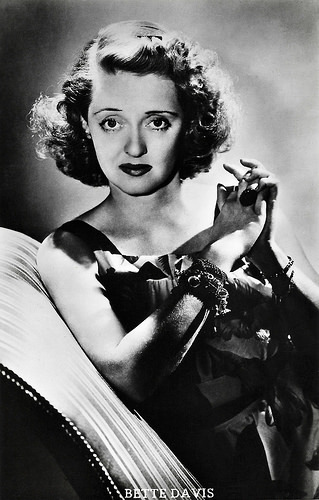
Dutch postcard, no. 550. Photo: Warner Bros.
Labelled 'Box Office Poison'
Until the late 1940s, Bette Davis was one of American cinema's most celebrated leading ladies, known for her forceful and intense style. Davis gained a reputation as a perfectionist who could be highly combative, and confrontations with studio executives, film directors and co-stars were often reported.
After The Letter (William Wyler, 1940), William Wyler directed Davis for the third time in Lillian Hellman's The Little Foxes (1941), but they clashed over the character of Regina Giddens. Taking a role originally played on stage by Tallulah Bankhead, Davis felt Bankhead's original interpretation was appropriate and followed Hellman's intent, but Wyler wanted her to soften the character. Davis refused to compromise.
Davis's forthright manner, clipped vocal style and ubiquitous cigarette contributed to a public persona which has often been imitated and satirised. In 1941, she became the first female president of the Academy of Motion Picture Arts and Sciences and a year later, she was the co-founder of the Hollywood Canteen.
Her best films include the women's picture Now Voyager (Irving Rapper, 1942) and Watch on the Rhine (Herman Shumlin, 1943). She was nominated for an Academy Award 5 years in a row, in 1939, 1940, 1941, 1942 and 1943. In 1947, at the age of 39, Davis gave birth to a daughter, Barbara Davis Sherry (known as B.D.). The father, her third husband William Grant Sherry, later divorced her to marry their child's governess Marion Richards.
Bette Davis made many successful films in the 1940s, but each picture was weaker than the last. In 1949, Davis was so unhappy over being cast in Beyond the Forest (King Vidor, 1949) with Joseph Cotten that she threatened Warner Bros. studio chief Jack L. Warner that she would walk off the production with the film only half finished. Warner was forced to cancel her contract and Davis completed the film, ending 18 years with the studio.
By the time, her box office appeal had noticeably dropped and she was labelled 'Box Office Poison'. Then producer Darryl F. Zanuck offered her the role of the ageing theatrical actress Margo Channing in All About Eve (Joseph L. Mankiewicz, 1950). During production, she had a romantic relationship with her leading man, Gary Merrill, which led to her fourth marriage. Her career went through several of such periods of eclipse. In 1961 she even placed a now famous Job Wanted ad in the trade papers. Later, Davis admitted that her success had often been at the expense of her personal relationships. Married four times, she was once widowed and thrice divorced, and raised her children as a single parent.
Later successes include the Grand Guignol horror film What Ever Happened to Baby Jane? (Robert Aldrich, 1962) with Joan Crawford, and the follow-up Hush… Hush, Sweet Charlotte (Robert Aldrich, 1964) with Olivia de Havilland. Reportedly, Joan Crawford and Davis had feuded for years, some of it instigated by publicists and studio heads. During the making of What Ever Happened to Baby Jane? (1962), Bette had a Coca-Cola machine installed on the set due to Crawford's affiliation with Pepsi (she was the widow of Pepsi's CEO). Joan got her revenge by putting weights in her pockets when Davis had to drag her across the floor during certain scenes. While promoting the film, Davis told one interviewer that when she and Crawford were first suggested for the leads, Warner studio head Jack L. Warner replied: "I wouldn't give a plugged nickel for either of those two old broads." Recalling the story, Davis laughed at her own expense. The following day, she received a telegram from Crawford: "In future, please do not refer to me as an old broad!".
Bette Davis' final years were marred by a long period of ill health, but she continued acting until shortly before her death from breast cancer, with more than 100 films, television and theatre roles to her credit. She was the first person to accrue 10 Academy Award nominations for acting, and in 1977, she was the first woman to receive a Lifetime Achievement Award from the American Film Institute. In 1979 she won a Best Actress Emmy for Strangers: The Story of a Mother and Daughter (Milton Katselas, 1979) with Gena Rowlands. One of her last films was Lindsay Anderson's film The Whales of August (1987), in which she played the blind sister of Lillian Gish .
Bette Davis died in 1989, of metastasised breast cancer, in Neuilly-sur-Seine, Hauts-de-Seine, France. A lot of her fans refused to believe it. She reportedly left an estate valued between $600,000 and $1 million, consisting mainly of a condominium apartment she owned in West Hollywood. 50% of her estate went to her son, Michael Merrill, and the remaining 50% went to her secretary and companion, Kathryn Sermack. Her daughter, Barbara Merrill aka B.D. Hyman, was left nothing due to her tell-all book My Mother's Keeper about life with her mother. (Davis wrote the book This 'n That in response to her daughter's book.) And IMDb notes that Bette Davis's false eyelashes were auctioned off after her death, fetching a price of $600.
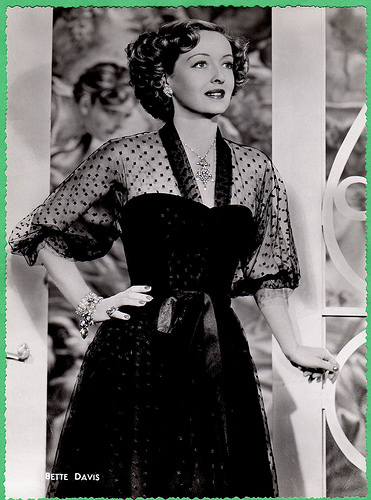
Belgian collectors card by Chocolaterie Clovis, Pepinster. Collection: Amit Benyovits.
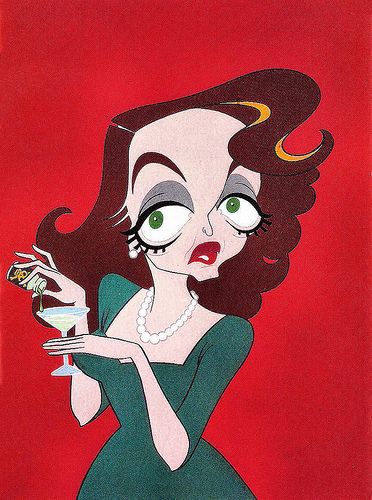
British postcard by Athena International, London, no. 9244. Illustration: Oscar da Costa.
Sources: Hal Erickson (AllMovie), Wikipedia and .

British postcard in the Picturegoer Series, London, no. W 3. Photo: Warner Bros.

British Real Photograph postcard. Photo: Warner Bros. / Vitaphone Pictures.

British postcard. Photo: Warner Bros. Publicity still for The Letter (William Wyler, 1940).
Emphasising her distinctive eyes
Ruth Elizabeth Davis was born in 1908, in Lowell, Massachusetts, to Ruth Augusta (Favor) and Harlow Morrell Davis, a patent attorney. Her parents divorced when she was 10. She and her younger sister Barbara were raised by their mother. Her early interest was dance. To Bette, dancers led a glamorous life, but then she discovered the stage, and gave up dancing for acting. To her, it presented much more of a challenge.
After graduation from Cushing Academy, a prep school in Ashburnham, Massachusetts, Davis was refused admittance to Eva Le Gallienne's Manhattan Civic Repertory. She enrolled in John Murray Anderson's Dramatic School where everyone (including classmate Lucille Ball) regarded her as the star pupil. After a 1928 summer season with director George Cukor's stock company in Rochester, N.Y. (where she worked with future co-star - and rival - Miriam Hopkins), Davis went on to New York. Her Broadway debut was in Broken Dishes (1929) and she also appeared in Solid South.
In 1930, Davis moved to Hollywood and signed a contract with Universal. Her first film was the drama Way Back Home (William A. Seiter, 1931). Her early films for Universal were unsuccessful or she only had a small role, such as in James Whale's Waterloo Bridge (1931). Davis later recalled Universal Pictures executive Carl Laemmle Jr. complaining: "She's got as much sex appeal as Slim Summerville".
Davis was preparing to return to New York when actor George Arliss chose her for the female lead in the Warner Brothers picture The Man Who Played God (John G. Adolfi, 1932), which would be her 'break' in Hollywood. Warner Bros. signed her a five-year ( Wikipedia ) either a seven-year contract ( IMDb ). Her first film with them had been Seed (John M. Stahl, 1931), starring John Boles.
The role of the vicious and slatternly Mildred Rogers in RKO's Of Human Bondage (John Cromwell, 1934) earned Davis her first major critical acclaim. She had a significant number of write-in votes for the Best Actress Oscar, but didn't win. For her role as a troubled actress in Dangerous (Alfred E. Green, 1935), she won her first Oscar. With this success under her belt, she began pushing at Warner for stronger and more meaningful roles.
In 1936, she was suspended without pay for turning down a role that she deemed unworthy of her talent. She went to England, where she had planned to make films, but was stopped by Warner Bros. because she was still under contract to them and they did not want her to work anywhere. Although she sued to get out of her contract, she lost a well-publicised legal case.
Still, Warner began to take her more seriously after that, and the lawsuit marked the beginning of the most successful period of her career. In Marked Woman (Lloyd Bacon, 1937), she played a prostitute in a contemporary gangster drama inspired by the case of Lucky Luciano. For her role she was awarded the Volpi Cup at the 1937 Venice Film Festival. Her next picture was Jezebel (William Wyler, 1938) with Henry Fonda, and during production Davis entered a relationship with director William Wyler. The film was a success, and Davis' performance as a spoiled Southern Belle earned her a second Academy Award.
In 1939 alone, Davis starred in Dark Victory (Edmund Goulding, 1939), Juarez (William Dieterle, 1939) with Paul Muni, The Private Lives of Elizabeth and Essex (Michael Curtiz, 1939) with Errol Flynn , and The Old Maid (Edmund Goulding, 1939) with Miriam Hopkins. Dark Victory (became one of the highest grossing films of the year, and the role of Judith Traherne brought her an Academy Award nomination. The Private Lives of Elizabeth and Essex was her first colour film. To play the elderly Elizabeth I of England, Davis shaved her hairline and eyebrows. Davis was now Warner Bros.' most profitable star, and she was given the most important of their female leading roles. Her image was considered with care; she was often filmed in close-ups that emphasised her distinctive eyes.

French postcard by Editions Chantal, Paris, no. 636. Photo: Warner Bros.

Dutch postcard, no. 550. Photo: Warner Bros.
Labelled 'Box Office Poison'
Until the late 1940s, Bette Davis was one of American cinema's most celebrated leading ladies, known for her forceful and intense style. Davis gained a reputation as a perfectionist who could be highly combative, and confrontations with studio executives, film directors and co-stars were often reported.
After The Letter (William Wyler, 1940), William Wyler directed Davis for the third time in Lillian Hellman's The Little Foxes (1941), but they clashed over the character of Regina Giddens. Taking a role originally played on stage by Tallulah Bankhead, Davis felt Bankhead's original interpretation was appropriate and followed Hellman's intent, but Wyler wanted her to soften the character. Davis refused to compromise.
Davis's forthright manner, clipped vocal style and ubiquitous cigarette contributed to a public persona which has often been imitated and satirised. In 1941, she became the first female president of the Academy of Motion Picture Arts and Sciences and a year later, she was the co-founder of the Hollywood Canteen.
Her best films include the women's picture Now Voyager (Irving Rapper, 1942) and Watch on the Rhine (Herman Shumlin, 1943). She was nominated for an Academy Award 5 years in a row, in 1939, 1940, 1941, 1942 and 1943. In 1947, at the age of 39, Davis gave birth to a daughter, Barbara Davis Sherry (known as B.D.). The father, her third husband William Grant Sherry, later divorced her to marry their child's governess Marion Richards.
Bette Davis made many successful films in the 1940s, but each picture was weaker than the last. In 1949, Davis was so unhappy over being cast in Beyond the Forest (King Vidor, 1949) with Joseph Cotten that she threatened Warner Bros. studio chief Jack L. Warner that she would walk off the production with the film only half finished. Warner was forced to cancel her contract and Davis completed the film, ending 18 years with the studio.
By the time, her box office appeal had noticeably dropped and she was labelled 'Box Office Poison'. Then producer Darryl F. Zanuck offered her the role of the ageing theatrical actress Margo Channing in All About Eve (Joseph L. Mankiewicz, 1950). During production, she had a romantic relationship with her leading man, Gary Merrill, which led to her fourth marriage. Her career went through several of such periods of eclipse. In 1961 she even placed a now famous Job Wanted ad in the trade papers. Later, Davis admitted that her success had often been at the expense of her personal relationships. Married four times, she was once widowed and thrice divorced, and raised her children as a single parent.
Later successes include the Grand Guignol horror film What Ever Happened to Baby Jane? (Robert Aldrich, 1962) with Joan Crawford, and the follow-up Hush… Hush, Sweet Charlotte (Robert Aldrich, 1964) with Olivia de Havilland. Reportedly, Joan Crawford and Davis had feuded for years, some of it instigated by publicists and studio heads. During the making of What Ever Happened to Baby Jane? (1962), Bette had a Coca-Cola machine installed on the set due to Crawford's affiliation with Pepsi (she was the widow of Pepsi's CEO). Joan got her revenge by putting weights in her pockets when Davis had to drag her across the floor during certain scenes. While promoting the film, Davis told one interviewer that when she and Crawford were first suggested for the leads, Warner studio head Jack L. Warner replied: "I wouldn't give a plugged nickel for either of those two old broads." Recalling the story, Davis laughed at her own expense. The following day, she received a telegram from Crawford: "In future, please do not refer to me as an old broad!".
Bette Davis' final years were marred by a long period of ill health, but she continued acting until shortly before her death from breast cancer, with more than 100 films, television and theatre roles to her credit. She was the first person to accrue 10 Academy Award nominations for acting, and in 1977, she was the first woman to receive a Lifetime Achievement Award from the American Film Institute. In 1979 she won a Best Actress Emmy for Strangers: The Story of a Mother and Daughter (Milton Katselas, 1979) with Gena Rowlands. One of her last films was Lindsay Anderson's film The Whales of August (1987), in which she played the blind sister of Lillian Gish .
Bette Davis died in 1989, of metastasised breast cancer, in Neuilly-sur-Seine, Hauts-de-Seine, France. A lot of her fans refused to believe it. She reportedly left an estate valued between $600,000 and $1 million, consisting mainly of a condominium apartment she owned in West Hollywood. 50% of her estate went to her son, Michael Merrill, and the remaining 50% went to her secretary and companion, Kathryn Sermack. Her daughter, Barbara Merrill aka B.D. Hyman, was left nothing due to her tell-all book My Mother's Keeper about life with her mother. (Davis wrote the book This 'n That in response to her daughter's book.) And IMDb notes that Bette Davis's false eyelashes were auctioned off after her death, fetching a price of $600.

Belgian collectors card by Chocolaterie Clovis, Pepinster. Collection: Amit Benyovits.

British postcard by Athena International, London, no. 9244. Illustration: Oscar da Costa.
Sources: Hal Erickson (AllMovie), Wikipedia and .
Published on December 10, 2018 22:00
December 9, 2018
Virginia Valli
American stage and film actress Virginia Valli (1895–1968) was an established star at Universal during the mid 1920s. She worked with such directors as John Ford, King Vidor, Howard Hawks and the young Alfred Hitchcock. Her motion picture career had started in 1915 at the Chicago-based Selig Polyscope Company and lasted until the beginning of the sound film era of the early 1930s.
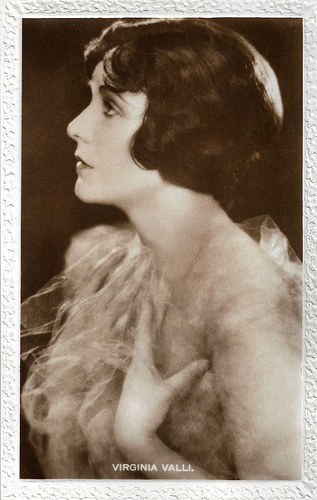
British Real Photograph postcard.
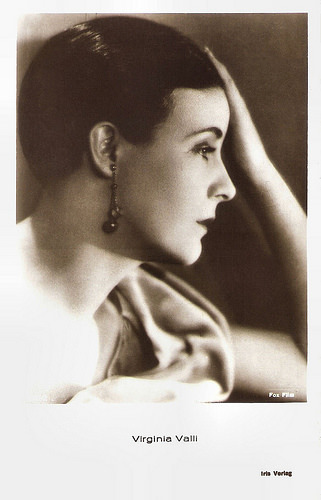
Austrian postcard by Iris Verlag. Photo: Fox Film.
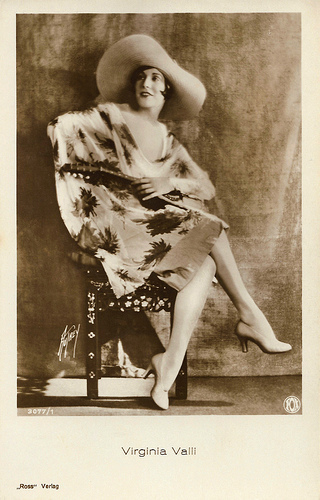
German postcard by Ross Verlag, no. 3077/1, 1928-1929. Photo: Max Munn Autrey / Fox.
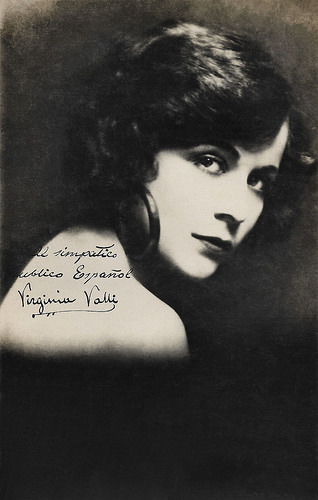
Spanish postcard.
John Ford
Virginia Valli, originally Virginia McSweeney, was born in Chicago, Illinois, in 1895 according to Wikipedia (in 1896 according to IMDb or in 1898 according to AllMovie). She studied dancing and worked as a stenographer before becoming an actress. She started acting in Milwaukee at a theatre stock company.
According to AllMovie , she made her screen debut with the Chicago-based Selig Polyscope Company in 1915. From 1916, she acted in some 18 films at the Essanay Studios in Chicago. There she made her debut in a minor part in the serial The Strange Case of Mary Page (J. Charles Haydon, 1916) with Henry B. Walthall and Edna Mayo, but quickly she played all the female leads of the Essanay productions.
After that, she acted at the studios of World Film, Fort Lee, New Jersey, such as The Black Circle (Frank Reicher, 1919) with Creighton Hale. However, when features came along, Valli was reduced to supporting parts. By 1920, Valli had moved to California to act in films by Fox, Vitagraph and others. By that time she had already adopted the name of Virginia Valli.
A major part she had in the Metro Pictures film The Man Who (Maxwell Karger, 1921) with Bert Lytell and Lucy Cotton, and scripted by June Mathis. On the film's success, Metro then put matinee idol Lytell and Valli in a string of popular melodramas, including the boxing drama The Right That Failed (Bayard Veiller, 1922).
In 1922-1924, Virginia Valli did several films for Universal. She had a major part in John Ford's melodrama The Village Blacksmith (1922), based on Henry Wadsworth Longfellow's poem. She also appeared in the Northwoods melodrama The Storm (Reginald Barker, 1922) with House Peters, and in The Shock (Lambert Hillyer, 1923), in which crippled blackmailer Lon Chaney falls in love with the daughter of his banker victim, combined with the San Francisco earthquake.
Other memorable titles were The Signal Tower (Clarence Brown, 1924) with Wallace Beery, Wild Oranges (King Vidor, 1924), The Confidence Man (Victor Heerman, 1924) with Thomas Meighan, and Up the Ladder (Edward Sloman, 1925) with Margaret Livingston.
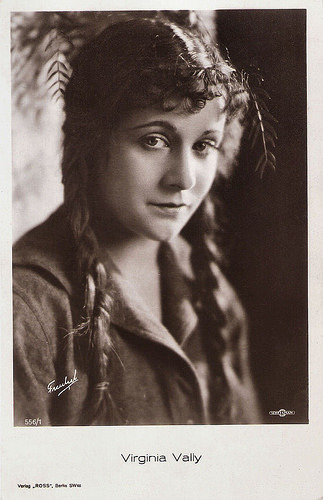
German postcard by Ross Verlag, no. 556/1, 1919-1924. Photo: Roman Freulich / Unfilman.
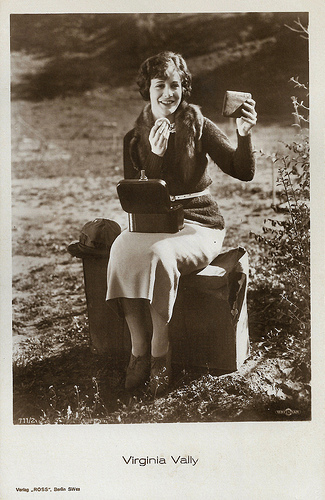
German postcard by Ross Verlag, no. 711/2, 1925-1926. Photo: Unifilman.
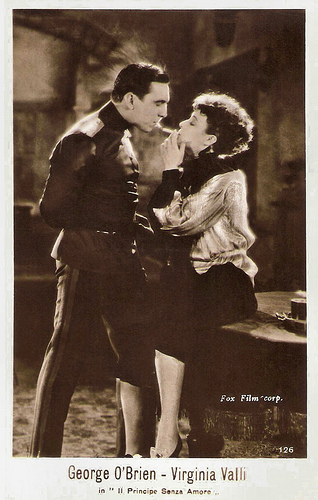
Italian postcard by G.B. Falci, Milano, no. 126. Photo: Fox Film Corp. Publicity still for Paid to Love (1927) with George O'Brien.
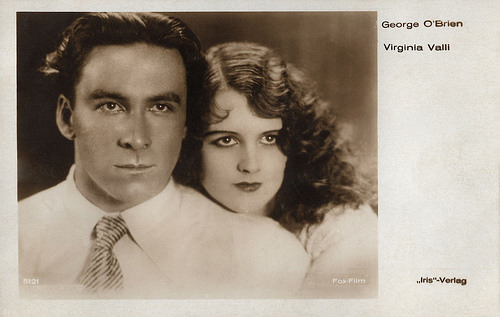
Austrian postcard by Iris-Verlag, no. 5121. Photo: Fox-Film. Publicity still for Paid to Love (Howard Hawks, 1927) with George O'Brien.
Alfred Hitchcock
Virginia Valli travelled to Europe to star in the German-British co-production The Pleasure Garden (1925), the first film directed by Alfred Hitchcock, when he was 25. Valli was at the height of her career – she was glamorous, famous, and very popular. That a Hollywood star like her was coming to Europe to make a film was an event. Location shooting for The Pleasure Garden was done in Italy and Germany.
The film follows the love lives of two dancers at a London nightspot, called 'Pleasure Garden'. Dancer Patsy Brand (Valli) helps Jill (Carmelita Geraghty) to get a job at the nightspot. Via Jill's fiancee Hugh ( John Stuart ) she meets Levet (Miles Mander) and eventually marries him. They sail for Italy on a honeymoon. Levett and Hugh then go on a trip to one of the British colonies. Jill, meanwhile, has dropped Hugh for a rich prince who spoils her and she has become distant to Patsy. When Patsy receives notice that her husband is ill, she travels after him, but discovers he has an affair with a native woman. Patsy, instead, takes care of a really ill Hugh, which Levet doesn't like...
Hal Erickson at AllMovie : "Filmed on a very tight budget, The Pleasure Garden never betrays its parsimonious nature. And though it cannot be labelled a 'typical' Hitchcock picture, it contains enough clever pictorial touches to indicate that the man in the director's chair was definitely someone to conjure with. To quote the reviewer of the London Daily Express : 'His work is of a uniformly high quality; there are times when it is great, times when the onlooker says to himself 'That is perfect'.' "
The Pleasure Garden was produced by Michael Balcon and Erich Pommer. It was Balcon who hired Valli as star of the film, being one of the first Hollywood stars to come to Europa for filming. Her co-star Carmelita Geraghty was also American.
Virginia Valli continued appearing in Hollywood films throughout the decade. She had no long-lasting contracts with majors, so she played at all major and minor studios in the 1920s. In 1925 Valli acted in the drama The Man Who Found Himself (Alfred E. Green, 1925) with Thomas Meighan. The Famous Players-Lasky production was carried out in the studio of Long Island, New York.
Among her later films were also the highlights Stage Madness (Victor Schertzinger, 1927) with Tullio Carminati , the romantic comedy Paid To Love (Howard Hawks, 1927), with George O'Brien and William Powell, and the comedy-drama Evening Clothes (Luther Reed, 1927), with Adolphe Menjou .
Tony Fontana at IMDb : "While she had no trouble adjusting to sound in The Isle of Lost Ships (1929), which she made at First National, her big salary and declining appeal both conspired to end her film career. Unable to find a suitable studio, she would make her last film The Last Zeppelin (1930) at Tiffany Studios." However, her last film was Night Life in Reno (Raymond Cannon, 1931), a low-budget production from small-scale Artclass Pictures.
Another view from Hans Wollstein at AllMovie : "Usually considered a victim of sound, Valli actually registered well in her first talkie, Mr. Antonio (1929), and although she was considered a bit stiff and "too English" in The Isle of Lost Ships (1929), her voice recorded well. But no longer in the first bloom of youth by 1930, Valli found herself in a no-win position and chose to retire after Night Life in Reno (1931)".
Virginia Valli had been married from 1921 till 1927 to George Demarest Lamson. In 1931, she wed film actor Charles Farrell, a marriage that lasted until her death. After the wedding, she retired to live in Beverly Hills before moving to Palm Springs. There she had an intense social life for years. For over three decades she ran the popular Palm Springs star hang-out The Raquet Club, which opened on Christmas Day in 1934. Husband Charles Farrell eventually served as mayor of Palm Springs from 1948 until 1954.
Virginia Valli suffered a stroke in 1966, and died two years later, in Palm Springs. She was buried in Welwood Murray Cemetery in that city. Valli did not have children.
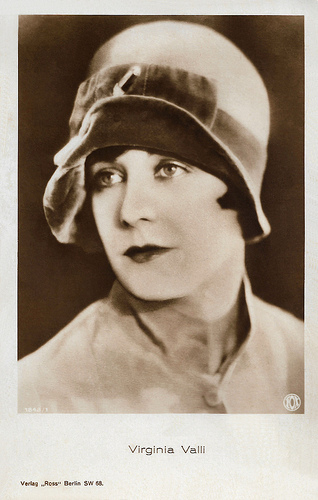
German postcard by Ross Verlag, Berlin, no. 1848/1, 1927-1928. Photo: Fox.
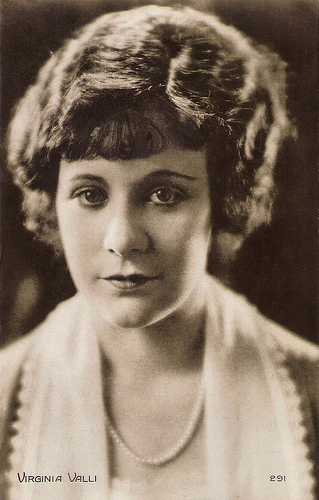
French postcard by Cinémagazine-Edition, Paris, no. 291.
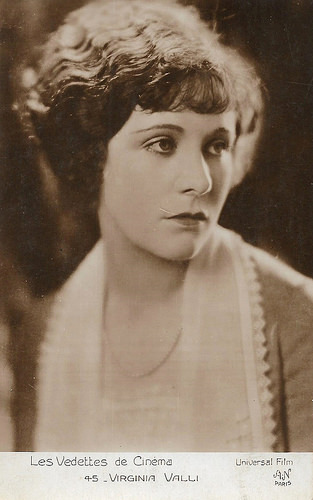
French postcard by A.N., Paris in the Les Vedettes de Cinéma series, no. 45. Photo: Universal Film.
Sources: Hal Erickson (AllMovie), Hans J. Wollstein (AllMovie), (IMDb), Wikipedia (English, Spanish, and Italian) and .

British Real Photograph postcard.

Austrian postcard by Iris Verlag. Photo: Fox Film.

German postcard by Ross Verlag, no. 3077/1, 1928-1929. Photo: Max Munn Autrey / Fox.

Spanish postcard.
John Ford
Virginia Valli, originally Virginia McSweeney, was born in Chicago, Illinois, in 1895 according to Wikipedia (in 1896 according to IMDb or in 1898 according to AllMovie). She studied dancing and worked as a stenographer before becoming an actress. She started acting in Milwaukee at a theatre stock company.
According to AllMovie , she made her screen debut with the Chicago-based Selig Polyscope Company in 1915. From 1916, she acted in some 18 films at the Essanay Studios in Chicago. There she made her debut in a minor part in the serial The Strange Case of Mary Page (J. Charles Haydon, 1916) with Henry B. Walthall and Edna Mayo, but quickly she played all the female leads of the Essanay productions.
After that, she acted at the studios of World Film, Fort Lee, New Jersey, such as The Black Circle (Frank Reicher, 1919) with Creighton Hale. However, when features came along, Valli was reduced to supporting parts. By 1920, Valli had moved to California to act in films by Fox, Vitagraph and others. By that time she had already adopted the name of Virginia Valli.
A major part she had in the Metro Pictures film The Man Who (Maxwell Karger, 1921) with Bert Lytell and Lucy Cotton, and scripted by June Mathis. On the film's success, Metro then put matinee idol Lytell and Valli in a string of popular melodramas, including the boxing drama The Right That Failed (Bayard Veiller, 1922).
In 1922-1924, Virginia Valli did several films for Universal. She had a major part in John Ford's melodrama The Village Blacksmith (1922), based on Henry Wadsworth Longfellow's poem. She also appeared in the Northwoods melodrama The Storm (Reginald Barker, 1922) with House Peters, and in The Shock (Lambert Hillyer, 1923), in which crippled blackmailer Lon Chaney falls in love with the daughter of his banker victim, combined with the San Francisco earthquake.
Other memorable titles were The Signal Tower (Clarence Brown, 1924) with Wallace Beery, Wild Oranges (King Vidor, 1924), The Confidence Man (Victor Heerman, 1924) with Thomas Meighan, and Up the Ladder (Edward Sloman, 1925) with Margaret Livingston.

German postcard by Ross Verlag, no. 556/1, 1919-1924. Photo: Roman Freulich / Unfilman.

German postcard by Ross Verlag, no. 711/2, 1925-1926. Photo: Unifilman.

Italian postcard by G.B. Falci, Milano, no. 126. Photo: Fox Film Corp. Publicity still for Paid to Love (1927) with George O'Brien.

Austrian postcard by Iris-Verlag, no. 5121. Photo: Fox-Film. Publicity still for Paid to Love (Howard Hawks, 1927) with George O'Brien.
Alfred Hitchcock
Virginia Valli travelled to Europe to star in the German-British co-production The Pleasure Garden (1925), the first film directed by Alfred Hitchcock, when he was 25. Valli was at the height of her career – she was glamorous, famous, and very popular. That a Hollywood star like her was coming to Europe to make a film was an event. Location shooting for The Pleasure Garden was done in Italy and Germany.
The film follows the love lives of two dancers at a London nightspot, called 'Pleasure Garden'. Dancer Patsy Brand (Valli) helps Jill (Carmelita Geraghty) to get a job at the nightspot. Via Jill's fiancee Hugh ( John Stuart ) she meets Levet (Miles Mander) and eventually marries him. They sail for Italy on a honeymoon. Levett and Hugh then go on a trip to one of the British colonies. Jill, meanwhile, has dropped Hugh for a rich prince who spoils her and she has become distant to Patsy. When Patsy receives notice that her husband is ill, she travels after him, but discovers he has an affair with a native woman. Patsy, instead, takes care of a really ill Hugh, which Levet doesn't like...
Hal Erickson at AllMovie : "Filmed on a very tight budget, The Pleasure Garden never betrays its parsimonious nature. And though it cannot be labelled a 'typical' Hitchcock picture, it contains enough clever pictorial touches to indicate that the man in the director's chair was definitely someone to conjure with. To quote the reviewer of the London Daily Express : 'His work is of a uniformly high quality; there are times when it is great, times when the onlooker says to himself 'That is perfect'.' "
The Pleasure Garden was produced by Michael Balcon and Erich Pommer. It was Balcon who hired Valli as star of the film, being one of the first Hollywood stars to come to Europa for filming. Her co-star Carmelita Geraghty was also American.
Virginia Valli continued appearing in Hollywood films throughout the decade. She had no long-lasting contracts with majors, so she played at all major and minor studios in the 1920s. In 1925 Valli acted in the drama The Man Who Found Himself (Alfred E. Green, 1925) with Thomas Meighan. The Famous Players-Lasky production was carried out in the studio of Long Island, New York.
Among her later films were also the highlights Stage Madness (Victor Schertzinger, 1927) with Tullio Carminati , the romantic comedy Paid To Love (Howard Hawks, 1927), with George O'Brien and William Powell, and the comedy-drama Evening Clothes (Luther Reed, 1927), with Adolphe Menjou .
Tony Fontana at IMDb : "While she had no trouble adjusting to sound in The Isle of Lost Ships (1929), which she made at First National, her big salary and declining appeal both conspired to end her film career. Unable to find a suitable studio, she would make her last film The Last Zeppelin (1930) at Tiffany Studios." However, her last film was Night Life in Reno (Raymond Cannon, 1931), a low-budget production from small-scale Artclass Pictures.
Another view from Hans Wollstein at AllMovie : "Usually considered a victim of sound, Valli actually registered well in her first talkie, Mr. Antonio (1929), and although she was considered a bit stiff and "too English" in The Isle of Lost Ships (1929), her voice recorded well. But no longer in the first bloom of youth by 1930, Valli found herself in a no-win position and chose to retire after Night Life in Reno (1931)".
Virginia Valli had been married from 1921 till 1927 to George Demarest Lamson. In 1931, she wed film actor Charles Farrell, a marriage that lasted until her death. After the wedding, she retired to live in Beverly Hills before moving to Palm Springs. There she had an intense social life for years. For over three decades she ran the popular Palm Springs star hang-out The Raquet Club, which opened on Christmas Day in 1934. Husband Charles Farrell eventually served as mayor of Palm Springs from 1948 until 1954.
Virginia Valli suffered a stroke in 1966, and died two years later, in Palm Springs. She was buried in Welwood Murray Cemetery in that city. Valli did not have children.

German postcard by Ross Verlag, Berlin, no. 1848/1, 1927-1928. Photo: Fox.

French postcard by Cinémagazine-Edition, Paris, no. 291.

French postcard by A.N., Paris in the Les Vedettes de Cinéma series, no. 45. Photo: Universal Film.
Sources: Hal Erickson (AllMovie), Hans J. Wollstein (AllMovie), (IMDb), Wikipedia (English, Spanish, and Italian) and .
Published on December 09, 2018 22:00
December 8, 2018
Virginia Mayo
American actress and dancer Virginia Mayo (1920-2005) is best known for her series of splashy Technicolor musicals with Danny Kaye, including the delightful The Secret Life of Walter Mitty (1947). She personified the quintessential voluptuous Hollywood beauty, like a pin-up painting coming to life. Audiences flocked to cinemas just to see her blonde hair and classic looks on-screen in Technicolor. Going against stereotype, Mayo played unsympathetic gold-digger Marie Derry in the Oscar winning drama The Best Years of Our Lives (1946). Later she was a sluttish gun moll opposite James Cagney in White Heat (1949), and Burt Lancaster's leading lady in The Flame and the Arrow (1950). It made Mayo Warner Brothers biggest box office money maker in the late 1940s.

Dutch postcard, no. 3522. Photo: Warner Bros.

Vintage postcard by GM. Photo: Warner Bros.
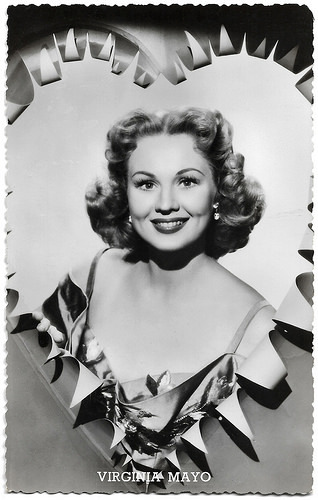
Dutch postcard by Van Leer's Fotodrukindustrie N.V., Amsterdam, no. 251. Photo: Warner Bros.
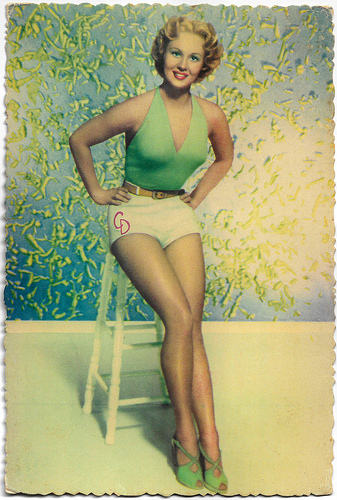
Spanish postcard by Archivo Bermejo, no. 4. Photo: Warner Bros, no. 3522. Photo: Warner Bros.
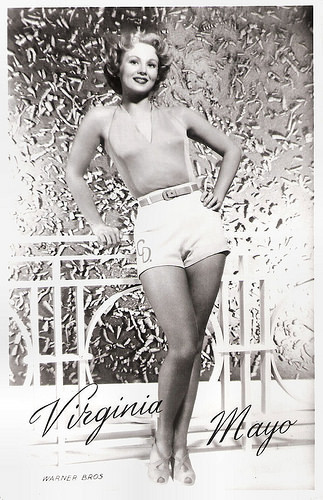
Dutch postcard by Takken, Utrecht, no. 694. Photo: Warner Bros.
An obvious ravishing beauty
Virginia Mayo was born Virginia Clara Jones in 1920 in St. Louis, Missouri. She was the daughter of a newspaper reporter Luke Jones and his wife, Martha Henrietta (née Rautenstrauch) Jones. The family had a rich heritage in the St. Louis area: Virginia's great-great-great-grandfather served in the American Revolution and later founded the city of East Saint Louis, Illinois, in 1797.
Virginia was interested in show business from an early age. Her aunt operated acting school and Virginia began taking acting and dance lessons at the age of six. After graduating from high school in 1937, she became a member of the St. Louis Municipal Opera. Impressed with her ability, performer Andy Mayo, recruited her to appear in his vaudeville act.
Still using her real name of Virginia Jones, she worked for three years in vaudeville with the Mayo Brothers, Mayo and his partner, Nonnie Morton. They did a performing horse act: 'Pansy the Horse' was comprised of Morton and Mayo and Virginia was the ringmaster and comedic foil for Pansy. They also appeared together in some short films.
In 1941 Jones, now known by the stage name Virginia Mayo, got another career break as she appeared on Broadway with Eddie Cantor in Banjo Eyes. After being spotted by an MGM talent scout during this Broadway revue, she was signed to a contract by movie mogul Samuel Goldwyn. Goldwyn only made a few films a year and would usually loan out the actors he had under contract to other producers.
David O. Selznick gave Virginia Mayo a screen test, but decided she wouldn't fit into films. She was slightly cross-eyed and had to be carefully photographed. Goldwyn, however, believed that her talent as an actress was there and producer Samuel Bronston cast her in a small role in Jack London (Alfred Santell, 1943) opposite her later husband Michael O'Shea. Later that same year, she had a walk-on part in Follies Girl (William Rowland, 1943) starring Wendy Barrie. Goldwyn gave her a bit part in Up in Arms (Elliott Nugent, 1944), starring Danny Kaye in his film debut. Then RKO borrowed her for a supporting role in a musical, Seven Days Ashore (John H. Auer, 1944).
Believing there was more to her than her obvious ravishing beauty, producers thought it was time to give her bigger and better roles. In 1944 she was cast as Princess Margaret in The Princess and the Pirate (David Butler, 1944), with comedian Bob Hope. It was a spoof of pirate movies and earned over $3 million at the box office. A year later she appeared in Wonder Man (H. Bruce Humberstone, 1945) as the leading lady of Danny Kaye. The film was very popular and so was the radiantly beautiful blonde star.
Her roles may have been coming in slow, but with each one her popularity with audiences rose. Virginia was cast in two more films in 1946, The Kid from Brooklyn (Norman Z. McLeod, 1946), again with Danny Kaye, and The Best Years of our Lives (William Wyler, 1946). She went against previous stereotype, and played the unsympathetic, gold-digger Marie Derry who becomes Dana Andrews' unfaithful wife. For this supporting role she received good notices. The film became the highest-grossing film in the US since Gone with the Wind (Victor Fleming, 1939).
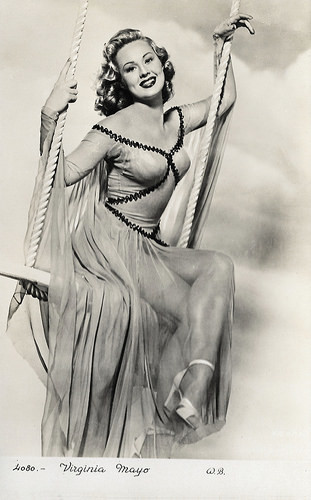
Vintage postcard, no. 4080. Photo: Warner Bros.
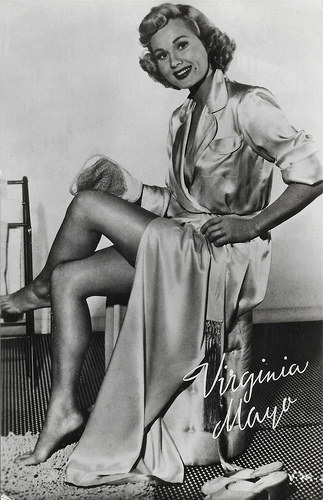
Dutch postcard by DRC, no. F 151. Photo: Warner Bros.
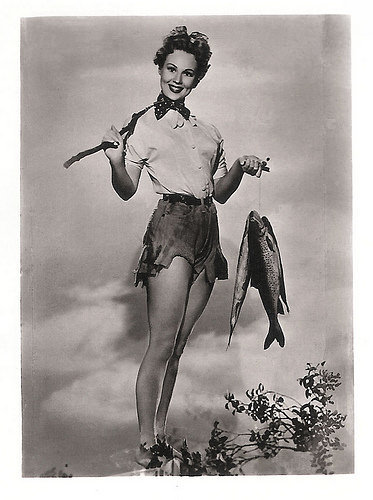
German collectors card in the series E - Filmstars der Welt 2. Band by Greilings-sammelbilder, no. 163. Photo: Hamann / Meyerpress.
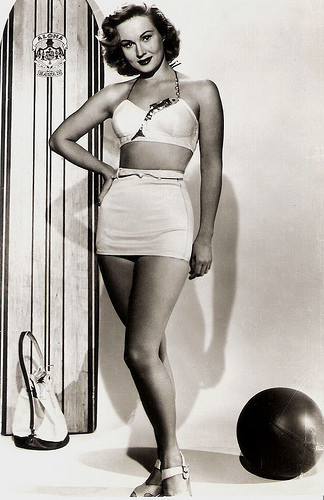
Spanish postcard, no. 240/4224. Photo: Archivo Bermejo.
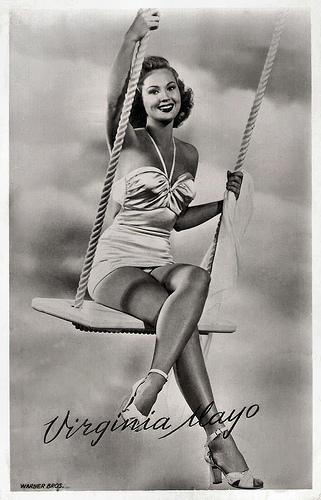
Dutch postcard. Photo: Warner Bros.
The scheming, cheating wife of a homicidal killer
Virginia Mayo finally struck pay-dirt in 1947 with a plum assignment in the well-received fantasy-comedy The Secret Life of Walter Mitty (Norman Z. McLeod, 1947) as the gorgeous Rosalind van Hoorn, who uses clumsy, daydreaming Walter Mitty (Danny Kaye) to escape from her pursuer. Walter unintentionally gets involved with a dangerous ring of spies that are seeking a black book with notes about a hidden treasure. Her next film together with Kaye, A Song is Born (Howard Hawks, 1948), was a box office disappointment.
Warner Bros ended up taking over her contract from Goldwyn. Mayo got some of the best reviews of her career in James Cagney's return to the gangster genre, White Heat (Raoul Walsh, 1949), as Verna, the scheming, cheating wife of homicidal killer Cody Jarrett (Cagney). She was in another huge hit The Flame and the Arrow (Jacques Tourneur, 1950) as Burt Lancaster 's love interest.
The striking beauty had still more plum roles in the 1950s. She starred in the Film Noir Backfire (Vincent Sherman, 1950) opposite Gordon MacRae. She co-starred again with James Cagney and a young Doris Day in The West Point Story (Roy Del Ruth 1950), singing and dancing with Cagney, and was Gregory Peck's leading lady in Captain Horatio Hornblower (Raoul Walsh, 1951), Warners most popular film of the year. She costarred with Kirk Douglas in his first Western, Along the Great Divide (Raoul Walsh, 1951).
Parts in the musical She's Working Her Way Through College (H. Bruce Humberstone, 1952) with Ronald Reagan, a biopic of pioneer Jim Bowie The Iron Mistress (Gordon Douglas, 1952) featuring Alan Ladd, and the action-adventure South Sea Woman (Arthur Lubin, 1953) with Burt Lancaster , showed she was still a force to be reckoned with. Although her vocals were always dubbed, she enjoyed doing musicals like She's Working Her Way Through College because she got to dance.
Virginia Mayo co-starred with Rex Harrison and George Sanders in King Richard and the Crusaders (David Butler, 1954) She was Paul Newman's first on-screen leading lady, in the Biblical Epic The Silver Chalice (Victor Saville, 1954). But the film was a notorious flop. She was Cleopatra in the guilty pleasure The Story of Mankind (Irwin Allen, 1957), which tries and fails to jam the entire history of humankind into 100 minutes.
As the decade ended, Virginia's career began to slow down. She began guest starring on television shows such as Conflict (1957), Wagon Train (1958), The Loretta Young Show/Letter to Loretta (1958), and Lux Playhouse (1959). Mayo and her husband made a pilot for a TV series McGarry and His Mouse (Norman Tokar, 1960), which was not picked up. She went to Italy to make the Peplum La rivolta dei mercenari/Revolt of the Mercenaries (Piero Costa, 1961) opposite Spanish actor Conrado San Martin. She had four film roles in the 1960s and four more in the following decade.
Mayo appeared on stage in shows like That Certain Girl (1967) and Barefoot in the Park (1968). She continued to act on stage for the rest of her career, mostly in dinner theatre and touring shows. She guest starred on TV shows such as Burke's Law (1965), Daktari (1967), Santa Barbara (1984) and The Love Boat (1986). Among her last films were the horror films Evil Spirits (Gary Graver, 1990) starring Karen Black, and The Man Next Door (Rod C. Spence, 1997).
Virginia Mayo died of pneumonia and complications of congestive heart failure at a nursing home in Thousand Oaks, Los Angeles, in 2005. She was 84. In 1947 she had married actor Michael O'Shea and remained with him until his death in 1973. The couple had a daughter, Mary Catherine O'Shea, in 1953.
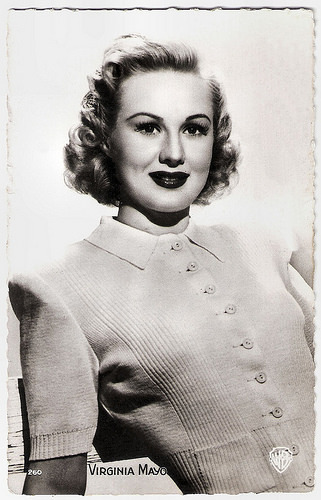
French postcard by Edition P.I., Paris, no. 260. Photo: Warner Bros
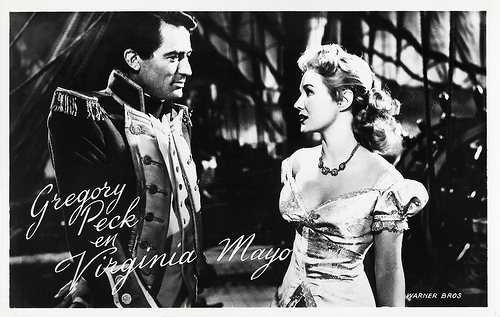
Dutch postcard by Takken, Utrecht, no. 610. Photo: Warner Bros. Publicity still for Captain Horatio Hornblower (Raoul Walsh, 1951) with Gregory Peck.
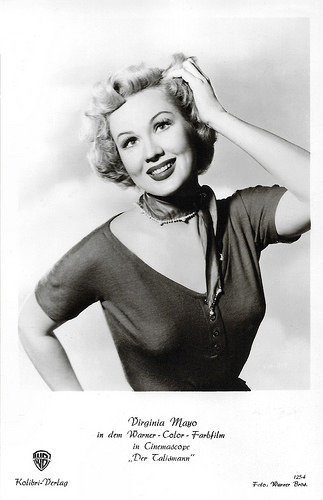
German postcard by Kolibri-Verlag, no. 1254. Photo: Warner Bros. Publicity still for King Richard and the Crusaders (David Butler, 1954).
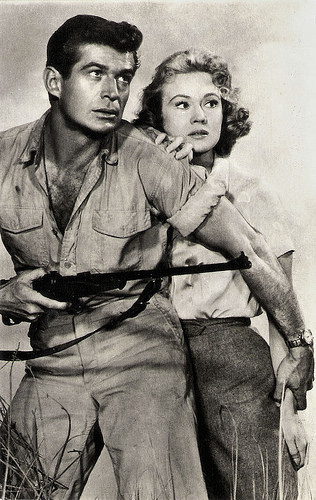
Spanish postcard by F.A.G., no. 440. Photo: Universal. Publicity still for Congo Crossing (Joseph Pevney, 1956) with George Nader .
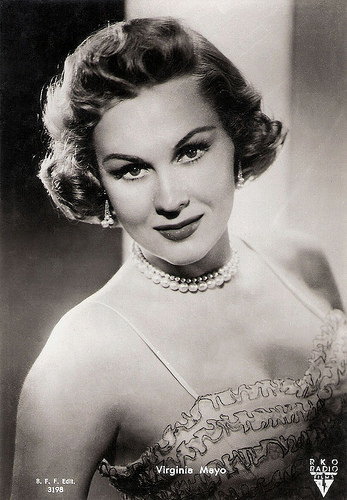
Italian postcard by Casa Editrice Ballerini & Fratini, Firenze (B.F.F.), no. 3198. Photo: RKO Radio Films.
Sources: Hal Erickson (AllMovie), (IMDb), Wikipedia and .

Dutch postcard, no. 3522. Photo: Warner Bros.

Vintage postcard by GM. Photo: Warner Bros.

Dutch postcard by Van Leer's Fotodrukindustrie N.V., Amsterdam, no. 251. Photo: Warner Bros.

Spanish postcard by Archivo Bermejo, no. 4. Photo: Warner Bros, no. 3522. Photo: Warner Bros.

Dutch postcard by Takken, Utrecht, no. 694. Photo: Warner Bros.
An obvious ravishing beauty
Virginia Mayo was born Virginia Clara Jones in 1920 in St. Louis, Missouri. She was the daughter of a newspaper reporter Luke Jones and his wife, Martha Henrietta (née Rautenstrauch) Jones. The family had a rich heritage in the St. Louis area: Virginia's great-great-great-grandfather served in the American Revolution and later founded the city of East Saint Louis, Illinois, in 1797.
Virginia was interested in show business from an early age. Her aunt operated acting school and Virginia began taking acting and dance lessons at the age of six. After graduating from high school in 1937, she became a member of the St. Louis Municipal Opera. Impressed with her ability, performer Andy Mayo, recruited her to appear in his vaudeville act.
Still using her real name of Virginia Jones, she worked for three years in vaudeville with the Mayo Brothers, Mayo and his partner, Nonnie Morton. They did a performing horse act: 'Pansy the Horse' was comprised of Morton and Mayo and Virginia was the ringmaster and comedic foil for Pansy. They also appeared together in some short films.
In 1941 Jones, now known by the stage name Virginia Mayo, got another career break as she appeared on Broadway with Eddie Cantor in Banjo Eyes. After being spotted by an MGM talent scout during this Broadway revue, she was signed to a contract by movie mogul Samuel Goldwyn. Goldwyn only made a few films a year and would usually loan out the actors he had under contract to other producers.
David O. Selznick gave Virginia Mayo a screen test, but decided she wouldn't fit into films. She was slightly cross-eyed and had to be carefully photographed. Goldwyn, however, believed that her talent as an actress was there and producer Samuel Bronston cast her in a small role in Jack London (Alfred Santell, 1943) opposite her later husband Michael O'Shea. Later that same year, she had a walk-on part in Follies Girl (William Rowland, 1943) starring Wendy Barrie. Goldwyn gave her a bit part in Up in Arms (Elliott Nugent, 1944), starring Danny Kaye in his film debut. Then RKO borrowed her for a supporting role in a musical, Seven Days Ashore (John H. Auer, 1944).
Believing there was more to her than her obvious ravishing beauty, producers thought it was time to give her bigger and better roles. In 1944 she was cast as Princess Margaret in The Princess and the Pirate (David Butler, 1944), with comedian Bob Hope. It was a spoof of pirate movies and earned over $3 million at the box office. A year later she appeared in Wonder Man (H. Bruce Humberstone, 1945) as the leading lady of Danny Kaye. The film was very popular and so was the radiantly beautiful blonde star.
Her roles may have been coming in slow, but with each one her popularity with audiences rose. Virginia was cast in two more films in 1946, The Kid from Brooklyn (Norman Z. McLeod, 1946), again with Danny Kaye, and The Best Years of our Lives (William Wyler, 1946). She went against previous stereotype, and played the unsympathetic, gold-digger Marie Derry who becomes Dana Andrews' unfaithful wife. For this supporting role she received good notices. The film became the highest-grossing film in the US since Gone with the Wind (Victor Fleming, 1939).

Vintage postcard, no. 4080. Photo: Warner Bros.

Dutch postcard by DRC, no. F 151. Photo: Warner Bros.

German collectors card in the series E - Filmstars der Welt 2. Band by Greilings-sammelbilder, no. 163. Photo: Hamann / Meyerpress.

Spanish postcard, no. 240/4224. Photo: Archivo Bermejo.

Dutch postcard. Photo: Warner Bros.
The scheming, cheating wife of a homicidal killer
Virginia Mayo finally struck pay-dirt in 1947 with a plum assignment in the well-received fantasy-comedy The Secret Life of Walter Mitty (Norman Z. McLeod, 1947) as the gorgeous Rosalind van Hoorn, who uses clumsy, daydreaming Walter Mitty (Danny Kaye) to escape from her pursuer. Walter unintentionally gets involved with a dangerous ring of spies that are seeking a black book with notes about a hidden treasure. Her next film together with Kaye, A Song is Born (Howard Hawks, 1948), was a box office disappointment.
Warner Bros ended up taking over her contract from Goldwyn. Mayo got some of the best reviews of her career in James Cagney's return to the gangster genre, White Heat (Raoul Walsh, 1949), as Verna, the scheming, cheating wife of homicidal killer Cody Jarrett (Cagney). She was in another huge hit The Flame and the Arrow (Jacques Tourneur, 1950) as Burt Lancaster 's love interest.
The striking beauty had still more plum roles in the 1950s. She starred in the Film Noir Backfire (Vincent Sherman, 1950) opposite Gordon MacRae. She co-starred again with James Cagney and a young Doris Day in The West Point Story (Roy Del Ruth 1950), singing and dancing with Cagney, and was Gregory Peck's leading lady in Captain Horatio Hornblower (Raoul Walsh, 1951), Warners most popular film of the year. She costarred with Kirk Douglas in his first Western, Along the Great Divide (Raoul Walsh, 1951).
Parts in the musical She's Working Her Way Through College (H. Bruce Humberstone, 1952) with Ronald Reagan, a biopic of pioneer Jim Bowie The Iron Mistress (Gordon Douglas, 1952) featuring Alan Ladd, and the action-adventure South Sea Woman (Arthur Lubin, 1953) with Burt Lancaster , showed she was still a force to be reckoned with. Although her vocals were always dubbed, she enjoyed doing musicals like She's Working Her Way Through College because she got to dance.
Virginia Mayo co-starred with Rex Harrison and George Sanders in King Richard and the Crusaders (David Butler, 1954) She was Paul Newman's first on-screen leading lady, in the Biblical Epic The Silver Chalice (Victor Saville, 1954). But the film was a notorious flop. She was Cleopatra in the guilty pleasure The Story of Mankind (Irwin Allen, 1957), which tries and fails to jam the entire history of humankind into 100 minutes.
As the decade ended, Virginia's career began to slow down. She began guest starring on television shows such as Conflict (1957), Wagon Train (1958), The Loretta Young Show/Letter to Loretta (1958), and Lux Playhouse (1959). Mayo and her husband made a pilot for a TV series McGarry and His Mouse (Norman Tokar, 1960), which was not picked up. She went to Italy to make the Peplum La rivolta dei mercenari/Revolt of the Mercenaries (Piero Costa, 1961) opposite Spanish actor Conrado San Martin. She had four film roles in the 1960s and four more in the following decade.
Mayo appeared on stage in shows like That Certain Girl (1967) and Barefoot in the Park (1968). She continued to act on stage for the rest of her career, mostly in dinner theatre and touring shows. She guest starred on TV shows such as Burke's Law (1965), Daktari (1967), Santa Barbara (1984) and The Love Boat (1986). Among her last films were the horror films Evil Spirits (Gary Graver, 1990) starring Karen Black, and The Man Next Door (Rod C. Spence, 1997).
Virginia Mayo died of pneumonia and complications of congestive heart failure at a nursing home in Thousand Oaks, Los Angeles, in 2005. She was 84. In 1947 she had married actor Michael O'Shea and remained with him until his death in 1973. The couple had a daughter, Mary Catherine O'Shea, in 1953.

French postcard by Edition P.I., Paris, no. 260. Photo: Warner Bros

Dutch postcard by Takken, Utrecht, no. 610. Photo: Warner Bros. Publicity still for Captain Horatio Hornblower (Raoul Walsh, 1951) with Gregory Peck.

German postcard by Kolibri-Verlag, no. 1254. Photo: Warner Bros. Publicity still for King Richard and the Crusaders (David Butler, 1954).

Spanish postcard by F.A.G., no. 440. Photo: Universal. Publicity still for Congo Crossing (Joseph Pevney, 1956) with George Nader .

Italian postcard by Casa Editrice Ballerini & Fratini, Firenze (B.F.F.), no. 3198. Photo: RKO Radio Films.
Sources: Hal Erickson (AllMovie), (IMDb), Wikipedia and .
Published on December 08, 2018 22:00
December 7, 2018
Photo by United Artists
The credits of United Artists Corporation (UA) include Charlie Chaplin and Buster Keaton classics, Stanley Kubrick's Paths of Glory, the James Bond films, the best work of Billy Wilder, hits like High Noon (1952), The Magnificent Seven (1960), West Side Story (1962), Best Picture Oscar winners like Marty (1955), One Flew over the Cuckoo's Nest (1975), Annie Hall (1977), Rain Man (1986), etc. The American studio was founded in 1919 by director D. W. Griffith, and stars Charlie Chaplin, Mary Pickford, and Douglas Fairbanks, then already heavyweights in the rapidly growing film industry. All four were seeking to gain financial and artistic control over producing and distributing their films, rather than being dependent upon commercial studios. United Artists quickly gained prestige in Hollywood, thanks to the success of the films of its stars. Over the ensuing century, UA was repeatedly bought, sold, and restructured, but it survived.
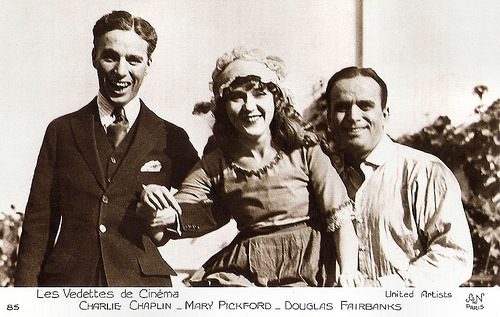
Charlie Chaplin , Mary Pickford and Douglas Fairbanks . French postcard in the Les Vedettes de Cinéma series by A.N., Paris, no. 85. Photo: United Artists.
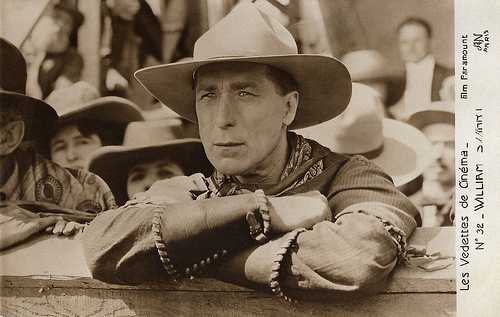
William S. Hart. French postcard by A.N. in the Les Vedettes de Cinéma series, Paris, no. 32. Photo: Film Paramount.
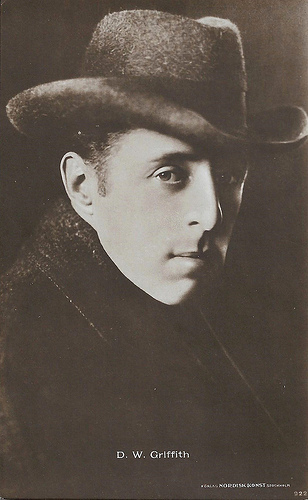
A rare portrait of the famous American film director D.W. Griffith. Swedish postcard by Förlag Nordisk Konst, Stockholm, no. 922.
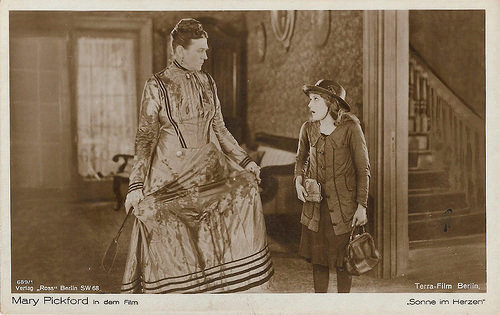
German postcard by Ross Verlag, Berlin, no. 689/1, 1919-1924. Photo: Terra-Film, Berlin. Publicity still of Katherine Griffith and Mary Pickford in the film Pollyanna (Paul Powell, 1920), released in Germany as Sonne im Herzen (Sunshine in her Heart).
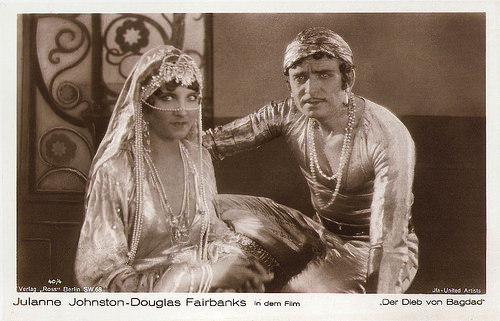
German postcard by Ross Verlag, Berlin, no. 40/4. Photo: IFA / United Artists. Publicity still for The Thief of Bagdad (Raoul Walsh, 1924), featuring Douglas Fairbanks and with Julanne Johnston as the Princess.
The inmates are taking over the asylum
In the spring of 1919, four of the most popular figures in the American cinema, director David Wark Griffith, Mary Pickford, Charlie Chaplin and Douglas Fairbanks incorporated United Artists as a joint venture. Each held a 25 percent stake in the preferred shares and a 20 percent stake in the common shares of the joint venture, with the remaining 20 percent of common shares held by lawyer and adviser William Gibbs McAdoo. The idea for the venture originated with Fairbanks, Chaplin, Pickford and cowboy star William S. Hart a year earlier. Already Hollywood veterans, the four stars talked of forming their own company to better control their own work.
They were spurred on by established Hollywood producers and distributors who were tightening their control over actor salaries and creative decisions, a process that evolved into the studio system. With the addition of Griffith, planning began, but Hart bowed out before anything was formalised. The four partners, with advice from McAdoo (son-in-law and former Treasury Secretary of then-President Woodrow Wilson), formed their distribution company. Hard-nosed executives were immensely sceptical right from the outset at the idea that artists and film-makers could run a studio. When he heard about their scheme, Richard A. Rowland, head of Metro Pictures, was quoted saying "The inmates are taking over the asylum." Richard Thomson in The Guardian : "It was a great line, but it was also an unfair assertion that the business was a crazy house - and thus beyond control. In fact, the idea was common sense, and that is why it has never gone away."
The original terms called for each star to produce five pictures a year. By the time the company was operational in 1921, feature films were becoming more expensive and polished, and running times had settled at around ninety minutes (eight reels). The original goal was thus abandoned. UA's first film, His Majesty, the American (Joseph Henabery, 1919), written by and starring Douglas Fairbanks , was a success. Mary Pickford gave UA plenty of product - Pollyanna (Paul Powell, 1920), Little Lord Fauntleroy (Alfred E. Green, Jack Pickford, 1921) and Tess of the Storm Country (John S. Robertson, 1922). Fairbanks delivered The Three Musketeers (Fred Niblo, 1921), Robin Hood (Allan Dwan, 1922) and the epic fantasy, The Thief of Bagdad (Raoul Walsh, 1924).
In addition, the UA logo carried the Griffith masterpieces Broken Blossoms (David Wark Griffith, 1919), Way Down East (David Wark Griffith, 1920) and Orphans of the Storm (David Wark Griffith, 1921), all starring Lillian Gish. The reputation of UA was growing. However, funding for films was limited. Without selling stock to the public like other studios, all United had for finance was weekly prepayment instalments from theatre owners for upcoming films. As a result, production was slow, and the company distributed an average of only five films a year in its first five years.
By 1924, Griffith had dropped out, and the company was facing a crisis. The alternatives were to either bring in others to help support a costly distribution system or concede defeat. Veteran producer Joseph Schenck was hired as president. He had produced pictures for a decade, and brought commitments for films starring his wife, Norma Talmadge, his sister-in-law, Constance Talmadge, and his brother-in-law, Buster Keaton. A few years later, UA could claim Sparrows (William Beaudine, 1926) in which Mary Pickford rescues a band of orphans from a swampy labour camp, Keaton's The General (Clyde Bruckman, Buster Keaton, 1927), Douglas Fairbanks in The Gaucho (F. Richard Jones, 1927) with Lupe Velez, and Gloria Swanson's production of Sadie Thompson (Raoul Walsh, 1928).
Inevitably, given that its founders were titans of the silent era, UA struggled to make the transition to sound film. Fairbanks and Keaton had faded away. Pickford concentrated on producing after she retired from acting. But Charles Chaplin created a perfect blend of comedy and melodrama in City Lights (Charles Chaplin, 1931), followed by his most socially engaged film, Modern Times (Charles Chaplin, 1936). Contracts were signed with independent producers, most notably Samuel Goldwyn, and Howard Hughes with his Hell's Angels (Howard Hughes, 1930) with Ben Lyon. UA also benefited from such newcomers as Alexander Korda, producing in England but breaking into the American market with The Private Life of Henry VIII (Alexander Korda, 1933) with Charles Laughton , The Scarlet Pimpernel (Harold Young, 1934) with Leslie Howard and Merle Oberon , and Things to Come (William Cameron Menzies, 1936). And in the mid-1930s, UA was reporting profits of over a million dollars a year.
In 1933, Schenck organised a new company with Darryl F. Zanuck, called Twentieth Century Pictures, which soon provided four pictures a year, forming half of UA's schedule. Schenck formed a separate partnership with Pickford and Chaplin to buy and build theatres under the United Artists name. They began international operations, first in Canada, and then in Mexico. By the end of the 1930s, United Artists was represented in over 40 countries. When he was denied an ownership share in 1935, Schenck resigned. He set up 20th Century Pictures' merger with Fox Film Corporation to form 20th Century Fox. Al Lichtman succeeded Schenck as company president. Other independent producers distributed through United Artists in the 1930s included Walt Disney Productions, Hal Roach, and Walter Wanger. In 1935 UA concluded a deal with David Selznick when he went independent. But as the years passed, and the dynamics of the business changed, these producing partners drifted away.
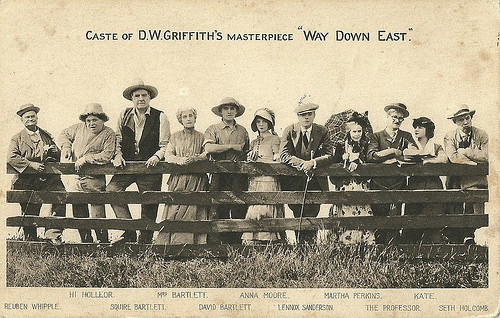
The cast of Way Down East (D.W. Griffith, 1920). British postcard by Cinema Art, London. From left to right, the actors George Neville, Edgar Nelson, Burr McIntosh, Kate Bruce, Richard Barthelmess, Lillian Gish , Lowell Sherman, Vivia Ogden, Creighton Hale, Mary Hay and Porter Strong.
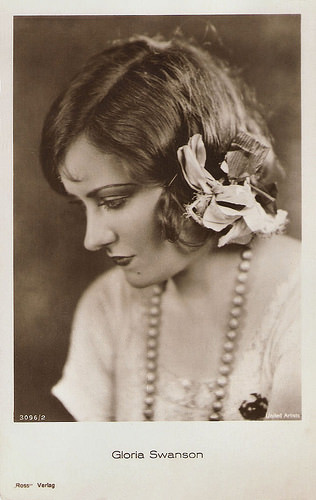
Gloria Swanson . German postcard by Ross Verlag, no. 3096/2, 1928-1929. Photo: United Artists. Publicity still for Sadie Thompson (Raoul Walsh, 1928).
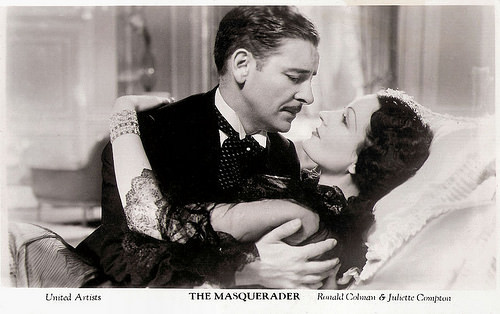
Ronald Colman and Juliet Compton. British postcard in the Filmshots series by Film Weekly. Photo: United Artists. Publicity still for The Masquerader (Richard Wallace, 1933).
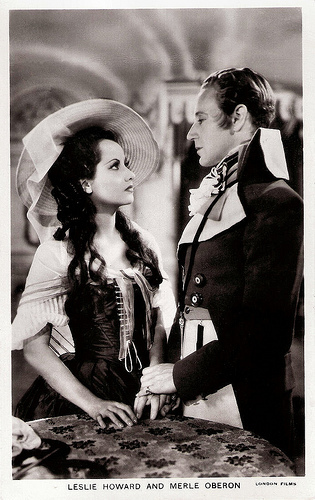
Leslie Howard and Merle Oberon . British postcard in the Film Partners Series, London, no. P 150. Photo: London Films. Publicity still for The Scarlet Pimpernel (Harold Young, 1934).
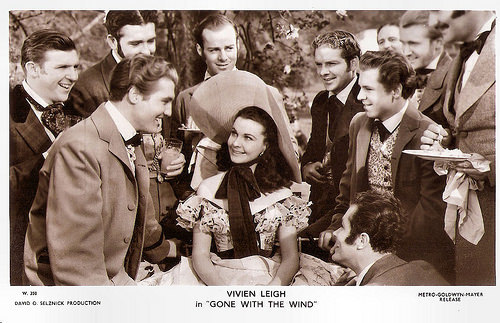
Vivien Leigh . British postcard in the Picturegoer Series, London, no. W. 350. Photo: David O'Selznick Production / Metro-Goldwyn-Mayer. Publicity still for Gone with the Wind (Victor Fleming, 1939).
A focal point for independent producing
In the late 1930s, United Artists turned a profit. Goldwyn was providing most of the output for distribution. He sued United several times for disputed compensation leading him to leave to RKO. Disney also went to RKO and Wanger to Universal Pictures. MGM's 1939 hit Gone with the Wind was supposed to be a UA release except that David O'Selznick wanted Clark Gable, who was under contract to MGM, to play Rhett Butler. Also that year, Fairbanks died. But the following year, Selznick's Rebecca (Alfred Hitchcock, 1940) did win the Best Picture Oscar, in a field where four other UA films were nominated - the Walter Wanger production Foreign Correspondent (Alfred Hitchcock, 1940), The Great Dictator (Charles Chaplin, 1940), Wanger's The Long Voyage Home (John Ford, 1940), and Sol Lesser's Our Town (Sam Wood, 1940). At that peak, UA had no studio and no theatres, but it was a focal point for independent producing, with over 20 films a year and a domestic gross exceeding $10m.
In 1941, Pickford, Chaplin, Disney, Orson Welles , Goldwyn, Selznick, Alexander Korda, and Wanger — many of whom were members of United Artists - formed the Society of Independent Motion Picture Producers (SIMPP). Later members included Hunt Stromberg, William Cagney, Sol Lesser, and Hal Roach. The Society aimed to advance the interests of independent producers in an industry controlled by the studio system. SIMPP fought to end ostensibly anti-competitive practices by the seven major film studios — Loew's (MGM), Columbia Pictures, Paramount Pictures, Universal Pictures, RKO Radio Pictures, 20th Century Fox, and Warner Bros./First National — that controlled the production, distribution, and exhibition of motion pictures.
In 1942, SIMPP filed an antitrust suit against Paramount's United Detroit Theatres. The complaint accused Paramount of conspiracy to control first-and subsequent-run theatres in Detroit. This was the first antitrust suit brought by producers against exhibitors that alleged monopoly and restraint of trade. In 1948, the U.S. Supreme Court Paramount Decision ordered the major Hollywood movie studios to sell their theatre chains and to end certain anti-competitive practices. This court ruling ended the studio system. By 1958, SIMPP achieved many of the goals that led to its creation, and the group ceased operations.
In the 1940s, United Artists became embroiled in lawsuits with Selznick over his distribution of some films through RKO. Selznick considered UA's operation sloppy, and left to start his own distribution arm. Cinema attendance continued to decline as television became more popular. Needing a turnaround, Pickford and Chaplin hired Paul V. McNutt, a former governor of Indiana, as chairman and Frank L. McNamee as president. McNutt did not have the skill to solve UA's financial problems and the pair was replaced after only a few months. On February 16, 1951, lawyers-turned-producers Arthur B. Krim of Eagle-Lion Films and Robert Benjamin came to Pickford and Chaplin, the surviving founders, with a proposal: let them take over United Artists for five years. If, at the end of those years, UA was profitable, they would earn an option to buy it. The aging stars agreed, and so began the busiest and richest period in the company’s history.
UA flourished and carried some remarkable films, all of which had reason to be grateful for the extra independence they enjoyed. In taking over UA, Krim and Benjamin created the first studio without an actual studio. Fox Film Corporation president Spyros Skouras extended United Artists a $3 million loan through Krim and Benjamin's efforts.Primarily acting as bankers, they offered money to independent producers. UA leased space at the Pickford/Fairbanks Studio but did not own a studio lot. Thus UA did not have the overhead, the maintenance, or the expensive production staff at other studios. They had two hits, The African Queen (John Huston, 1951) with Humphrey Bogart and Katharine Hepburn, and High Noon (Fred Zinnemann, 1952) with Gary Cooper and Grace Kelly , turning a profit in their first year. Among their first clients were Sam Spiegel and John Huston, whose Horizon Productions gave UA one major hit, The African Queen (John Huston, 1951) and a substantial success, Moulin Rouge (John Huston, 1952) with José Ferrer.
Other clients were Stanley Kramer, Otto Preminger, Hecht-Hill-Lancaster — a production company Burt Lancaster founded with his agent, Harold Hecht, and the writer-producer James Hill — , and actors newly freed from studio contracts and seeking to produce or direct their own films. It resulted in prestige productions like The Man With the Golden Arm (Otto Preminger, 1955) starring Frank Sinatra and Kim Novak , The Defiant Ones (Stanley Kramer, 1958) with Tony Curtis and Sidney Poitier, and Marty (Delbert Mann, 1955) which gave United Artists its first best-picture Oscar.
With the instability in the film industry due to theatre divestment, the business was considered risky. In 1955, film attendance reached its lowest level since 1923. Chaplin sold his 25 percent share during this crisis to Krim and Benjamin for $1.1 million, followed a year later by Pickford who sold her share for $3 million. In these years, Stanley Kubrick made two of his important early films for the studio, The Killing (Stanley Kubrick, 1956) and Paths of Glory (Stanley Kubrick, 1957), with Kirk Douglas . Another interesting film was Charles Laughton ’s sublime, heartfelt homage to D.W. Griffith, Night of the Hunter (Charles Laughton, 1955), starring Robert Mitchum .
In 1957, United Artists went public with a $17 million stock and debenture offering. The company was averaging 50 films a year. In 1958, UA acquired Ilya Lopert's Lopert Pictures Corporation, which released foreign films that attracted criticism or had censorship problems. In 1959, after failing to sell several pilots, United Artists offered its first ever television series, The Troubleshooters, and later released its first sitcom, The Dennis O'Keefe Show. In the cinema there were successes with Witness for the Prosecution (Billy Wilder, 1957), and Some Like It Hot (Billy Wilder, 1959), starring Marilyn Monroe , Jack Lemmon and Tony Curtis.

Lupe Velez. French postcard by Europe, no. 470. Photo: Regal Film United Artists.
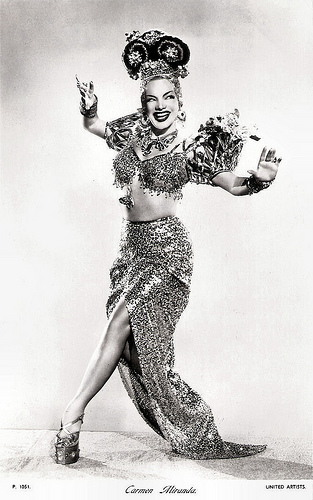
Carmen Miranda. British postcard in 'The People' series by Show Parade Picture Service, London, no. P. 1051. Photo: Virgil Apger / United Artists.
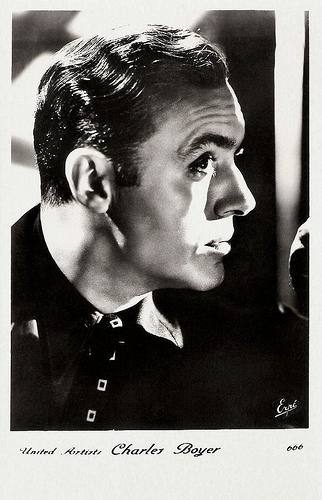
Charles Boyer . French postcard by Erpé, no. 666. Photo: United Artists. Publicity still for Algiers (John Cromwell, 1938).
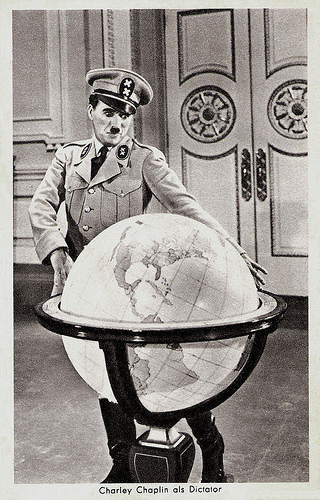
Charles Chaplin . Dutch postcard. Sent by mail in the Netherlands in 1948. Photo: publicity still for The Great Dictator (Charles Chaplin, 1940).
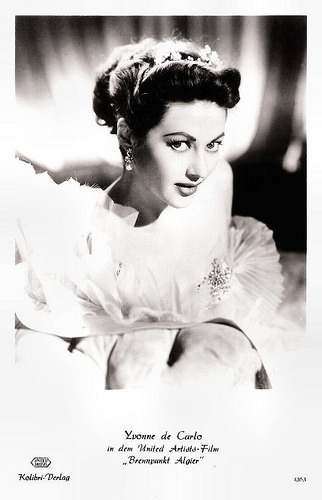
Yvonne De Carlo . German postcard by Kolibri-Verlag, no. 1363. Photo: United Artists. Publicity still for Fort Algiers (Lesley Selander, 1953).
The end of the great days
In the 1960s, mainstream studios fell into decline and some were acquired or diversified. UA prospered while winning 11 Academy Awards, including five for Best Picture, adding relationships with the Mirisch brothers, Billy Wilder, Joseph E. Levine and others. In 1961, United Artists released West Side Story (Robert Wise, 1961), which won a record ten Academy Awards including Best Picture. Because United Artists did not feel constrained by the moral strictures of the Production Code, it was able to move quickly as social mores changed in the 1960s. In those heady days it released films like The Apartment (Billy Wilder, 1960), Tom Jones (Tony Richardson, 1963), and The Manchurian Candidate (John Frankenheimer, 1962), films with a sexual and political edge that the more conservative majors could not equal.
UA's television division was responsible for shows such as Gilligan's Island, The Fugitive, Outer Limits, and The Patty Duke Show. The television unit had begun to build up a profitable rental library, including Associated Artists Productions, owners of Warner Bros. pre-1950 features, shorts and cartoons and 231 Popeye cartoon shorts purchased from Paramount Pictures in 1958, becoming United Artists Associated, its distribution division.
In 1963, UA released two Stanley Kramer films, It's A Mad, Mad, Mad, Mad World (Stanley Kramer, 1963) with Spencer Tracy, and A Child Is Waiting (John Cassavetes, 1963) with Burt Lancaster and Judy Garland. In 1964, UA introduced U.S. film audiences to The Beatles by releasing A Hard Day's Night (Richard Lester, 1964) and Help! (Richard Lester, 1965). At the same time, it backed two expatriate North Americans in Britain, who had acquired screen rights to Ian Fleming's James Bond novels. For $1 million, UA backed Harry Saltzman and Albert Broccoli's Dr. No in 1963 and launched the James Bond franchise. The franchise outlived UA's time as a major studio, continuing half a century later. Other successful projects backed in this period included the Pink Panther series, which began in 1964, and Spaghetti Westerns, which made a star of Clint Eastwood .
On the basis of its film and television hits, in 1967, Transamerica Corporation purchased 98 percent of UA's stock. Transamerica selected David and Arnold Picker to lead its studio. UA debuted a new logo incorporating the parent company's striped T emblem and the tagline "Entertainment from Transamerica Corporation". UA released another Best Picture Oscar winner in 1967, In the Heat of the Night (Norman Jewison, 1967) starring Sidney Poitier, and a nominee for Best Picture, The Graduate (Mike Nichols, 1967), an Embassy production that UA distributed overseas. In 1970, UA lost $35 million; thus the Pickers were pushed aside for the return of Krim and Benjamin. Other successful pictures included the screen version of Fiddler on the Roof (Norman Jewison, 1971). However, the film version of Man of La Mancha (Arthur Hiller, 1972) with Peter O'Toole and Sophia Loren , was a failure. New talent was encouraged, including Woody Allen, Robert Altman, Sylvester Stallone, Saul Zaentz, Miloš Forman, and Brian De Palma. In 1973, United Artists took over the sales and distribution of MGM's films in Anglo-America.
In 1975, Harry Saltzman sold UA his 50 percent stake in Danjaq, the holding-company for the Bond films. UA was to remain a silent partner, providing money, while Albert Broccoli took producer credit. Danjaq and UA remained the public co-copyright holders for the Bond series, and the 2006 Casino Royale (Martin Campbell, 2006) remake shares the copyright with Columbia Pictures. UA released One Flew Over the Cuckoo's Nest (Milos Forman, 1975) with Jack Nicholson, which won the Best Picture Academy Award and earned $56 million. UA followed with the next two years' Best Picture Oscar winners, Rocky (John G. Avildsen, 1976) and Annie Hall (Woody Allen, 1977).
However, Transamerica was not pleased with UA's releases such as Midnight Cowboy (John Schlesinger, 1969) and the sexually explicit Ultimo tango a Parigi/Last Tango in Paris (Bernardo Bertolucci, 1972) with Marlon Brando , that were rated X by the Motion Picture Association of America. In these instances, Transamerica demanded the byline 'A Transamerica Company' be removed on the prints and in all advertising. At one point, the parent company expressed its desire to phase out the UA name and replace it with Transamerica Films. Krim tried to convince Transamerica to spin off United Artists, but he and Transamerica's chairman could not come to an agreement.
Finally in 1978, following a dispute with Transamerica chief John R. Beckett over administrative expenses, UA's top executives, including chairman Krim, president Eric Pleskow, Benjamin and other key officers walked out. Within days they announced the formation of Orion Pictures, with backing from Warner. The departures concerned several Hollywood figures enough that they took out an ad in a trade paper warning Transamerica that it had made a fatal mistake in letting them go. Transamerica inserted Andy Albeck as UA's president. UA remained courageous and enterprising, reflected in Coming Home (Hal Ashby, 1978), Apocalypse Now (Francis Coppola, 1979) and Raging Bull (Martin Scorsese, 1980) starring Robert de Niro .
United had its most successful year with four hits in 1979: Rocky II (Sylvester Stallone, 1979), Manhattan (Woody Allen, 1979), Moonraker (Lewis Gilbert, 1979), and The Black Stallion (Carroll Ballard, 1979). The new leadership had also agreed to back Heaven's Gate (1980), the pet project of director Michael Cimino. Cimino was regarded as a genius after The Deer Hunter (Michael Cimino, 1978) starring Robert de Niro . Initially set to cost about $6m, it ended up at least five times as expensive. Long before its release, it became a laughing stock and the worst example of Hollywood extravagance. This led to the resignation of Albeck who was replaced by Norbert Auerbach. United Artists recorded a major loss for the year due almost entirely to this fiasco. In 1980, Transamerica decided to exit the film making business, and put United Artists on the market.
That was the end of the great days. In 1981, TransAmerica sold the shell of UA to MGM, itself in free fall. In 1983 the two studios were merged to become MGM/UA Entertainment. In 1988, UA released another Best Picture winner, Rain Man (Barry Levinson, 1988), starring Tom Cruise and Dustin Hoffman. Somehow, United Artists remained the maverick studio until the 1990s, when it became a financial football, kicked around by various bankers, promoters and avaricious studios. The current United Artists company exists as a successor to the original as a provider of digital content, in addition to handling most of its post-1952 in-house library and other content it has since acquired.
Next year, United Artists will turn 100, having survived countless transformations and takeovers since the company released its first feature in 1919. David Thomson in The Guardian : "So it's time enough to propose one large birthday wish - that the jokes about the idiots and the asylum be retired, and the lesson learned, that the most creative people in the picture business should do all they can to look after each other. No one else is going to do it."
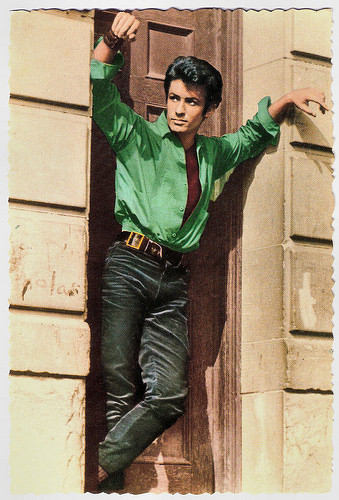
George Chakiris . Spanish postcard by Archivo Bermejo, no. C. 65, 1963. Photo: United Artists. Publicity still for West Side Story (Robert Wise, 1961).
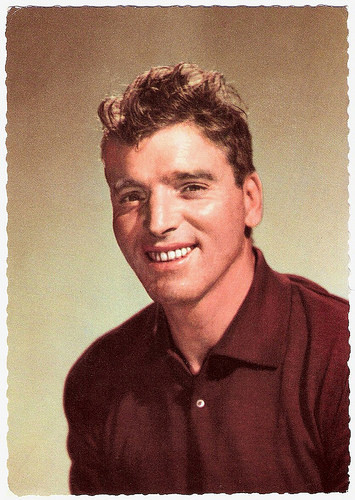
Burt Lancaster . German postcard by Ufa, Berlin-Tempelhof, no. CK-156. Photo: Sam Lévin.
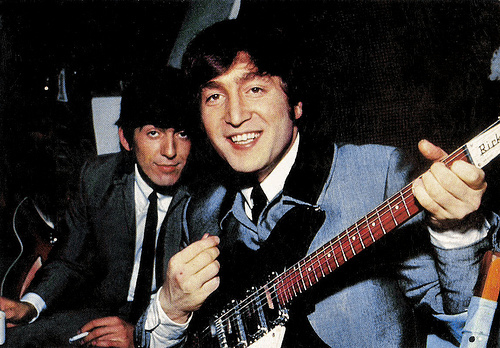
John Lennon and George Harrison of The Beatles . Spanish postcard by Oscarcolor, no. 347.
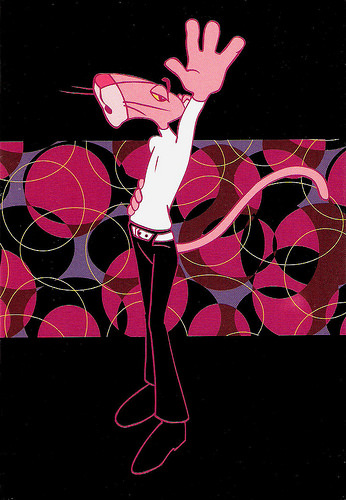
British postcard by Hotstamp Free Postcards, 1998. Image: United Artists. Caption: Too sexy for his fur. The colour of Cool Pink Panther.
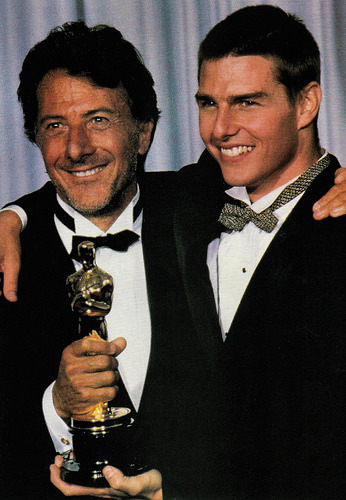
French postcard, no. SL. 4037. The Academy Awards Ceremony 1989: Dustin Hoffman wins Best Actor Oscar for Rain Man' (Barry Levinson, 1988), with co-star Tom Cruise.
Sources: David Thomson (The Guardian), Geoffrey Macnab (The Independent), Dave Kehr (The New York Times), History.com, Encyclopaedia Britannica, and Wikipedia.

Charlie Chaplin , Mary Pickford and Douglas Fairbanks . French postcard in the Les Vedettes de Cinéma series by A.N., Paris, no. 85. Photo: United Artists.

William S. Hart. French postcard by A.N. in the Les Vedettes de Cinéma series, Paris, no. 32. Photo: Film Paramount.

A rare portrait of the famous American film director D.W. Griffith. Swedish postcard by Förlag Nordisk Konst, Stockholm, no. 922.

German postcard by Ross Verlag, Berlin, no. 689/1, 1919-1924. Photo: Terra-Film, Berlin. Publicity still of Katherine Griffith and Mary Pickford in the film Pollyanna (Paul Powell, 1920), released in Germany as Sonne im Herzen (Sunshine in her Heart).

German postcard by Ross Verlag, Berlin, no. 40/4. Photo: IFA / United Artists. Publicity still for The Thief of Bagdad (Raoul Walsh, 1924), featuring Douglas Fairbanks and with Julanne Johnston as the Princess.
The inmates are taking over the asylum
In the spring of 1919, four of the most popular figures in the American cinema, director David Wark Griffith, Mary Pickford, Charlie Chaplin and Douglas Fairbanks incorporated United Artists as a joint venture. Each held a 25 percent stake in the preferred shares and a 20 percent stake in the common shares of the joint venture, with the remaining 20 percent of common shares held by lawyer and adviser William Gibbs McAdoo. The idea for the venture originated with Fairbanks, Chaplin, Pickford and cowboy star William S. Hart a year earlier. Already Hollywood veterans, the four stars talked of forming their own company to better control their own work.
They were spurred on by established Hollywood producers and distributors who were tightening their control over actor salaries and creative decisions, a process that evolved into the studio system. With the addition of Griffith, planning began, but Hart bowed out before anything was formalised. The four partners, with advice from McAdoo (son-in-law and former Treasury Secretary of then-President Woodrow Wilson), formed their distribution company. Hard-nosed executives were immensely sceptical right from the outset at the idea that artists and film-makers could run a studio. When he heard about their scheme, Richard A. Rowland, head of Metro Pictures, was quoted saying "The inmates are taking over the asylum." Richard Thomson in The Guardian : "It was a great line, but it was also an unfair assertion that the business was a crazy house - and thus beyond control. In fact, the idea was common sense, and that is why it has never gone away."
The original terms called for each star to produce five pictures a year. By the time the company was operational in 1921, feature films were becoming more expensive and polished, and running times had settled at around ninety minutes (eight reels). The original goal was thus abandoned. UA's first film, His Majesty, the American (Joseph Henabery, 1919), written by and starring Douglas Fairbanks , was a success. Mary Pickford gave UA plenty of product - Pollyanna (Paul Powell, 1920), Little Lord Fauntleroy (Alfred E. Green, Jack Pickford, 1921) and Tess of the Storm Country (John S. Robertson, 1922). Fairbanks delivered The Three Musketeers (Fred Niblo, 1921), Robin Hood (Allan Dwan, 1922) and the epic fantasy, The Thief of Bagdad (Raoul Walsh, 1924).
In addition, the UA logo carried the Griffith masterpieces Broken Blossoms (David Wark Griffith, 1919), Way Down East (David Wark Griffith, 1920) and Orphans of the Storm (David Wark Griffith, 1921), all starring Lillian Gish. The reputation of UA was growing. However, funding for films was limited. Without selling stock to the public like other studios, all United had for finance was weekly prepayment instalments from theatre owners for upcoming films. As a result, production was slow, and the company distributed an average of only five films a year in its first five years.
By 1924, Griffith had dropped out, and the company was facing a crisis. The alternatives were to either bring in others to help support a costly distribution system or concede defeat. Veteran producer Joseph Schenck was hired as president. He had produced pictures for a decade, and brought commitments for films starring his wife, Norma Talmadge, his sister-in-law, Constance Talmadge, and his brother-in-law, Buster Keaton. A few years later, UA could claim Sparrows (William Beaudine, 1926) in which Mary Pickford rescues a band of orphans from a swampy labour camp, Keaton's The General (Clyde Bruckman, Buster Keaton, 1927), Douglas Fairbanks in The Gaucho (F. Richard Jones, 1927) with Lupe Velez, and Gloria Swanson's production of Sadie Thompson (Raoul Walsh, 1928).
Inevitably, given that its founders were titans of the silent era, UA struggled to make the transition to sound film. Fairbanks and Keaton had faded away. Pickford concentrated on producing after she retired from acting. But Charles Chaplin created a perfect blend of comedy and melodrama in City Lights (Charles Chaplin, 1931), followed by his most socially engaged film, Modern Times (Charles Chaplin, 1936). Contracts were signed with independent producers, most notably Samuel Goldwyn, and Howard Hughes with his Hell's Angels (Howard Hughes, 1930) with Ben Lyon. UA also benefited from such newcomers as Alexander Korda, producing in England but breaking into the American market with The Private Life of Henry VIII (Alexander Korda, 1933) with Charles Laughton , The Scarlet Pimpernel (Harold Young, 1934) with Leslie Howard and Merle Oberon , and Things to Come (William Cameron Menzies, 1936). And in the mid-1930s, UA was reporting profits of over a million dollars a year.
In 1933, Schenck organised a new company with Darryl F. Zanuck, called Twentieth Century Pictures, which soon provided four pictures a year, forming half of UA's schedule. Schenck formed a separate partnership with Pickford and Chaplin to buy and build theatres under the United Artists name. They began international operations, first in Canada, and then in Mexico. By the end of the 1930s, United Artists was represented in over 40 countries. When he was denied an ownership share in 1935, Schenck resigned. He set up 20th Century Pictures' merger with Fox Film Corporation to form 20th Century Fox. Al Lichtman succeeded Schenck as company president. Other independent producers distributed through United Artists in the 1930s included Walt Disney Productions, Hal Roach, and Walter Wanger. In 1935 UA concluded a deal with David Selznick when he went independent. But as the years passed, and the dynamics of the business changed, these producing partners drifted away.

The cast of Way Down East (D.W. Griffith, 1920). British postcard by Cinema Art, London. From left to right, the actors George Neville, Edgar Nelson, Burr McIntosh, Kate Bruce, Richard Barthelmess, Lillian Gish , Lowell Sherman, Vivia Ogden, Creighton Hale, Mary Hay and Porter Strong.

Gloria Swanson . German postcard by Ross Verlag, no. 3096/2, 1928-1929. Photo: United Artists. Publicity still for Sadie Thompson (Raoul Walsh, 1928).

Ronald Colman and Juliet Compton. British postcard in the Filmshots series by Film Weekly. Photo: United Artists. Publicity still for The Masquerader (Richard Wallace, 1933).

Leslie Howard and Merle Oberon . British postcard in the Film Partners Series, London, no. P 150. Photo: London Films. Publicity still for The Scarlet Pimpernel (Harold Young, 1934).

Vivien Leigh . British postcard in the Picturegoer Series, London, no. W. 350. Photo: David O'Selznick Production / Metro-Goldwyn-Mayer. Publicity still for Gone with the Wind (Victor Fleming, 1939).
A focal point for independent producing
In the late 1930s, United Artists turned a profit. Goldwyn was providing most of the output for distribution. He sued United several times for disputed compensation leading him to leave to RKO. Disney also went to RKO and Wanger to Universal Pictures. MGM's 1939 hit Gone with the Wind was supposed to be a UA release except that David O'Selznick wanted Clark Gable, who was under contract to MGM, to play Rhett Butler. Also that year, Fairbanks died. But the following year, Selznick's Rebecca (Alfred Hitchcock, 1940) did win the Best Picture Oscar, in a field where four other UA films were nominated - the Walter Wanger production Foreign Correspondent (Alfred Hitchcock, 1940), The Great Dictator (Charles Chaplin, 1940), Wanger's The Long Voyage Home (John Ford, 1940), and Sol Lesser's Our Town (Sam Wood, 1940). At that peak, UA had no studio and no theatres, but it was a focal point for independent producing, with over 20 films a year and a domestic gross exceeding $10m.
In 1941, Pickford, Chaplin, Disney, Orson Welles , Goldwyn, Selznick, Alexander Korda, and Wanger — many of whom were members of United Artists - formed the Society of Independent Motion Picture Producers (SIMPP). Later members included Hunt Stromberg, William Cagney, Sol Lesser, and Hal Roach. The Society aimed to advance the interests of independent producers in an industry controlled by the studio system. SIMPP fought to end ostensibly anti-competitive practices by the seven major film studios — Loew's (MGM), Columbia Pictures, Paramount Pictures, Universal Pictures, RKO Radio Pictures, 20th Century Fox, and Warner Bros./First National — that controlled the production, distribution, and exhibition of motion pictures.
In 1942, SIMPP filed an antitrust suit against Paramount's United Detroit Theatres. The complaint accused Paramount of conspiracy to control first-and subsequent-run theatres in Detroit. This was the first antitrust suit brought by producers against exhibitors that alleged monopoly and restraint of trade. In 1948, the U.S. Supreme Court Paramount Decision ordered the major Hollywood movie studios to sell their theatre chains and to end certain anti-competitive practices. This court ruling ended the studio system. By 1958, SIMPP achieved many of the goals that led to its creation, and the group ceased operations.
In the 1940s, United Artists became embroiled in lawsuits with Selznick over his distribution of some films through RKO. Selznick considered UA's operation sloppy, and left to start his own distribution arm. Cinema attendance continued to decline as television became more popular. Needing a turnaround, Pickford and Chaplin hired Paul V. McNutt, a former governor of Indiana, as chairman and Frank L. McNamee as president. McNutt did not have the skill to solve UA's financial problems and the pair was replaced after only a few months. On February 16, 1951, lawyers-turned-producers Arthur B. Krim of Eagle-Lion Films and Robert Benjamin came to Pickford and Chaplin, the surviving founders, with a proposal: let them take over United Artists for five years. If, at the end of those years, UA was profitable, they would earn an option to buy it. The aging stars agreed, and so began the busiest and richest period in the company’s history.
UA flourished and carried some remarkable films, all of which had reason to be grateful for the extra independence they enjoyed. In taking over UA, Krim and Benjamin created the first studio without an actual studio. Fox Film Corporation president Spyros Skouras extended United Artists a $3 million loan through Krim and Benjamin's efforts.Primarily acting as bankers, they offered money to independent producers. UA leased space at the Pickford/Fairbanks Studio but did not own a studio lot. Thus UA did not have the overhead, the maintenance, or the expensive production staff at other studios. They had two hits, The African Queen (John Huston, 1951) with Humphrey Bogart and Katharine Hepburn, and High Noon (Fred Zinnemann, 1952) with Gary Cooper and Grace Kelly , turning a profit in their first year. Among their first clients were Sam Spiegel and John Huston, whose Horizon Productions gave UA one major hit, The African Queen (John Huston, 1951) and a substantial success, Moulin Rouge (John Huston, 1952) with José Ferrer.
Other clients were Stanley Kramer, Otto Preminger, Hecht-Hill-Lancaster — a production company Burt Lancaster founded with his agent, Harold Hecht, and the writer-producer James Hill — , and actors newly freed from studio contracts and seeking to produce or direct their own films. It resulted in prestige productions like The Man With the Golden Arm (Otto Preminger, 1955) starring Frank Sinatra and Kim Novak , The Defiant Ones (Stanley Kramer, 1958) with Tony Curtis and Sidney Poitier, and Marty (Delbert Mann, 1955) which gave United Artists its first best-picture Oscar.
With the instability in the film industry due to theatre divestment, the business was considered risky. In 1955, film attendance reached its lowest level since 1923. Chaplin sold his 25 percent share during this crisis to Krim and Benjamin for $1.1 million, followed a year later by Pickford who sold her share for $3 million. In these years, Stanley Kubrick made two of his important early films for the studio, The Killing (Stanley Kubrick, 1956) and Paths of Glory (Stanley Kubrick, 1957), with Kirk Douglas . Another interesting film was Charles Laughton ’s sublime, heartfelt homage to D.W. Griffith, Night of the Hunter (Charles Laughton, 1955), starring Robert Mitchum .
In 1957, United Artists went public with a $17 million stock and debenture offering. The company was averaging 50 films a year. In 1958, UA acquired Ilya Lopert's Lopert Pictures Corporation, which released foreign films that attracted criticism or had censorship problems. In 1959, after failing to sell several pilots, United Artists offered its first ever television series, The Troubleshooters, and later released its first sitcom, The Dennis O'Keefe Show. In the cinema there were successes with Witness for the Prosecution (Billy Wilder, 1957), and Some Like It Hot (Billy Wilder, 1959), starring Marilyn Monroe , Jack Lemmon and Tony Curtis.

Lupe Velez. French postcard by Europe, no. 470. Photo: Regal Film United Artists.

Carmen Miranda. British postcard in 'The People' series by Show Parade Picture Service, London, no. P. 1051. Photo: Virgil Apger / United Artists.

Charles Boyer . French postcard by Erpé, no. 666. Photo: United Artists. Publicity still for Algiers (John Cromwell, 1938).

Charles Chaplin . Dutch postcard. Sent by mail in the Netherlands in 1948. Photo: publicity still for The Great Dictator (Charles Chaplin, 1940).

Yvonne De Carlo . German postcard by Kolibri-Verlag, no. 1363. Photo: United Artists. Publicity still for Fort Algiers (Lesley Selander, 1953).
The end of the great days
In the 1960s, mainstream studios fell into decline and some were acquired or diversified. UA prospered while winning 11 Academy Awards, including five for Best Picture, adding relationships with the Mirisch brothers, Billy Wilder, Joseph E. Levine and others. In 1961, United Artists released West Side Story (Robert Wise, 1961), which won a record ten Academy Awards including Best Picture. Because United Artists did not feel constrained by the moral strictures of the Production Code, it was able to move quickly as social mores changed in the 1960s. In those heady days it released films like The Apartment (Billy Wilder, 1960), Tom Jones (Tony Richardson, 1963), and The Manchurian Candidate (John Frankenheimer, 1962), films with a sexual and political edge that the more conservative majors could not equal.
UA's television division was responsible for shows such as Gilligan's Island, The Fugitive, Outer Limits, and The Patty Duke Show. The television unit had begun to build up a profitable rental library, including Associated Artists Productions, owners of Warner Bros. pre-1950 features, shorts and cartoons and 231 Popeye cartoon shorts purchased from Paramount Pictures in 1958, becoming United Artists Associated, its distribution division.
In 1963, UA released two Stanley Kramer films, It's A Mad, Mad, Mad, Mad World (Stanley Kramer, 1963) with Spencer Tracy, and A Child Is Waiting (John Cassavetes, 1963) with Burt Lancaster and Judy Garland. In 1964, UA introduced U.S. film audiences to The Beatles by releasing A Hard Day's Night (Richard Lester, 1964) and Help! (Richard Lester, 1965). At the same time, it backed two expatriate North Americans in Britain, who had acquired screen rights to Ian Fleming's James Bond novels. For $1 million, UA backed Harry Saltzman and Albert Broccoli's Dr. No in 1963 and launched the James Bond franchise. The franchise outlived UA's time as a major studio, continuing half a century later. Other successful projects backed in this period included the Pink Panther series, which began in 1964, and Spaghetti Westerns, which made a star of Clint Eastwood .
On the basis of its film and television hits, in 1967, Transamerica Corporation purchased 98 percent of UA's stock. Transamerica selected David and Arnold Picker to lead its studio. UA debuted a new logo incorporating the parent company's striped T emblem and the tagline "Entertainment from Transamerica Corporation". UA released another Best Picture Oscar winner in 1967, In the Heat of the Night (Norman Jewison, 1967) starring Sidney Poitier, and a nominee for Best Picture, The Graduate (Mike Nichols, 1967), an Embassy production that UA distributed overseas. In 1970, UA lost $35 million; thus the Pickers were pushed aside for the return of Krim and Benjamin. Other successful pictures included the screen version of Fiddler on the Roof (Norman Jewison, 1971). However, the film version of Man of La Mancha (Arthur Hiller, 1972) with Peter O'Toole and Sophia Loren , was a failure. New talent was encouraged, including Woody Allen, Robert Altman, Sylvester Stallone, Saul Zaentz, Miloš Forman, and Brian De Palma. In 1973, United Artists took over the sales and distribution of MGM's films in Anglo-America.
In 1975, Harry Saltzman sold UA his 50 percent stake in Danjaq, the holding-company for the Bond films. UA was to remain a silent partner, providing money, while Albert Broccoli took producer credit. Danjaq and UA remained the public co-copyright holders for the Bond series, and the 2006 Casino Royale (Martin Campbell, 2006) remake shares the copyright with Columbia Pictures. UA released One Flew Over the Cuckoo's Nest (Milos Forman, 1975) with Jack Nicholson, which won the Best Picture Academy Award and earned $56 million. UA followed with the next two years' Best Picture Oscar winners, Rocky (John G. Avildsen, 1976) and Annie Hall (Woody Allen, 1977).
However, Transamerica was not pleased with UA's releases such as Midnight Cowboy (John Schlesinger, 1969) and the sexually explicit Ultimo tango a Parigi/Last Tango in Paris (Bernardo Bertolucci, 1972) with Marlon Brando , that were rated X by the Motion Picture Association of America. In these instances, Transamerica demanded the byline 'A Transamerica Company' be removed on the prints and in all advertising. At one point, the parent company expressed its desire to phase out the UA name and replace it with Transamerica Films. Krim tried to convince Transamerica to spin off United Artists, but he and Transamerica's chairman could not come to an agreement.
Finally in 1978, following a dispute with Transamerica chief John R. Beckett over administrative expenses, UA's top executives, including chairman Krim, president Eric Pleskow, Benjamin and other key officers walked out. Within days they announced the formation of Orion Pictures, with backing from Warner. The departures concerned several Hollywood figures enough that they took out an ad in a trade paper warning Transamerica that it had made a fatal mistake in letting them go. Transamerica inserted Andy Albeck as UA's president. UA remained courageous and enterprising, reflected in Coming Home (Hal Ashby, 1978), Apocalypse Now (Francis Coppola, 1979) and Raging Bull (Martin Scorsese, 1980) starring Robert de Niro .
United had its most successful year with four hits in 1979: Rocky II (Sylvester Stallone, 1979), Manhattan (Woody Allen, 1979), Moonraker (Lewis Gilbert, 1979), and The Black Stallion (Carroll Ballard, 1979). The new leadership had also agreed to back Heaven's Gate (1980), the pet project of director Michael Cimino. Cimino was regarded as a genius after The Deer Hunter (Michael Cimino, 1978) starring Robert de Niro . Initially set to cost about $6m, it ended up at least five times as expensive. Long before its release, it became a laughing stock and the worst example of Hollywood extravagance. This led to the resignation of Albeck who was replaced by Norbert Auerbach. United Artists recorded a major loss for the year due almost entirely to this fiasco. In 1980, Transamerica decided to exit the film making business, and put United Artists on the market.
That was the end of the great days. In 1981, TransAmerica sold the shell of UA to MGM, itself in free fall. In 1983 the two studios were merged to become MGM/UA Entertainment. In 1988, UA released another Best Picture winner, Rain Man (Barry Levinson, 1988), starring Tom Cruise and Dustin Hoffman. Somehow, United Artists remained the maverick studio until the 1990s, when it became a financial football, kicked around by various bankers, promoters and avaricious studios. The current United Artists company exists as a successor to the original as a provider of digital content, in addition to handling most of its post-1952 in-house library and other content it has since acquired.
Next year, United Artists will turn 100, having survived countless transformations and takeovers since the company released its first feature in 1919. David Thomson in The Guardian : "So it's time enough to propose one large birthday wish - that the jokes about the idiots and the asylum be retired, and the lesson learned, that the most creative people in the picture business should do all they can to look after each other. No one else is going to do it."

George Chakiris . Spanish postcard by Archivo Bermejo, no. C. 65, 1963. Photo: United Artists. Publicity still for West Side Story (Robert Wise, 1961).

Burt Lancaster . German postcard by Ufa, Berlin-Tempelhof, no. CK-156. Photo: Sam Lévin.

John Lennon and George Harrison of The Beatles . Spanish postcard by Oscarcolor, no. 347.

British postcard by Hotstamp Free Postcards, 1998. Image: United Artists. Caption: Too sexy for his fur. The colour of Cool Pink Panther.

French postcard, no. SL. 4037. The Academy Awards Ceremony 1989: Dustin Hoffman wins Best Actor Oscar for Rain Man' (Barry Levinson, 1988), with co-star Tom Cruise.
Sources: David Thomson (The Guardian), Geoffrey Macnab (The Independent), Dave Kehr (The New York Times), History.com, Encyclopaedia Britannica, and Wikipedia.
Published on December 07, 2018 22:00
December 6, 2018
Mickey Rooney
American film actor Mickey Rooney (1920-2014) had one of the longest careers in cinematic history. As a child, he first appeared on film in 1926 and he made his last appearance in 2014. As a teenager, Rooney was a superstar playing Andy Hardy in a series of 15 films in the 1930s and 1940s that epitomised American family values. With Judy Garland, he became a successful song-and-dance team. Rooney's breakthrough-role as a dramatic actor came in Boys Town (1938) opposite Spencer Tracy as Father Flanagan.The popularity of his films made Rooney the biggest box-office draw in 1939, 1940 and 1941.
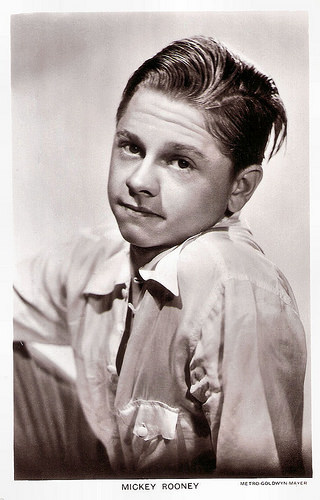
British postcard in the Picturegoer Series, London, no. 902a. Photo: Metro-Goldwyn-Mayer.
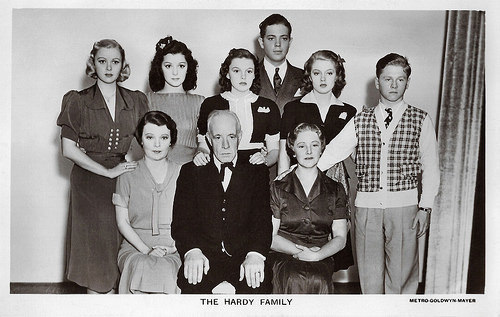
British postcard in the Picturegoer Series, London, no. 1280. Photo: Metro-Goldwyn-Mayer. Publicity still for Love Finds Andy Hardy (George B. Seitz, 1938) with (back row) Cecilia Parker, Ann Rutherford, Judy Garland, Gene Reynolds, Lana Turner and (front row) Mary Howard, Lewis Stone, Fay Holden and Mickey Rooney.

British postcard in the Picturegoer Series, London, no. 1281. Photo: Metro-Goldwyn-Mayer. Publicity still for Love Finds Andy Hardy (George B. Seitz, 1938) with Ann Rutherford, Judy Garland and Lana Turner.
The popular all-American teenager
Mickey Rooney was born Joe Yule Jr. in 1920 in Brooklyn, New York. He was the son of Scottish-born vaudevillian/actor Joe Yule and Missouri-born Nell Ruth (née Carter) Pankey. Mickey first took the stage in his parents vaudeville act at 17 months old, wearing a specially tailored tuxedo. His parents divorced in 1923, when Mickey was three years old.
In 1925 Mickey came to Hollywood to audition as one of Hal Roach's Rascals for the Our Gang series, but Mickey's mother declined over a dispute over salary. Mickey then made his first film appearance in the short silent comedy Not to Be Trusted (Tom Buckingham, 1926), when he was four years old.He played the character Mickey McGuire for the first time in the bubbly comedy Orchids and Ermine (Alfred Santell, 1927) with Colleen Moore. The following year, he played the lead in the first Mickey McGuire short film, Mickey's Circus (Albert Herman, 1927). It was in this popular film series that he took the stage name Mickey Rooney.
Rooney reached new heights with A Family Affair (George B. Seitz, 1937) with Lionel Barrymore, the film that introduced the country to Andy Hardy, the popular all-American teenager. This beloved character appeared in nearly 20 films and helped make Rooney the top star at the box office in 1939, 1940 and 1941.
Rooney also proved himself an excellent dramatic actor as a delinquent in Boys Town (Norman Taurog, 1938) starring Spencer Tracy as Father Edward Flanagan, an advocate of child rights. In 1938, Rooney was awarded a Juvenile Academy Award.
Teaming up with Judy Garland, Rooney also appeared in a string of musicals, including Babes in Arms (Busby Berkeley, 1939) the first teenager to be nominated for an Oscar for Best Actor in a leading role, Strike Up the Band (Busby Berkeley, 1940), Babes on Broadway (Busby Berkeley, 1941), and Girl Crazy (Norman Taurog, Busby Berkeley, 1943). He and Garland immediately became best of friends. He also appeared with Elizabeth Taylor in National Velvet (Clarence Brown, 1944).
During World War II, Mickey Rooney served 21 months in the U.S. Army, five of them with the Third Army of Gen. George S. Patton. He attained the rank of sergeant and won a Bronze Star, among other decorations. Rooney helped to entertain the troops and worked on the American Armed Forces Network.
He returned to Hollywood and starred in Love Laughs at Andy Hardy (Willis Goldbeck, 1946), did a remake of the James Cagney film The Crowd Roars (Howard Hawks, 1932) called Killer McCoy (Roy Rowland, 1947) and portrayed composer Lorenz Hart in the musical Words and Music (Norman Taurog, 1948).
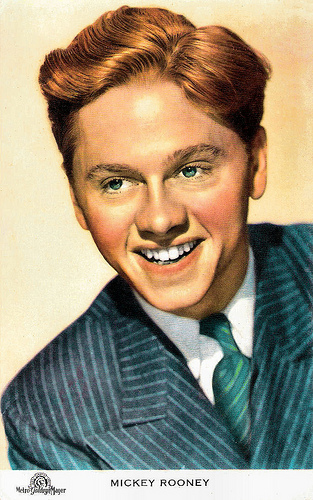
Belgian postcard by Victoria, Brussels, no. 639. Photo: Metro-Goldwyn-Mayer.
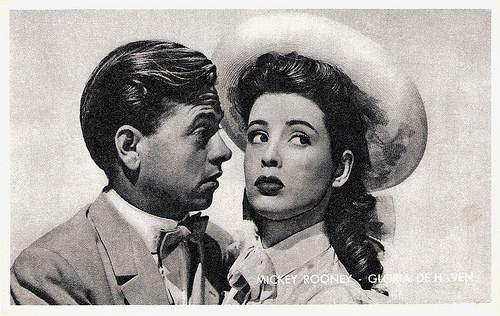
Belgian collector's card by Kwatta, Bois d'Haine, no. C. 172. Photo: MGM. Publicity still for Summer Holiday (Rouben Mamoulian, 1948) with Gloria DeHaven.
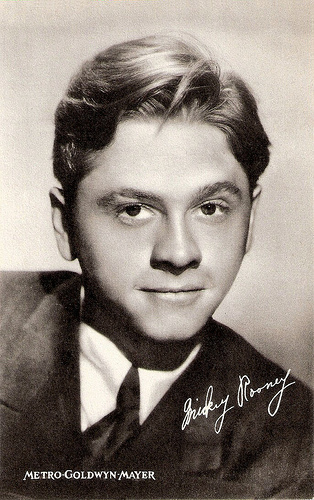
American postcard. Photo: MGM (Metro Goldwyn Mayer).
One of Hollywood's most enduring stars
Mickey Rooney appeared in Andy Hardy Comes Home (Howard W. Koch, 1958), together with his son Teddy Rooney portraying Andy Hardy Jr. Andy Hardy, now a grown man with a wife and children, returns to his hometown on a business trip and finds himself getting mixed up in local politics. In the late 1950s and early 1960s Rooney did a nightclub comedy act with comic Joey Forman.
He also appeared in Breakfast at Tiffany's (Blake Edwards, 1961), starring Audrey Hepburn and George Peppard. Rooney played Hepburn's Japanese neighbour, Mr. Yunioshi. A sign of the times, Rooney played the part for comic relief which he later regretted feeling the role was offensive. He once again showed his incredible range in the dramatic role of a boxing trainer with Anthony Quinn and Jackie Gleason in Requiem for a Heavyweight (Ralph Nelson, 1962). He followed it up with the comedy It's a Mad Mad Mad Mad World (Stanley Kramer, 1963), starring Spencer Tracey.
Rooney regularly worked in European productions, such as the Italian comedy L'arcidiavolo (Errore Scola, 1966) with Vittorio Gassman , British crime comedy Pulp (Mike Hodges, 1972) with Michael Caine , and the Spanish thriller Juego sucio en Panamá/Ace of Hearts (Tulio Demicheli, 1975).
In the late 1960s and 1970s Rooney showed audiences and critics alike why he was one of Hollywood's most enduring stars. He gave an impressive performance in Francis Ford Coppola's The Black Stallion (Carroll Ballard, 1979), which brought him an Academy Award nomination as Best Actor in a Supporting Role. He also turned to the stage in 1979 in Sugar Babies with Ann Miller, and was nominated for a Tony Award. During that time he also portrayed the Wizard in The Wonderful Wizard of Oz with Eartha Kitt at New York's Madison Square Garden, which also had a successful run nationally.
Rooney appeared in four television series: The Mickey Rooney Show (1954-1955), a comedy sit-com in 1964 with Sammee Tong called Mickey, One of the Boys (1982) with Dana Carvey and Nathan Lane, and The Adventures of Black Stallion (1990-1993). In 1981, Rooney won an Emmy Award for his portrayal of a mentally challenged man in Bill (Anthony Page, 1981). The critical acclaim continued to flow for the veteran performer, with Rooney receiving an honorary Academy Award.
Later, he also appeared in such films as Erik the Viking (Terry Jones, 1989) with Tim Robbins, Night at the Museum (Shawn Levy, 2006) with Ben Stiller and The Muppets (James Bobin, 2011) with Amy Adams.
Rooney's personal life, including his frequent trips to the altar, has proved to be just as epic as his on-screen performances. His first wife was one of the most beautiful women in Hollywood, actress Ava Gardner, but his final marriage to Jan Rooney was longer than those of all his other seven wives combined.
In 2012 when he permanently and legally separated from his eighth wife, Rooney chose to permanently reside with his stepson Mark Rooney and Mark's wife Charlene Rooney. They moved to the Hollywood Hills for him. After his death, his eight surviving children said in a statement that they were barred from seeing Rooney during his final years.
Mickey Rooney passed away in 2014 in North Hollywood, Los Angeles. The 93-years-old had at least three future projects that he was going to perform in. His acting career had lasted for 89 years and Rooney's 339 film credits span ten consecutive decades: 1920s-2010s. He is interred at Hollywood Forever Cemetery in Los Angeles, CA.
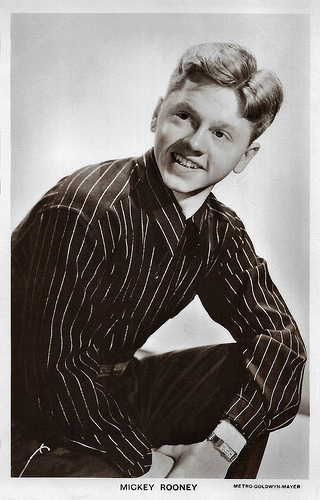
British postcard in the Picturegoer Series, London, no. 902c. Photo: Metro-Goldwyn-Mayer.
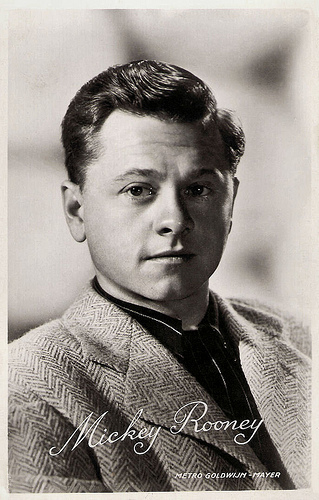
Dutch postcard by 't Sticht, Utrecht, no. 3201. Photo: MGM (Metro-Goldwyn-Mayer).
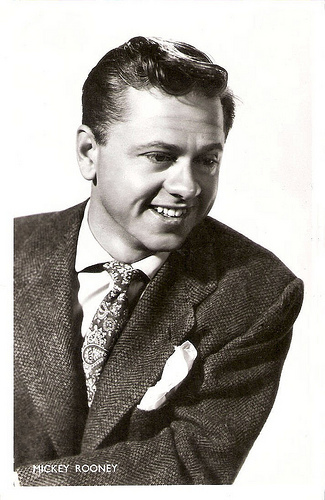
Dutch postcard by Uitgeverij J. Sleeding N.V., Amsterdam, no. S 94. Photo: MGM.
Sources: Wikipedia and .

British postcard in the Picturegoer Series, London, no. 902a. Photo: Metro-Goldwyn-Mayer.

British postcard in the Picturegoer Series, London, no. 1280. Photo: Metro-Goldwyn-Mayer. Publicity still for Love Finds Andy Hardy (George B. Seitz, 1938) with (back row) Cecilia Parker, Ann Rutherford, Judy Garland, Gene Reynolds, Lana Turner and (front row) Mary Howard, Lewis Stone, Fay Holden and Mickey Rooney.

British postcard in the Picturegoer Series, London, no. 1281. Photo: Metro-Goldwyn-Mayer. Publicity still for Love Finds Andy Hardy (George B. Seitz, 1938) with Ann Rutherford, Judy Garland and Lana Turner.
The popular all-American teenager
Mickey Rooney was born Joe Yule Jr. in 1920 in Brooklyn, New York. He was the son of Scottish-born vaudevillian/actor Joe Yule and Missouri-born Nell Ruth (née Carter) Pankey. Mickey first took the stage in his parents vaudeville act at 17 months old, wearing a specially tailored tuxedo. His parents divorced in 1923, when Mickey was three years old.
In 1925 Mickey came to Hollywood to audition as one of Hal Roach's Rascals for the Our Gang series, but Mickey's mother declined over a dispute over salary. Mickey then made his first film appearance in the short silent comedy Not to Be Trusted (Tom Buckingham, 1926), when he was four years old.He played the character Mickey McGuire for the first time in the bubbly comedy Orchids and Ermine (Alfred Santell, 1927) with Colleen Moore. The following year, he played the lead in the first Mickey McGuire short film, Mickey's Circus (Albert Herman, 1927). It was in this popular film series that he took the stage name Mickey Rooney.
Rooney reached new heights with A Family Affair (George B. Seitz, 1937) with Lionel Barrymore, the film that introduced the country to Andy Hardy, the popular all-American teenager. This beloved character appeared in nearly 20 films and helped make Rooney the top star at the box office in 1939, 1940 and 1941.
Rooney also proved himself an excellent dramatic actor as a delinquent in Boys Town (Norman Taurog, 1938) starring Spencer Tracy as Father Edward Flanagan, an advocate of child rights. In 1938, Rooney was awarded a Juvenile Academy Award.
Teaming up with Judy Garland, Rooney also appeared in a string of musicals, including Babes in Arms (Busby Berkeley, 1939) the first teenager to be nominated for an Oscar for Best Actor in a leading role, Strike Up the Band (Busby Berkeley, 1940), Babes on Broadway (Busby Berkeley, 1941), and Girl Crazy (Norman Taurog, Busby Berkeley, 1943). He and Garland immediately became best of friends. He also appeared with Elizabeth Taylor in National Velvet (Clarence Brown, 1944).
During World War II, Mickey Rooney served 21 months in the U.S. Army, five of them with the Third Army of Gen. George S. Patton. He attained the rank of sergeant and won a Bronze Star, among other decorations. Rooney helped to entertain the troops and worked on the American Armed Forces Network.
He returned to Hollywood and starred in Love Laughs at Andy Hardy (Willis Goldbeck, 1946), did a remake of the James Cagney film The Crowd Roars (Howard Hawks, 1932) called Killer McCoy (Roy Rowland, 1947) and portrayed composer Lorenz Hart in the musical Words and Music (Norman Taurog, 1948).

Belgian postcard by Victoria, Brussels, no. 639. Photo: Metro-Goldwyn-Mayer.

Belgian collector's card by Kwatta, Bois d'Haine, no. C. 172. Photo: MGM. Publicity still for Summer Holiday (Rouben Mamoulian, 1948) with Gloria DeHaven.

American postcard. Photo: MGM (Metro Goldwyn Mayer).
One of Hollywood's most enduring stars
Mickey Rooney appeared in Andy Hardy Comes Home (Howard W. Koch, 1958), together with his son Teddy Rooney portraying Andy Hardy Jr. Andy Hardy, now a grown man with a wife and children, returns to his hometown on a business trip and finds himself getting mixed up in local politics. In the late 1950s and early 1960s Rooney did a nightclub comedy act with comic Joey Forman.
He also appeared in Breakfast at Tiffany's (Blake Edwards, 1961), starring Audrey Hepburn and George Peppard. Rooney played Hepburn's Japanese neighbour, Mr. Yunioshi. A sign of the times, Rooney played the part for comic relief which he later regretted feeling the role was offensive. He once again showed his incredible range in the dramatic role of a boxing trainer with Anthony Quinn and Jackie Gleason in Requiem for a Heavyweight (Ralph Nelson, 1962). He followed it up with the comedy It's a Mad Mad Mad Mad World (Stanley Kramer, 1963), starring Spencer Tracey.
Rooney regularly worked in European productions, such as the Italian comedy L'arcidiavolo (Errore Scola, 1966) with Vittorio Gassman , British crime comedy Pulp (Mike Hodges, 1972) with Michael Caine , and the Spanish thriller Juego sucio en Panamá/Ace of Hearts (Tulio Demicheli, 1975).
In the late 1960s and 1970s Rooney showed audiences and critics alike why he was one of Hollywood's most enduring stars. He gave an impressive performance in Francis Ford Coppola's The Black Stallion (Carroll Ballard, 1979), which brought him an Academy Award nomination as Best Actor in a Supporting Role. He also turned to the stage in 1979 in Sugar Babies with Ann Miller, and was nominated for a Tony Award. During that time he also portrayed the Wizard in The Wonderful Wizard of Oz with Eartha Kitt at New York's Madison Square Garden, which also had a successful run nationally.
Rooney appeared in four television series: The Mickey Rooney Show (1954-1955), a comedy sit-com in 1964 with Sammee Tong called Mickey, One of the Boys (1982) with Dana Carvey and Nathan Lane, and The Adventures of Black Stallion (1990-1993). In 1981, Rooney won an Emmy Award for his portrayal of a mentally challenged man in Bill (Anthony Page, 1981). The critical acclaim continued to flow for the veteran performer, with Rooney receiving an honorary Academy Award.
Later, he also appeared in such films as Erik the Viking (Terry Jones, 1989) with Tim Robbins, Night at the Museum (Shawn Levy, 2006) with Ben Stiller and The Muppets (James Bobin, 2011) with Amy Adams.
Rooney's personal life, including his frequent trips to the altar, has proved to be just as epic as his on-screen performances. His first wife was one of the most beautiful women in Hollywood, actress Ava Gardner, but his final marriage to Jan Rooney was longer than those of all his other seven wives combined.
In 2012 when he permanently and legally separated from his eighth wife, Rooney chose to permanently reside with his stepson Mark Rooney and Mark's wife Charlene Rooney. They moved to the Hollywood Hills for him. After his death, his eight surviving children said in a statement that they were barred from seeing Rooney during his final years.
Mickey Rooney passed away in 2014 in North Hollywood, Los Angeles. The 93-years-old had at least three future projects that he was going to perform in. His acting career had lasted for 89 years and Rooney's 339 film credits span ten consecutive decades: 1920s-2010s. He is interred at Hollywood Forever Cemetery in Los Angeles, CA.

British postcard in the Picturegoer Series, London, no. 902c. Photo: Metro-Goldwyn-Mayer.

Dutch postcard by 't Sticht, Utrecht, no. 3201. Photo: MGM (Metro-Goldwyn-Mayer).

Dutch postcard by Uitgeverij J. Sleeding N.V., Amsterdam, no. S 94. Photo: MGM.
Sources: Wikipedia and .
Published on December 06, 2018 22:00
December 5, 2018
The Ten Commandments (1956)
The Ten Commandments (1956) was director and producer DeMille's last and most successful film, a partial remake of his 1923 silent film of the same title. It was filmed on location in Egypt, Mount Sinai and the Sinai Peninsula, shot in VistaVision with colour by Technicolor. The film dramatises the biblical story of the life of Moses, an adopted Egyptian prince who becomes the deliverer of his real brethren, the enslaved Hebrews, and therefore leads the Exodus to Mount Sinai, where he receives, from God, the Ten Commandments. Charlton Heston played Moses, Yul Brynner played his jealous half-brother Rameses II, and Anne Baxter the Egyptian throne princess Nefretiri.
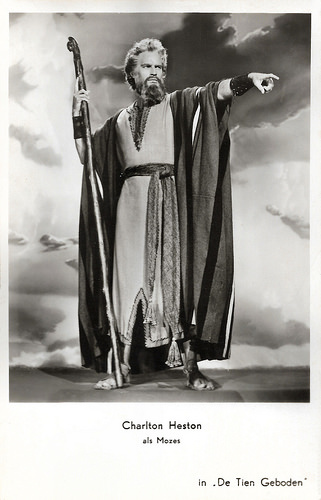
Dutch postcard by Gebr. Spanjersberg N.V., Rotterdam, no. 5183. Photo: Paramount. Publicity still for The Ten Commandments (Cecil B. DeMille, 1956) with Charlton Heston as Moses. Moses' robe was hand-woven by Dorothea Hulse, one of the world's finest weavers. She also created costumes for The Robe (Henry Koster, 1953), as well as textiles and costume fabrics for Samson and Delilah (Cecil B. DeMille, 1949), David and Bathsheba (Henry King, 1951), and other films.
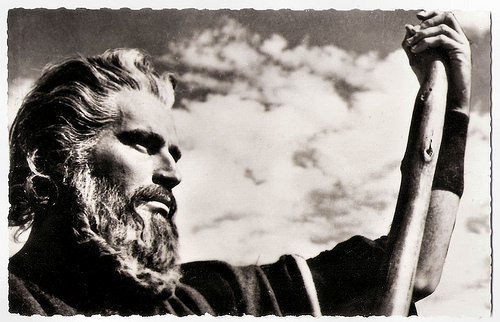
French postcard by Editions P.I., Paris, no. 830. Offered by Les Carbones Korès "Carboplane". Photo: Paramount. Publicity still for The Ten Commandments (Cecil B. DeMille, 1956).
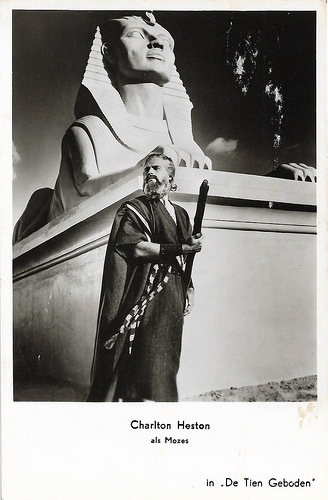
Dutch postcard by Gebr. Spanjersberg N.V., Rotterdam, no. 5185. Photo: Charlton Heston as Moses in The Ten Commandments (Cecil B. DeMille, 1956), released in Dutch as De Tien Geboden.
Put on Earth to do God’s will
Based on the Holy Scriptures, with additional dialogue by several other hands, The Ten Commandments (Cecil B. DeMille, 1956) tells the story of Moses, leader of the Hebrews, considered to have been a prophet by Jews, Christians and Muslims. He is thought to have lived in Egypt, in or around the 14th century BC.
The older he became, the more Cecil B. DeMille was convinced that he had been put on Earth to do God’s will. He decided to remake The Ten Commandments, in response, he claimed, to scores of imploring letters: “The world needs a reminder, they said, of the Law of God.”
Charlton Heston, who had previously worked with DeMille in The Greatest Show on Earth (Cecil B. DeMille, 1952), won the part of Moses after he impressed DeMille at his audition with his knowledge of ancient Egypt.
The films follows Moses from the time he was discovered in the bull rushes as an infant by the Pharaoh's daughter, to his long, hard struggle to free the Hebrews from their slavery at the hands of the Egyptians.
Heston was also chosen to be the voice of God in the form of a burning bush, toned down to a softer and lower register. As soon as Heston announced to DeMille that his wife Lydia was pregnant, Heston's newborn son, Fraser (1955), was cast by DeMille. Fraser Heston was three months old during filming.
Edward G. Robinson was cast as Dathan, Yvonne De Carlo as Sephora, Debra Paget as Lilia, and John Derek as Joshua. The film features Sir Cedric Hardwicke as Sethi, Nina Foch as Bithiah, Martha Scott as Yoshebel, Judith Anderson as Memnet, and Vincent Price as Baka.
For the large crowd shots, at least 14,000 extras and 15,000 animals were used.
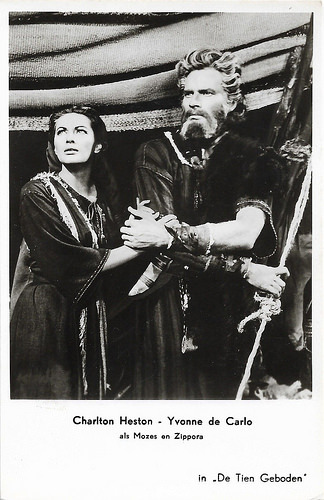
Dutch postcard by Gebr. Spanjersberg N.V., Rotterdam, no. 5184. Photo: Charlton Heston and Yvonne de Carlo in The Ten Commandments (Cecil B. deMille, 1956), released in Dutch as De Tien Geboden.
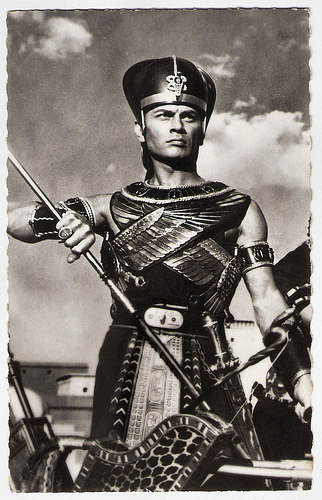
French postcard by Editions P.I., Paris, no. 831. Photo: Paramount. Publicity still for The Ten Commandments (Cecil B. DeMille, 1956). For his pursuit of the Israelites, Yul Brynner in his role as Rameses II wears the blue Khepresh helmet-crown, which the pharaohs wore for battle.
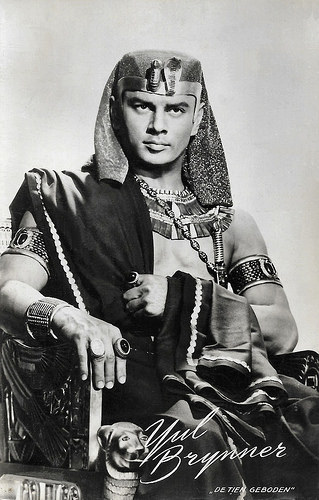
Dutch postcard by Uitg. Takken, no. AX 3871. Photo: Paramount. Publicity still for The Ten Commandments (Cecil B. DeMille, 1956).
The most eventful 219 minutes ever recorded
In 1957, The Ten Commandments was nominated for seven Oscars, including Best Picture. John P. Fulton, head of the special effects department at Paramount, won the Academy Award for his effects. Fulton’s effects included the building of Sethi’s Jubilee treasure city, the Burning Bush, the fiery hail from a cloudless sky, the Angel of Death, the composites of the Exodus, the Pillar of Fire, the giving of the Ten Commandments, and the highlight, the parting of the Red Sea.
The at the time incredibly expensive production (budget: $13 million) grossed $122.7 million at the box office. It was re-released in 1966 and 1972, and one more time in 1989. The liberties taken with the biblical story of Exodus nor its nearly four-hour length has had any effect on its popularity. According to Guinness World Records, in terms of theatrical exhibition The Ten Commandments (1956) is the seventh most successful film of all-time when the box office gross is adjusted for inflation.
During production, DeMille had customarily spread out prints of paintings by Lawrence Alma-Tadema to inform his set designers on the look he wanted to achieve. However, in terms of accuracy about Moses and his time, The Ten Commandments is patchy.
Alex von Tunzelmann in The Guardian: “It's amazing how much the fashions of New Kingdom Egypt seem to resemble those of 1956. DeMille can just about be forgiven the makeup, because ancient Egyptians did indeed paint their eyelids, lips and nails, but he is pushing it by dressing dancing girls in fluorescent green bikinis. At least the spectacular scenes filmed on location in Egypt and Sinai, with thousands of extras, lend the whole thing a sense of authenticity.”
Hal Erickson at AllMovie : “DeMille's The Ten Commandments may not be the most subtle and sophisticated entertainment ever concocted, but it tells its story with a clarity and vitality that few Biblical scholars have ever been able to duplicate. It is very likely the most eventful 219 minutes ever recorded to film - and who's to say that Nefertiri (Anne Baxter) didn't make speeches like, "Oh, Moses, Moses, you splendid, stubborn, adorable fool"?”
During the production in Egypt, Cecil B. DeMille had a colossal heart attack. The doctor insisted that he spend the next two weeks flat on his back in an oxygen tent, then recuperate for several weeks after that. Typically, DeMille took no notice and was back at work the next morning.
He finished filming The Ten Commandments on the day after his 74th birthday. But although he lived for another five years, his health never recovered. On 20 January 1959 his doctor paid him a visit and suggested he should go straight into hospital. “No,” DeMille told him. “I think I’ll go to the morgue instead.” He died the next day.
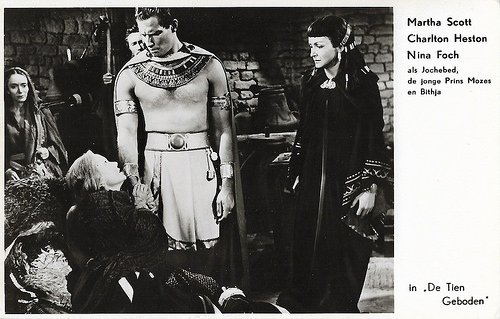
Dutch postcard by Gebr. Spanjersberg N.V., Rotterdam, no. 5193. Photo: Charlton Heston, Nina Foch, and Martha Scott in The Ten Commandments (Cecil B. DeMille, 1956), released in Dutch as De Tien Geboden.
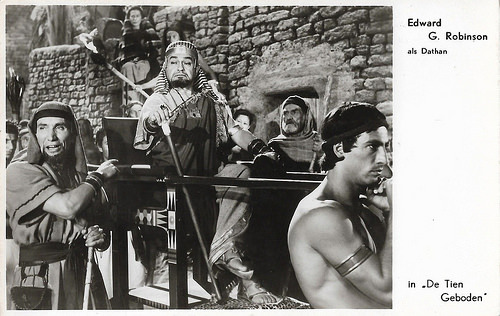
Dutch postcard by Gebr. Spanjersberg N.V., Rotterdam, no. 5187. Photo: Edward G. Robinson as Dathan in The Ten Commandments (Cecil B. DeMille, 1956), released in Dutch as De Tien Geboden.
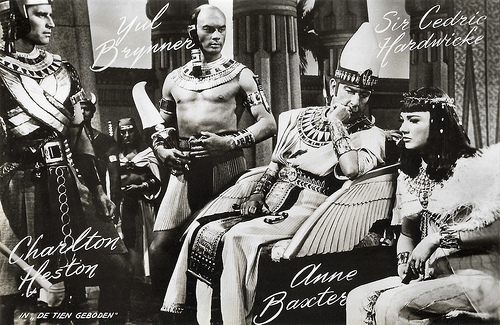
Dutch postcard by Uitg. Takken, no. AX 3881. Photo: Paramount. Publicity still for The Ten Commandments (Cecil B. DeMille, 1956) with Charlton Heston, Yul Brynner , Sir Cedric Hardwicke and Anne Baxter.
Trailer The Ten Commandments (1956). Source: You Tube Trailers (YouTube).
Sources: Hal Erickson (AllMovie), John Preston (The Telegraph), Alex von Tunzelmann (The Guardian), Wikipedia, and IMDb.

Dutch postcard by Gebr. Spanjersberg N.V., Rotterdam, no. 5183. Photo: Paramount. Publicity still for The Ten Commandments (Cecil B. DeMille, 1956) with Charlton Heston as Moses. Moses' robe was hand-woven by Dorothea Hulse, one of the world's finest weavers. She also created costumes for The Robe (Henry Koster, 1953), as well as textiles and costume fabrics for Samson and Delilah (Cecil B. DeMille, 1949), David and Bathsheba (Henry King, 1951), and other films.

French postcard by Editions P.I., Paris, no. 830. Offered by Les Carbones Korès "Carboplane". Photo: Paramount. Publicity still for The Ten Commandments (Cecil B. DeMille, 1956).

Dutch postcard by Gebr. Spanjersberg N.V., Rotterdam, no. 5185. Photo: Charlton Heston as Moses in The Ten Commandments (Cecil B. DeMille, 1956), released in Dutch as De Tien Geboden.
Put on Earth to do God’s will
Based on the Holy Scriptures, with additional dialogue by several other hands, The Ten Commandments (Cecil B. DeMille, 1956) tells the story of Moses, leader of the Hebrews, considered to have been a prophet by Jews, Christians and Muslims. He is thought to have lived in Egypt, in or around the 14th century BC.
The older he became, the more Cecil B. DeMille was convinced that he had been put on Earth to do God’s will. He decided to remake The Ten Commandments, in response, he claimed, to scores of imploring letters: “The world needs a reminder, they said, of the Law of God.”
Charlton Heston, who had previously worked with DeMille in The Greatest Show on Earth (Cecil B. DeMille, 1952), won the part of Moses after he impressed DeMille at his audition with his knowledge of ancient Egypt.
The films follows Moses from the time he was discovered in the bull rushes as an infant by the Pharaoh's daughter, to his long, hard struggle to free the Hebrews from their slavery at the hands of the Egyptians.
Heston was also chosen to be the voice of God in the form of a burning bush, toned down to a softer and lower register. As soon as Heston announced to DeMille that his wife Lydia was pregnant, Heston's newborn son, Fraser (1955), was cast by DeMille. Fraser Heston was three months old during filming.
Edward G. Robinson was cast as Dathan, Yvonne De Carlo as Sephora, Debra Paget as Lilia, and John Derek as Joshua. The film features Sir Cedric Hardwicke as Sethi, Nina Foch as Bithiah, Martha Scott as Yoshebel, Judith Anderson as Memnet, and Vincent Price as Baka.
For the large crowd shots, at least 14,000 extras and 15,000 animals were used.

Dutch postcard by Gebr. Spanjersberg N.V., Rotterdam, no. 5184. Photo: Charlton Heston and Yvonne de Carlo in The Ten Commandments (Cecil B. deMille, 1956), released in Dutch as De Tien Geboden.

French postcard by Editions P.I., Paris, no. 831. Photo: Paramount. Publicity still for The Ten Commandments (Cecil B. DeMille, 1956). For his pursuit of the Israelites, Yul Brynner in his role as Rameses II wears the blue Khepresh helmet-crown, which the pharaohs wore for battle.

Dutch postcard by Uitg. Takken, no. AX 3871. Photo: Paramount. Publicity still for The Ten Commandments (Cecil B. DeMille, 1956).
The most eventful 219 minutes ever recorded
In 1957, The Ten Commandments was nominated for seven Oscars, including Best Picture. John P. Fulton, head of the special effects department at Paramount, won the Academy Award for his effects. Fulton’s effects included the building of Sethi’s Jubilee treasure city, the Burning Bush, the fiery hail from a cloudless sky, the Angel of Death, the composites of the Exodus, the Pillar of Fire, the giving of the Ten Commandments, and the highlight, the parting of the Red Sea.
The at the time incredibly expensive production (budget: $13 million) grossed $122.7 million at the box office. It was re-released in 1966 and 1972, and one more time in 1989. The liberties taken with the biblical story of Exodus nor its nearly four-hour length has had any effect on its popularity. According to Guinness World Records, in terms of theatrical exhibition The Ten Commandments (1956) is the seventh most successful film of all-time when the box office gross is adjusted for inflation.
During production, DeMille had customarily spread out prints of paintings by Lawrence Alma-Tadema to inform his set designers on the look he wanted to achieve. However, in terms of accuracy about Moses and his time, The Ten Commandments is patchy.
Alex von Tunzelmann in The Guardian: “It's amazing how much the fashions of New Kingdom Egypt seem to resemble those of 1956. DeMille can just about be forgiven the makeup, because ancient Egyptians did indeed paint their eyelids, lips and nails, but he is pushing it by dressing dancing girls in fluorescent green bikinis. At least the spectacular scenes filmed on location in Egypt and Sinai, with thousands of extras, lend the whole thing a sense of authenticity.”
Hal Erickson at AllMovie : “DeMille's The Ten Commandments may not be the most subtle and sophisticated entertainment ever concocted, but it tells its story with a clarity and vitality that few Biblical scholars have ever been able to duplicate. It is very likely the most eventful 219 minutes ever recorded to film - and who's to say that Nefertiri (Anne Baxter) didn't make speeches like, "Oh, Moses, Moses, you splendid, stubborn, adorable fool"?”
During the production in Egypt, Cecil B. DeMille had a colossal heart attack. The doctor insisted that he spend the next two weeks flat on his back in an oxygen tent, then recuperate for several weeks after that. Typically, DeMille took no notice and was back at work the next morning.
He finished filming The Ten Commandments on the day after his 74th birthday. But although he lived for another five years, his health never recovered. On 20 January 1959 his doctor paid him a visit and suggested he should go straight into hospital. “No,” DeMille told him. “I think I’ll go to the morgue instead.” He died the next day.

Dutch postcard by Gebr. Spanjersberg N.V., Rotterdam, no. 5193. Photo: Charlton Heston, Nina Foch, and Martha Scott in The Ten Commandments (Cecil B. DeMille, 1956), released in Dutch as De Tien Geboden.

Dutch postcard by Gebr. Spanjersberg N.V., Rotterdam, no. 5187. Photo: Edward G. Robinson as Dathan in The Ten Commandments (Cecil B. DeMille, 1956), released in Dutch as De Tien Geboden.

Dutch postcard by Uitg. Takken, no. AX 3881. Photo: Paramount. Publicity still for The Ten Commandments (Cecil B. DeMille, 1956) with Charlton Heston, Yul Brynner , Sir Cedric Hardwicke and Anne Baxter.
Trailer The Ten Commandments (1956). Source: You Tube Trailers (YouTube).
Sources: Hal Erickson (AllMovie), John Preston (The Telegraph), Alex von Tunzelmann (The Guardian), Wikipedia, and IMDb.
Published on December 05, 2018 22:00
Paul van Yperen's Blog
- Paul van Yperen's profile
- 13 followers
Paul van Yperen isn't a Goodreads Author
(yet),
but they
do have a blog,
so here are some recent posts imported from
their feed.



